Have you ever thought about taking a Galapagos cruise? Like probably many people, we have dreamed of visiting the Galapagos all our lives. We love nature and animals. Additionally, we had heard that the animals of the Galapagos have no fear of humans, so this increased our desire to visit. The Galapagos is one of the most biodiverse places on the planet and home to an incredible array of wildlife that exist nowhere else.
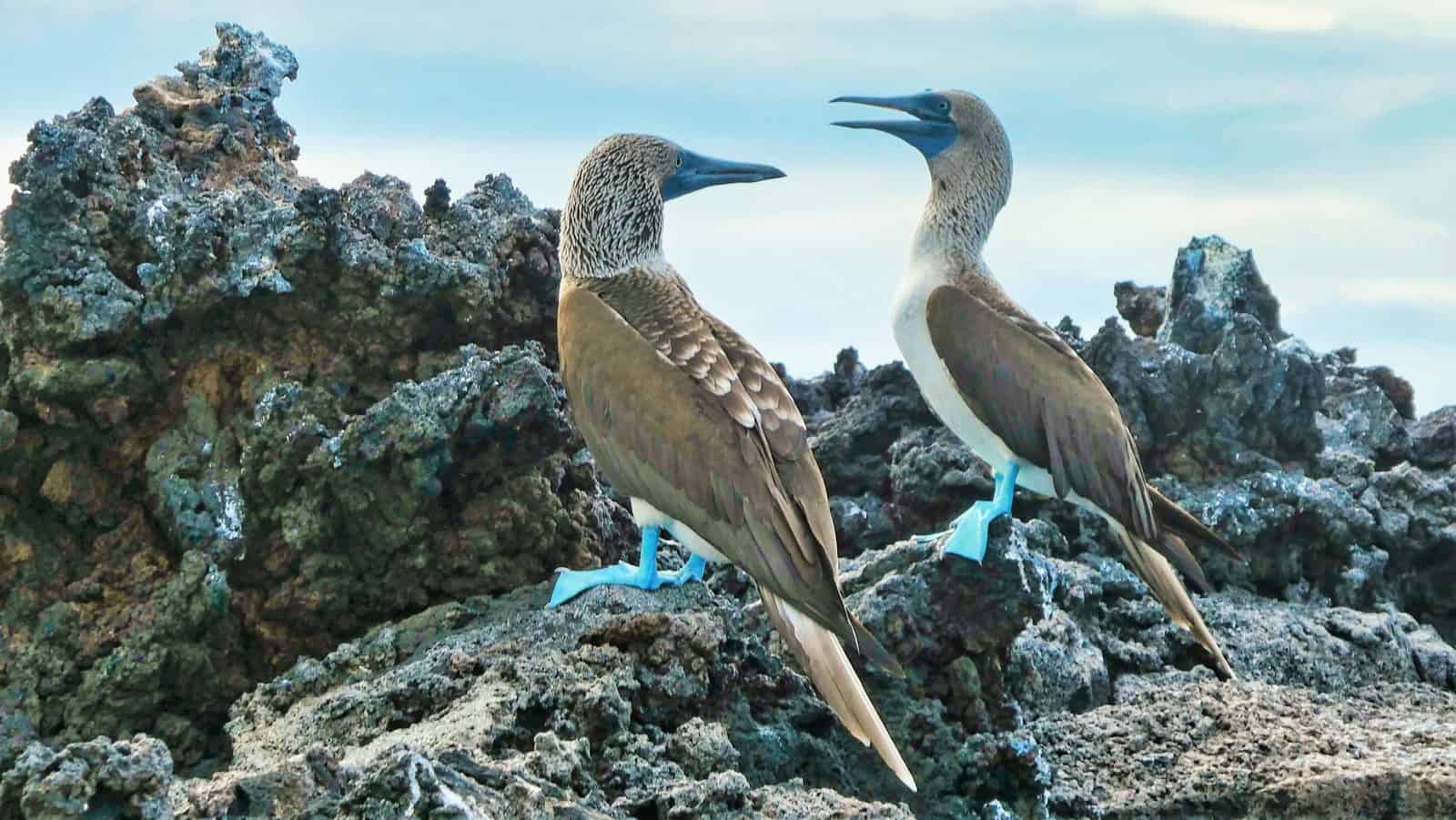
Keith and I have lived in Ecuador for four years and had not visited the Ecuadorian islands of the Galapagos. That is until now. The Galapagos Islands are only 621 miles from mainland Ecuador. After considerable research, we decided to do a Galapagos cruise. We will tell you why we picked a cruise over a land tour later.
We Choose a Galapagos Cruise on the M/C Alya
We chose a cruise with Galagents Galapagos Cruises on their luxury catamaran, the M/C Alya. Thus, the M/C Alya is a nine-cabin catamaran with classy common areas, onboard activities, and a friendly crew. The owners of Galagents Galapagos Cruises are from the Galapagos, and their goal is to showcase their paradise to the rest of the world through the creation of unforgettable experiences for passengers. Likewise, they adhere to the most demanding quality and environmental conservation requirements anywhere in the world.
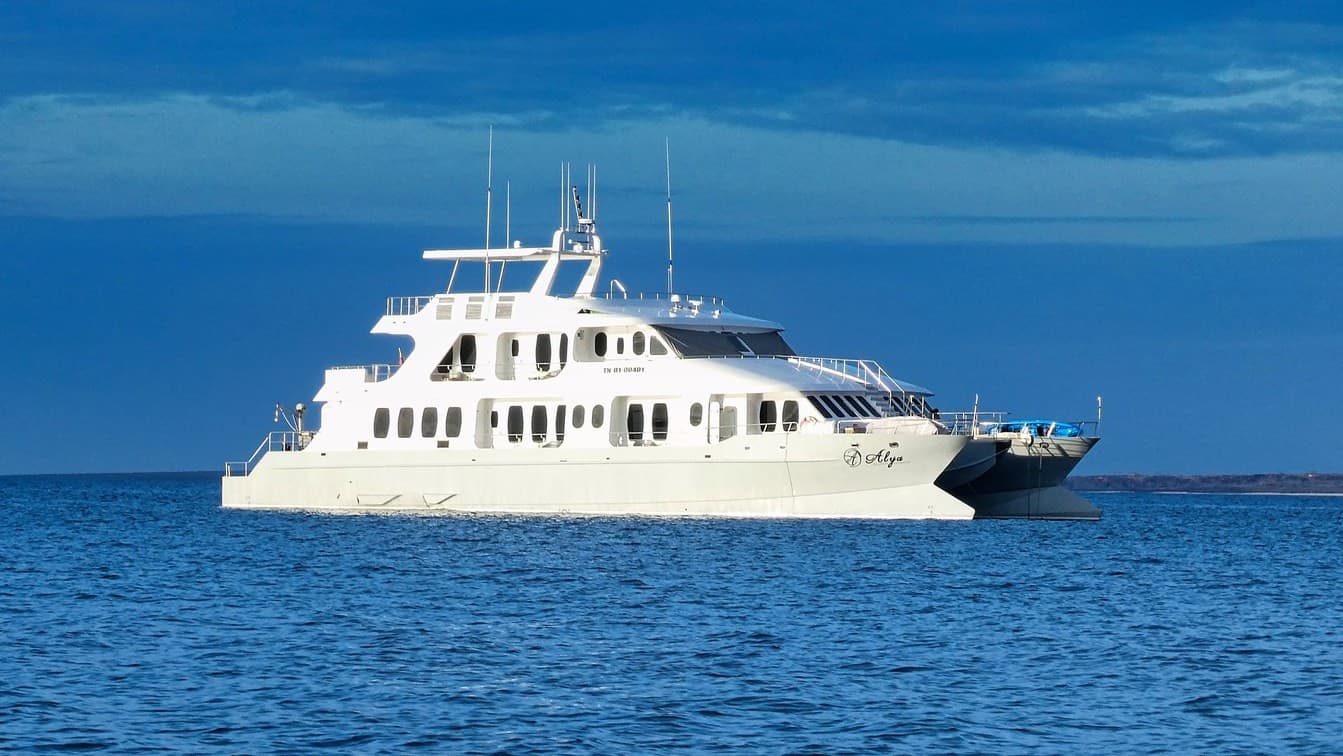
Our air-conditioned cabin had a king-size bed (twin option also available), large shower, and a private balcony, perfect for watching nature both at sea and while anchored.
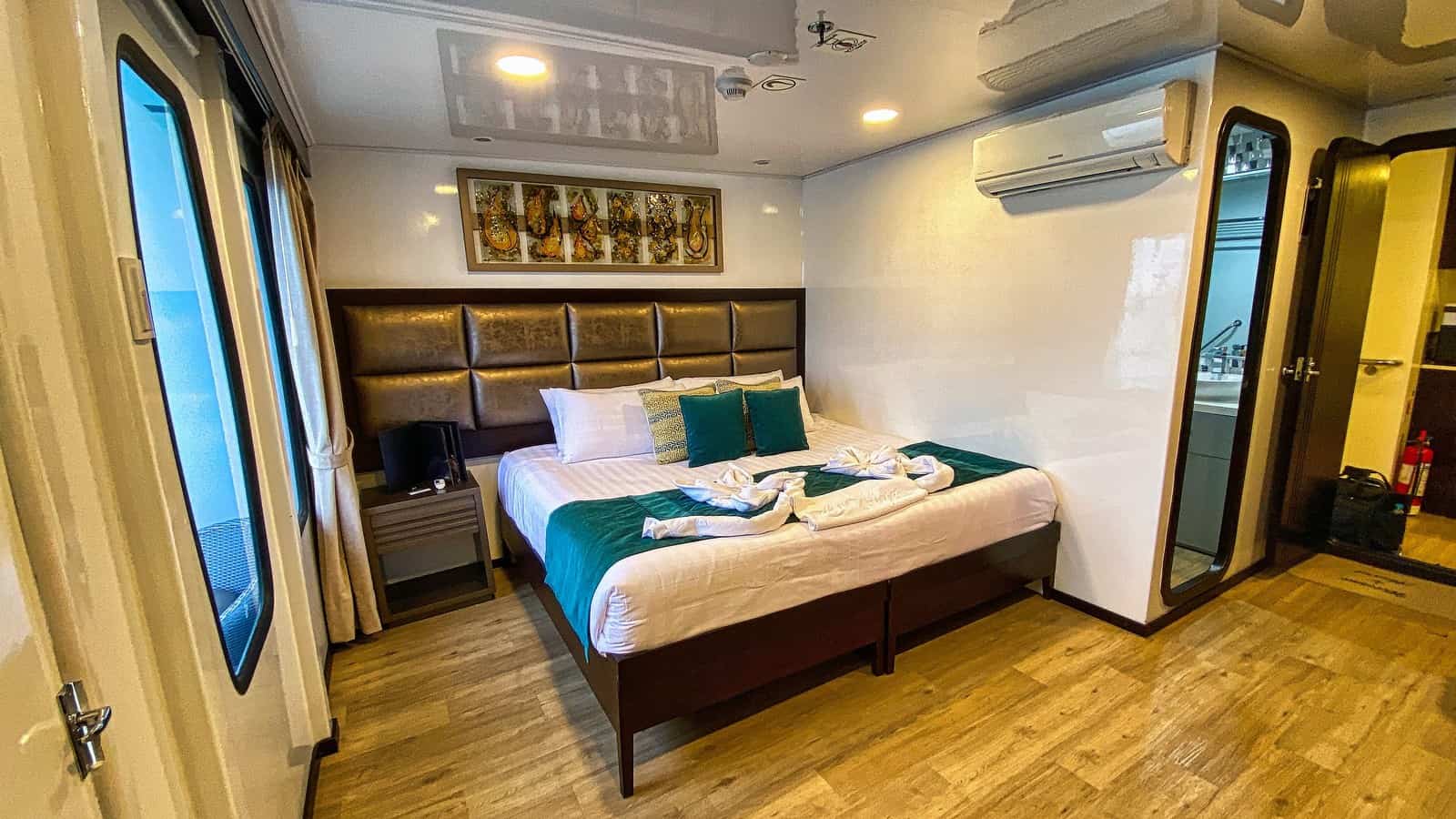
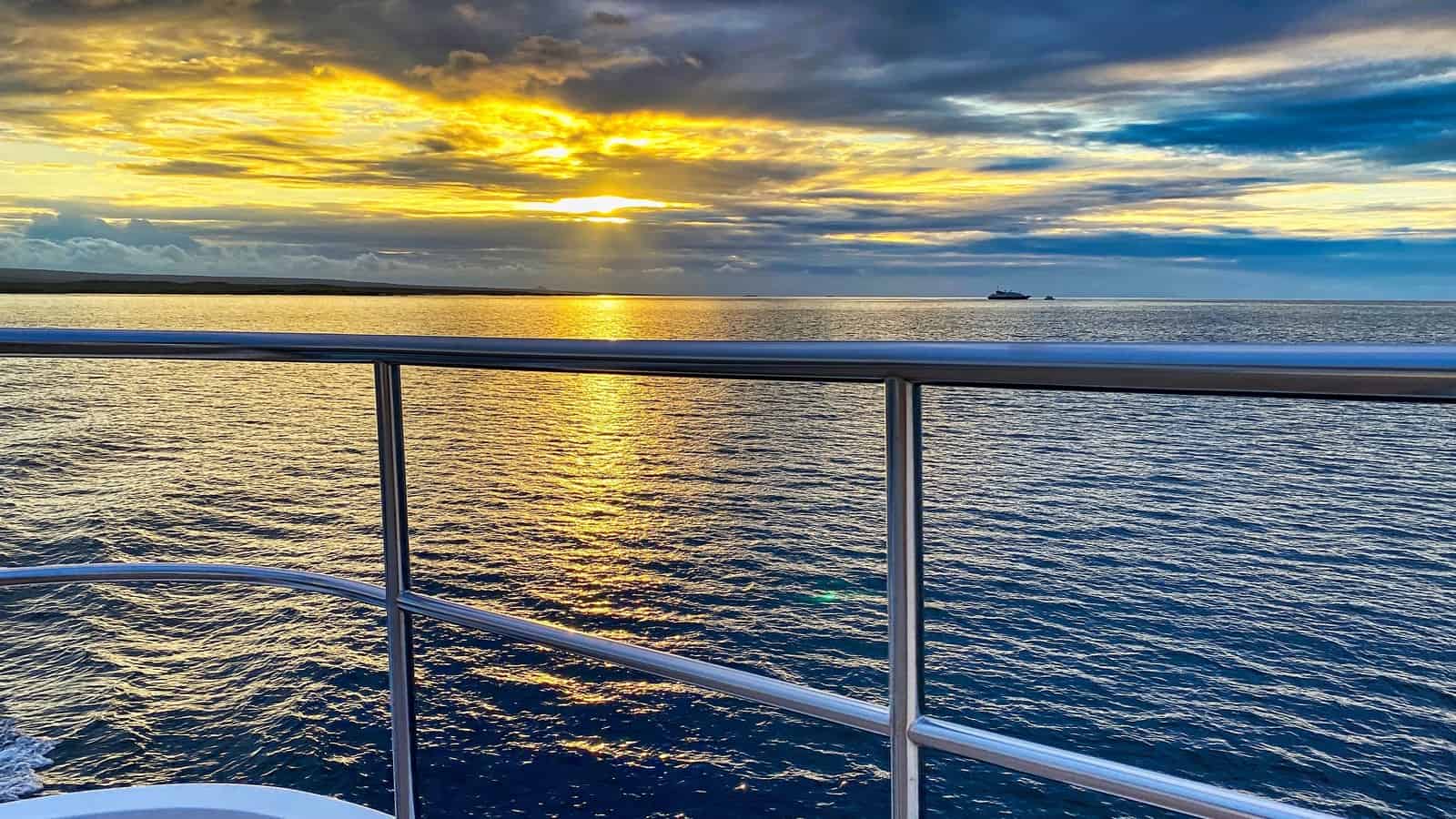
We loved the M/C Alya dining room because the design is great for socializing. Plus, there are two well-stocked bars.
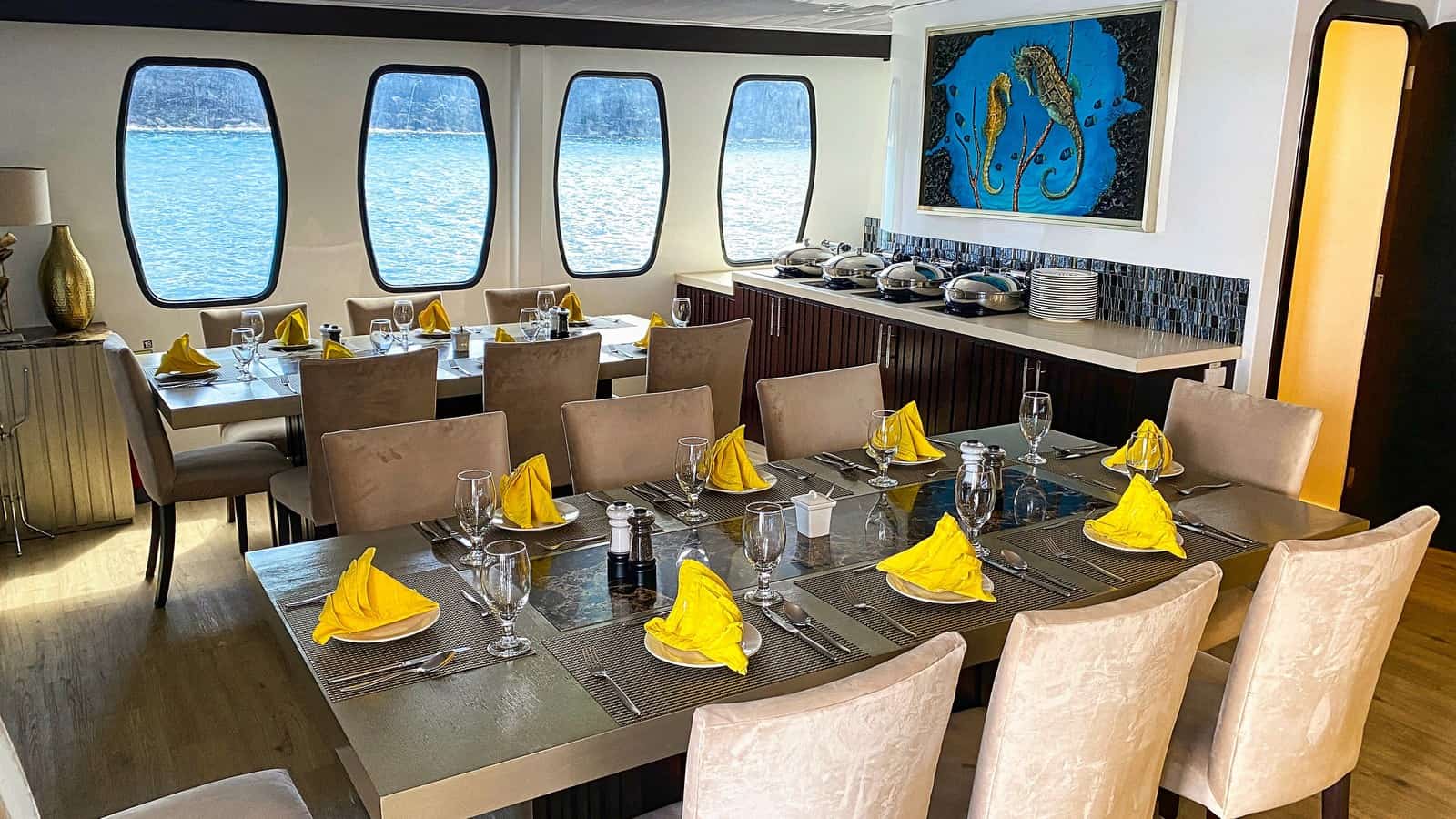
The top deck of the M/C Alya has a sundeck complete with a Jacuzzi. It was a great place to enjoy a glass of wine. Lastly, the M/C Alya has two Zodiak’s or pangas as they are called in the Galapagos so you can get up close to nature.
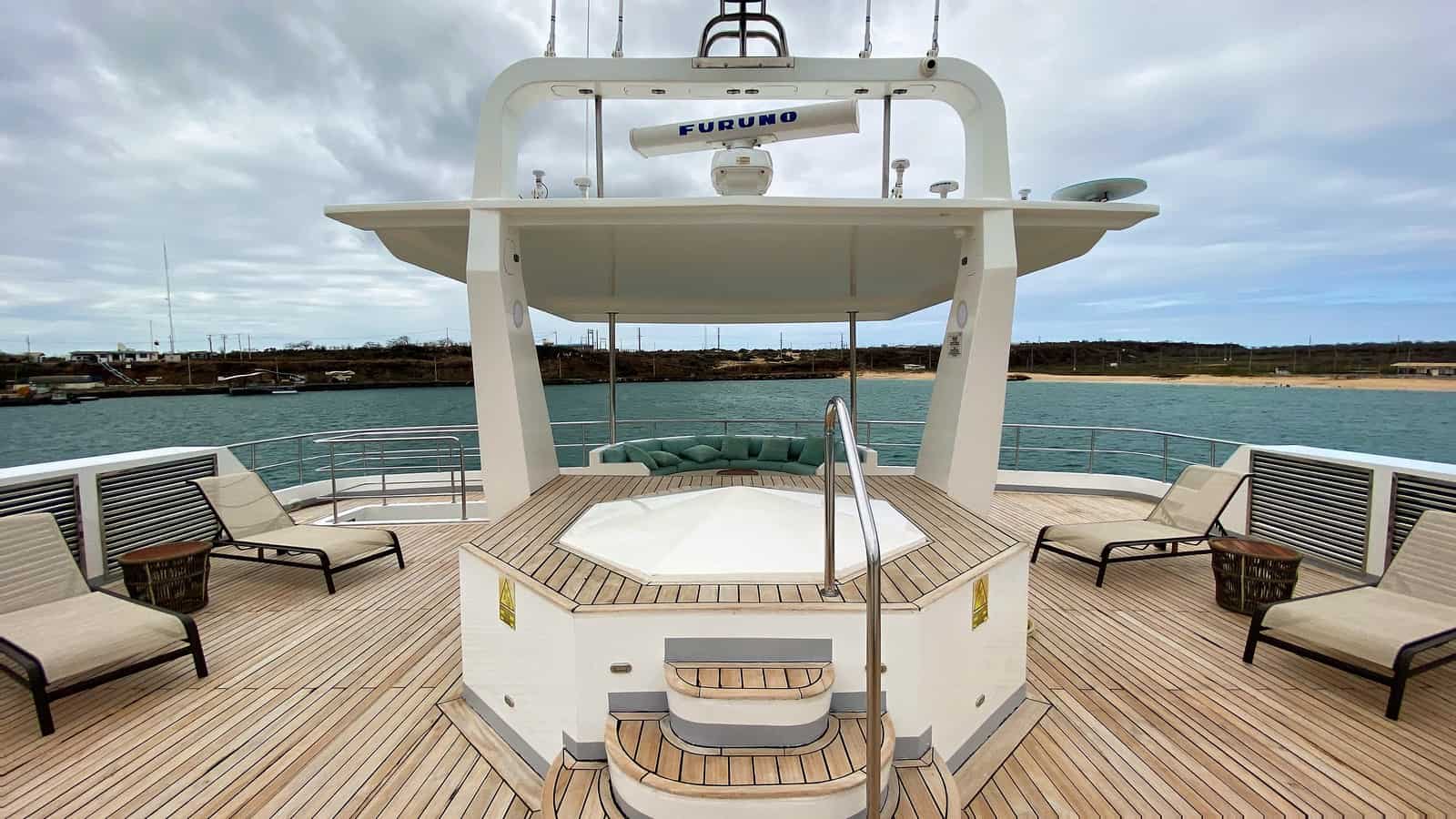
Most Important, our cruise had a certified Galapagos naturalist guide on board, providing us with educational information and tips for the best wildlife viewing.
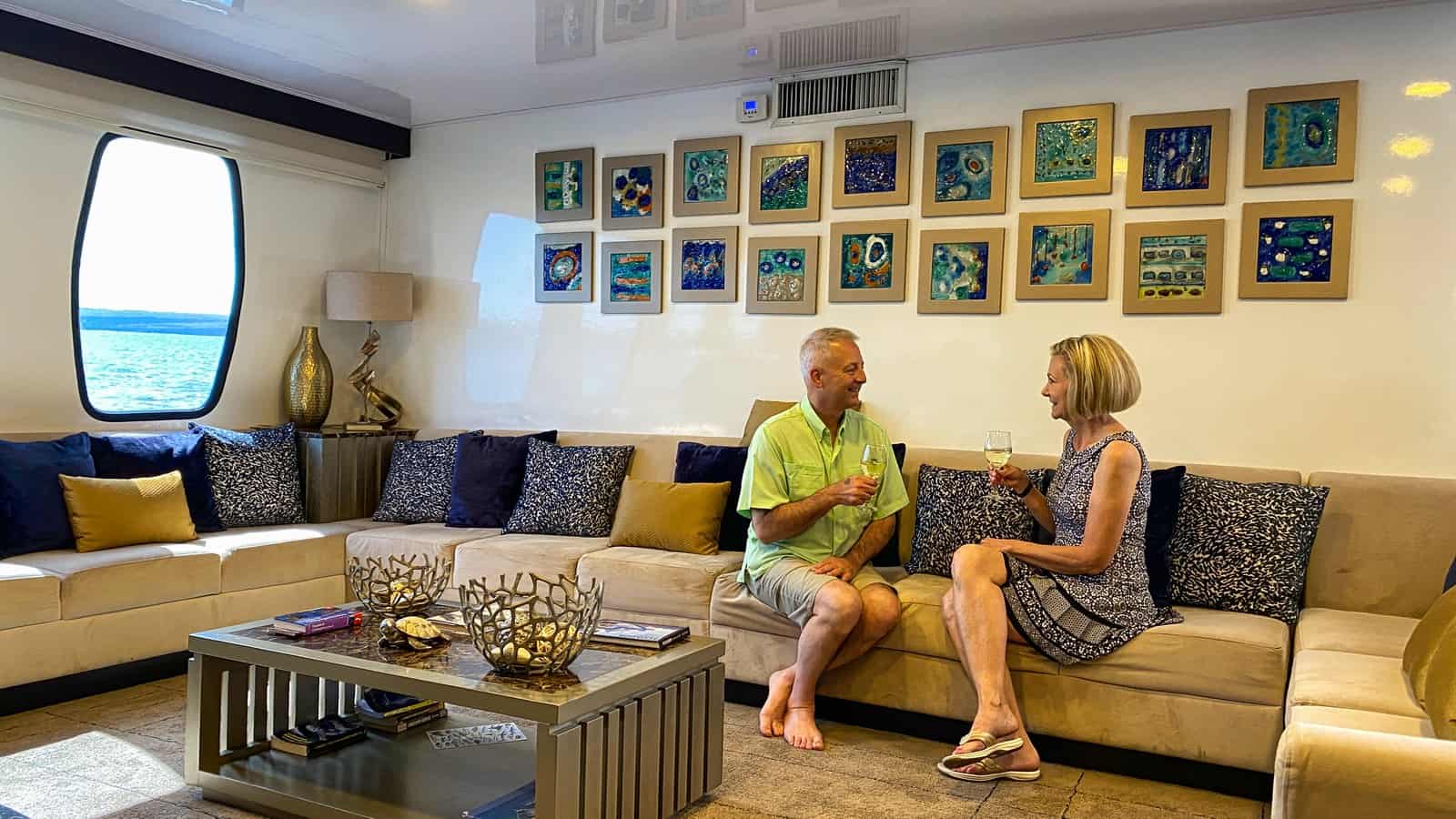
These cruise ships are not like the big thousand plus passenger ships you may have been on before. These are smaller and more intimate. The crew knows your name and works hard to make your trip the best. These guys and gals work six weeks straight and then get four weeks off. Most of which actually live on the Galapagos Islands.
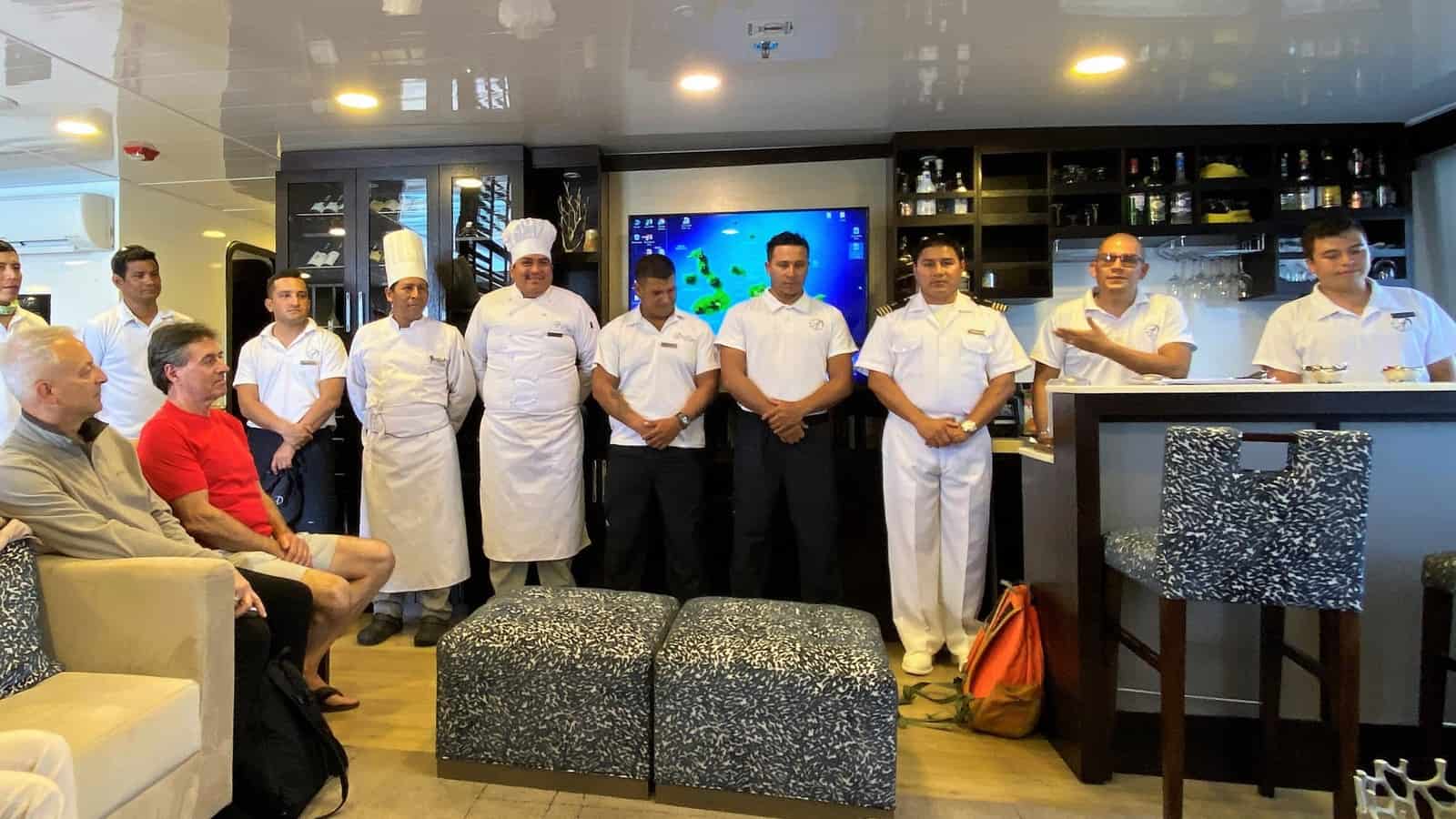
The Adventure Begins
On the first day of our Galapagos cruise, we landed at the Baltra Airport. Our naturalist guide was at the airport to greet and travel with us to our ship. After clearing immigration, which everyone must do, even Ecuadorian residents like us, we boarded a bus for a short ride to the coast.
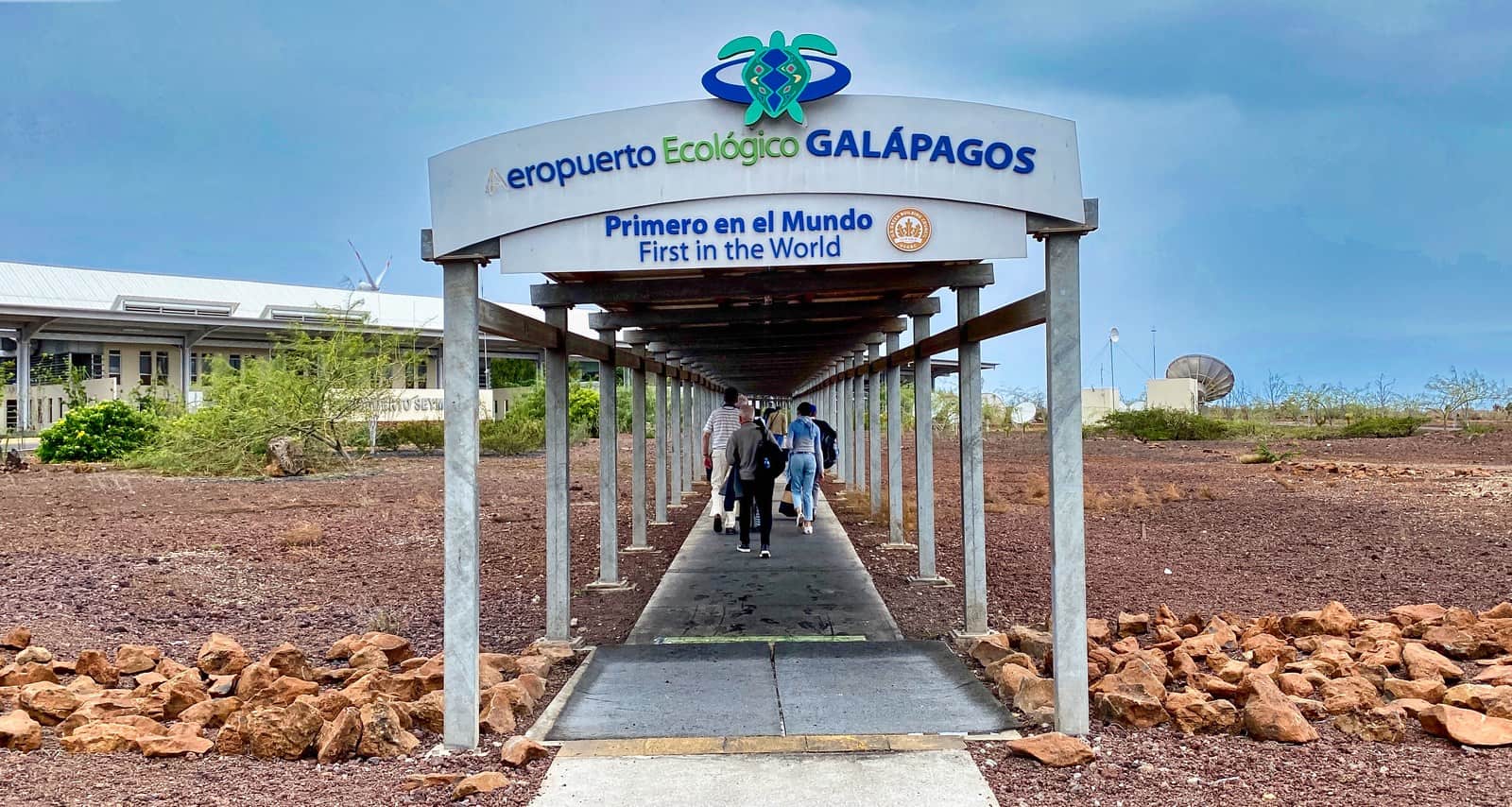
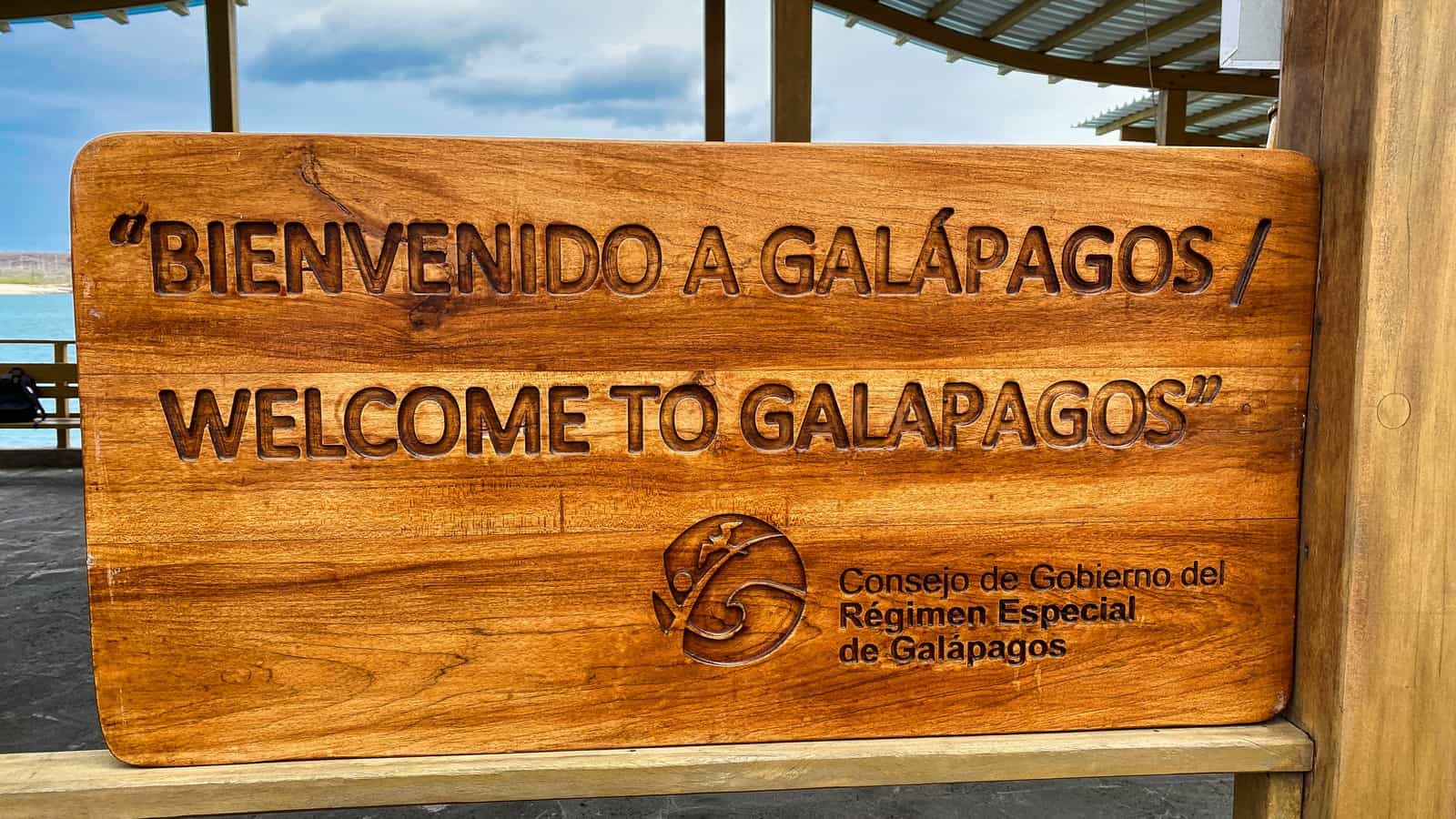
At the docks, we boarded a panga for another short ride to the ship. The crew and lunch were waiting for us. What was nice was that we never had to handle our luggage. The M/C Alya took it from the bus to the panga and then onto the ship. So our luggage was waiting for us in our room when we arrived.
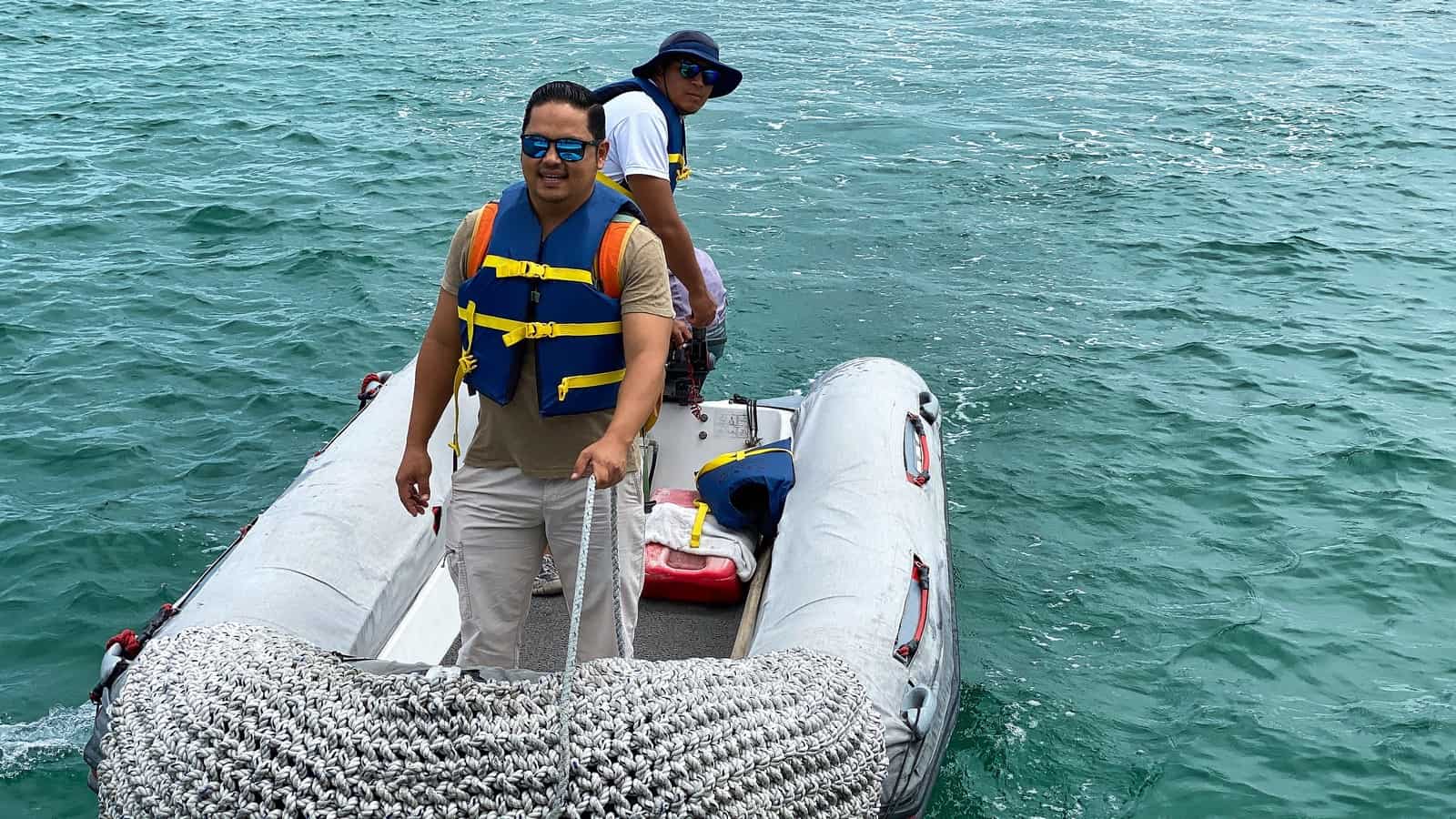
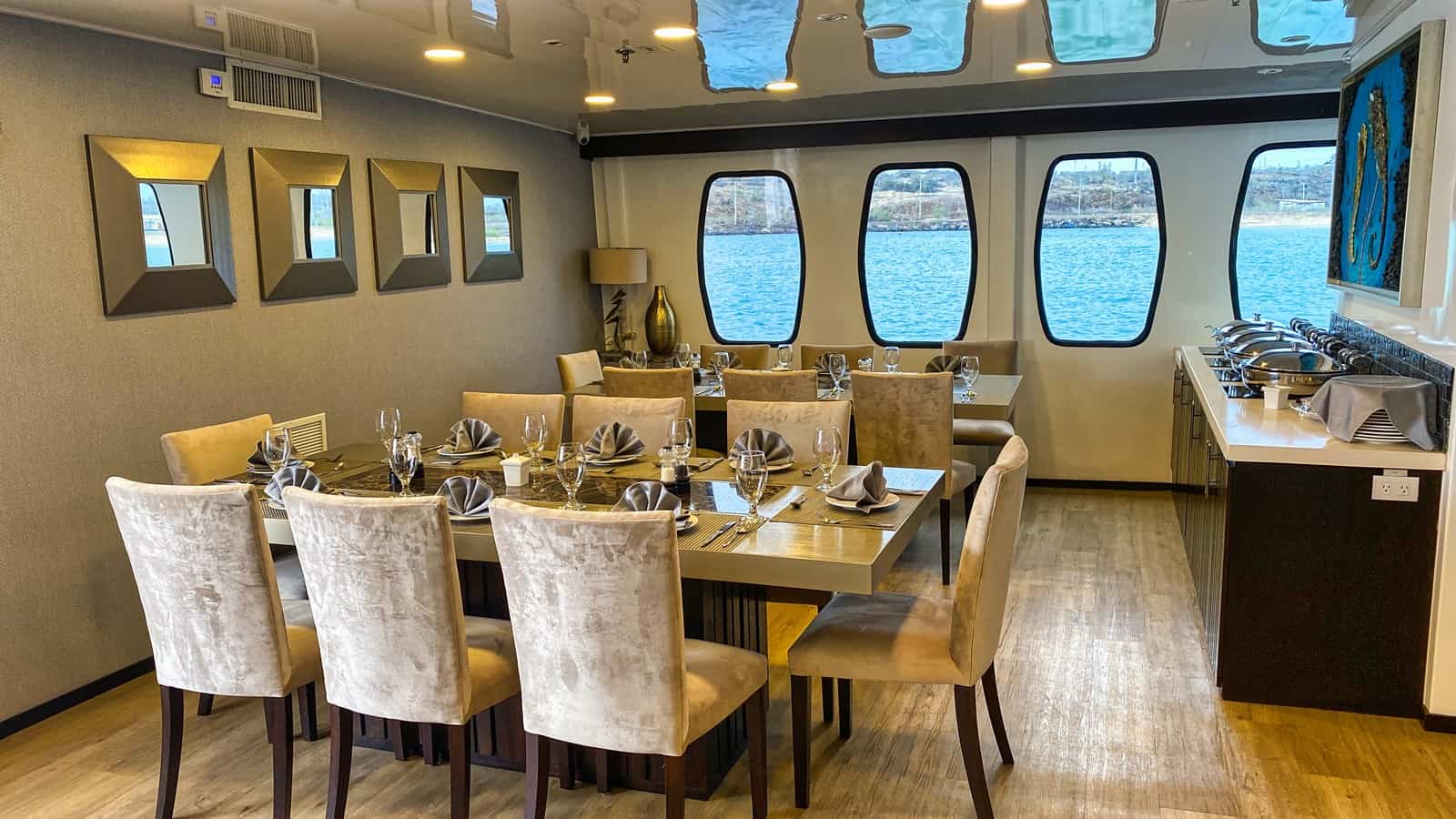
The Beautiful and Tranquil Black Turtle Cove
We began our Galapagos cruise on Santa Cruz Island, visiting Black Turtle Cove. It is not possible to land anywhere on the island at Black Turtle Cove, so we had to board our pangas with our guide to view the islands up close from the water. The winding shoreline bordered by three species of mangroves, red, black, and white, was filled with herons, pelicans, and even a few Blue-footed boobies. The panga driver is very skilled and was able to get super close to the shoreline. And at times, even maneuvered the panga in different positions so everyone on board could get good photos.
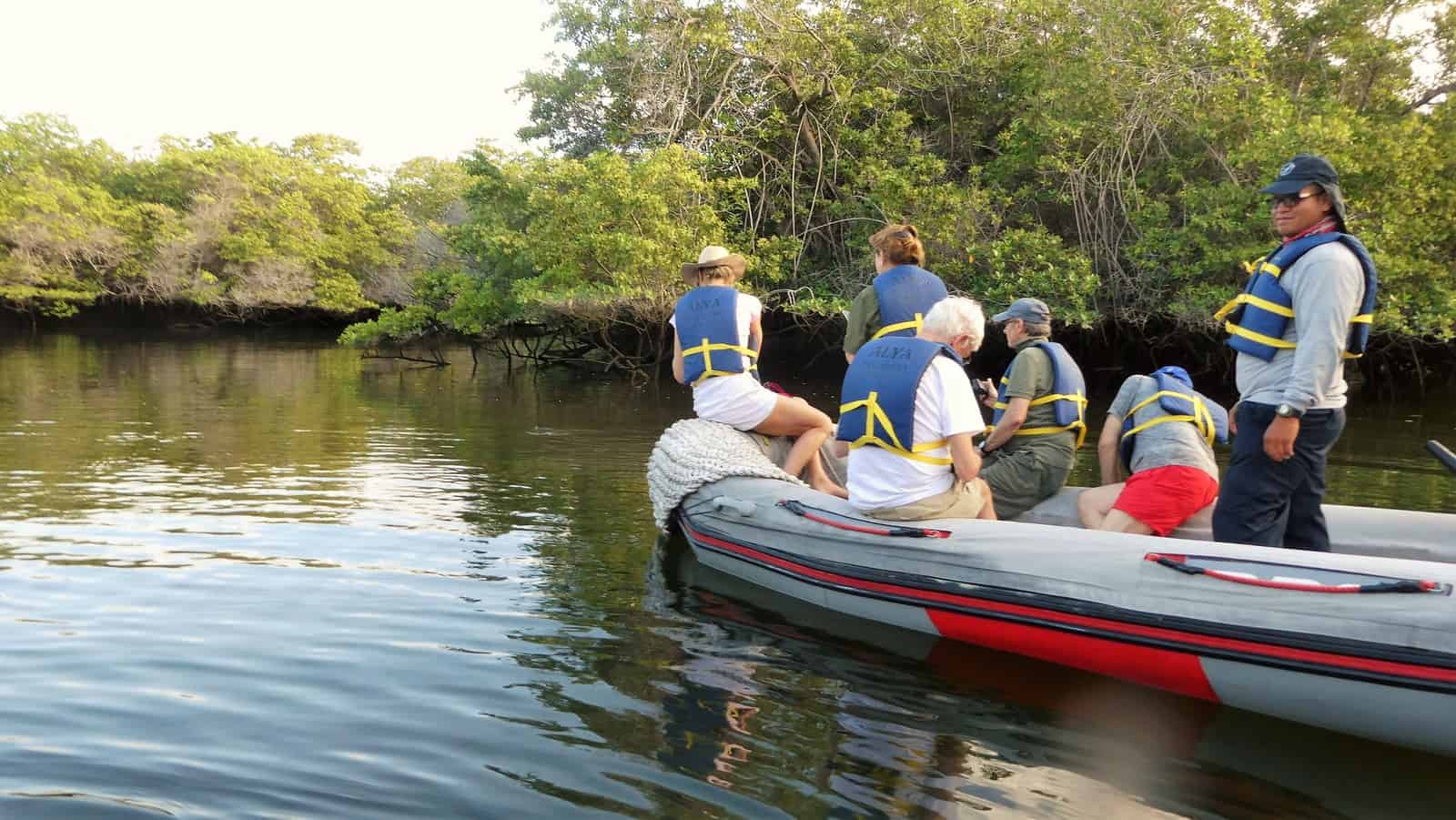
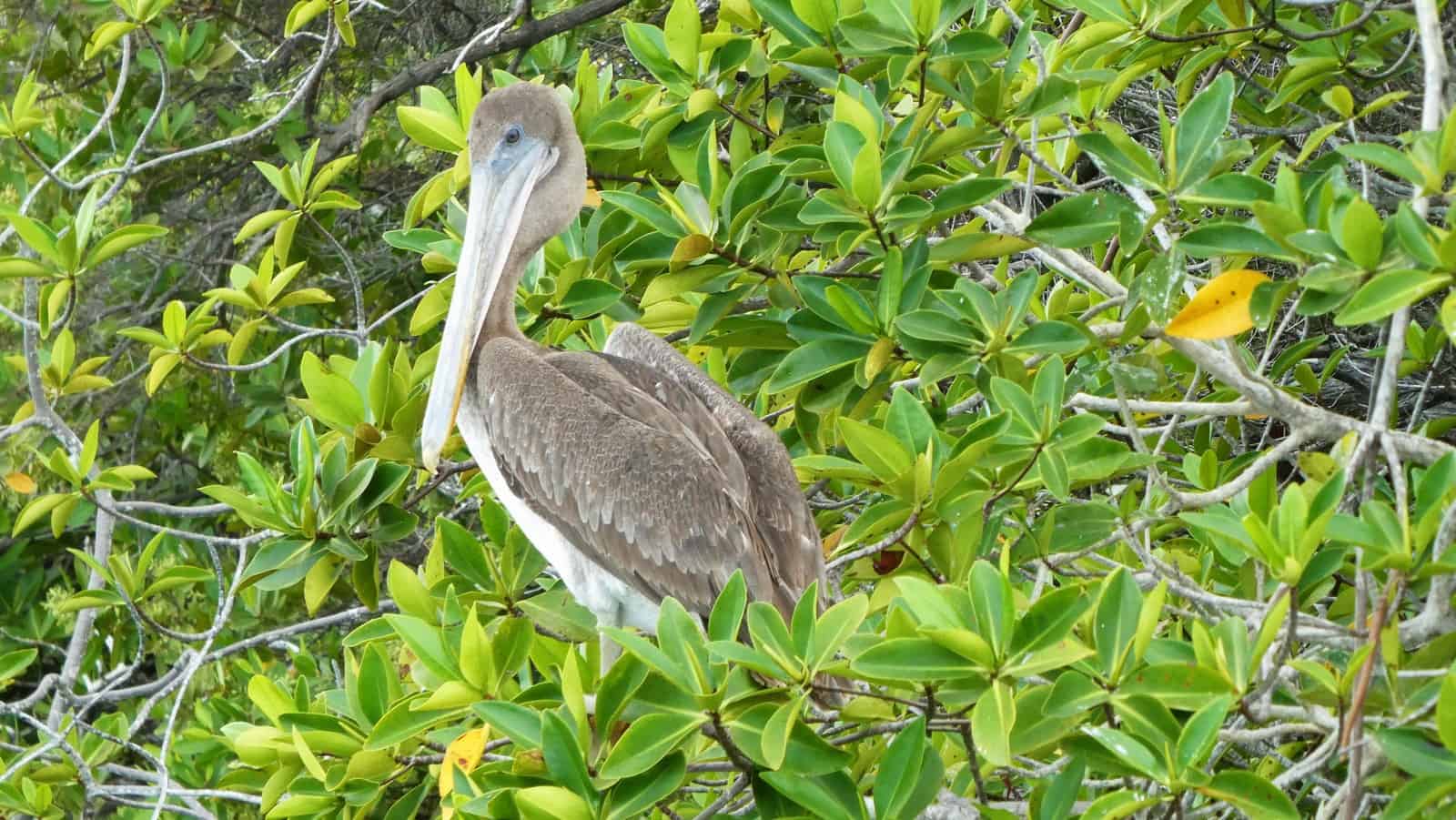
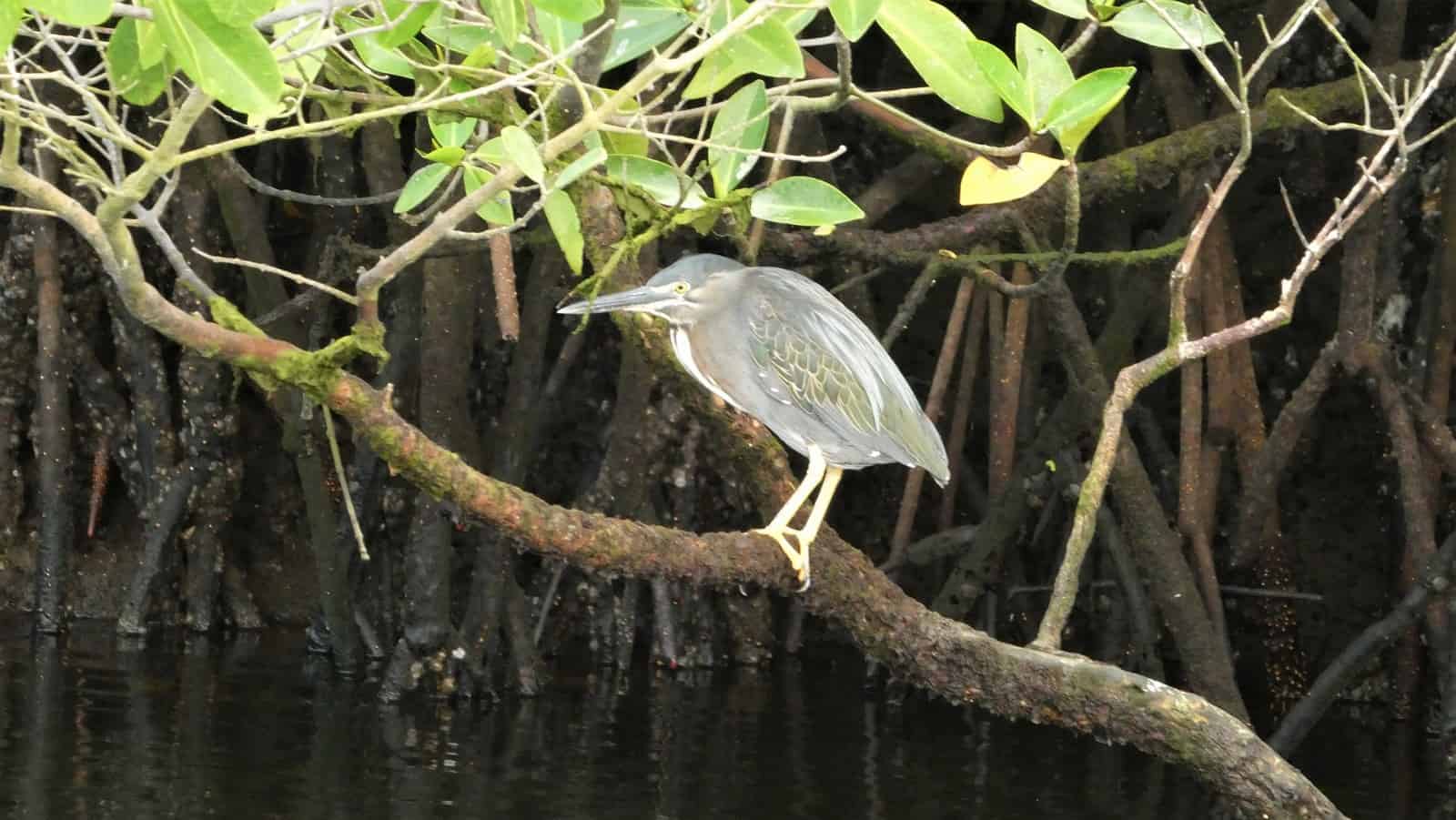
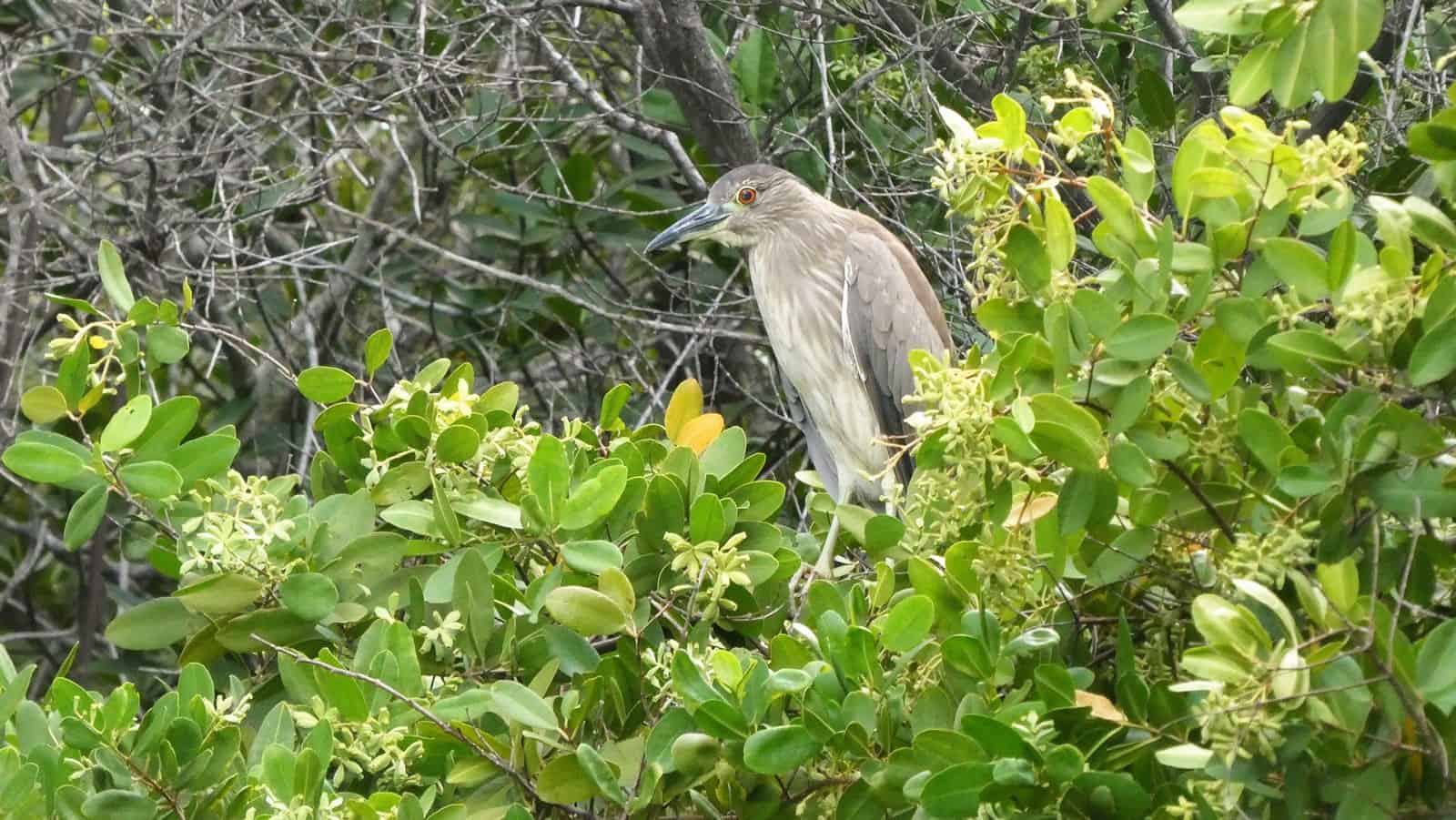
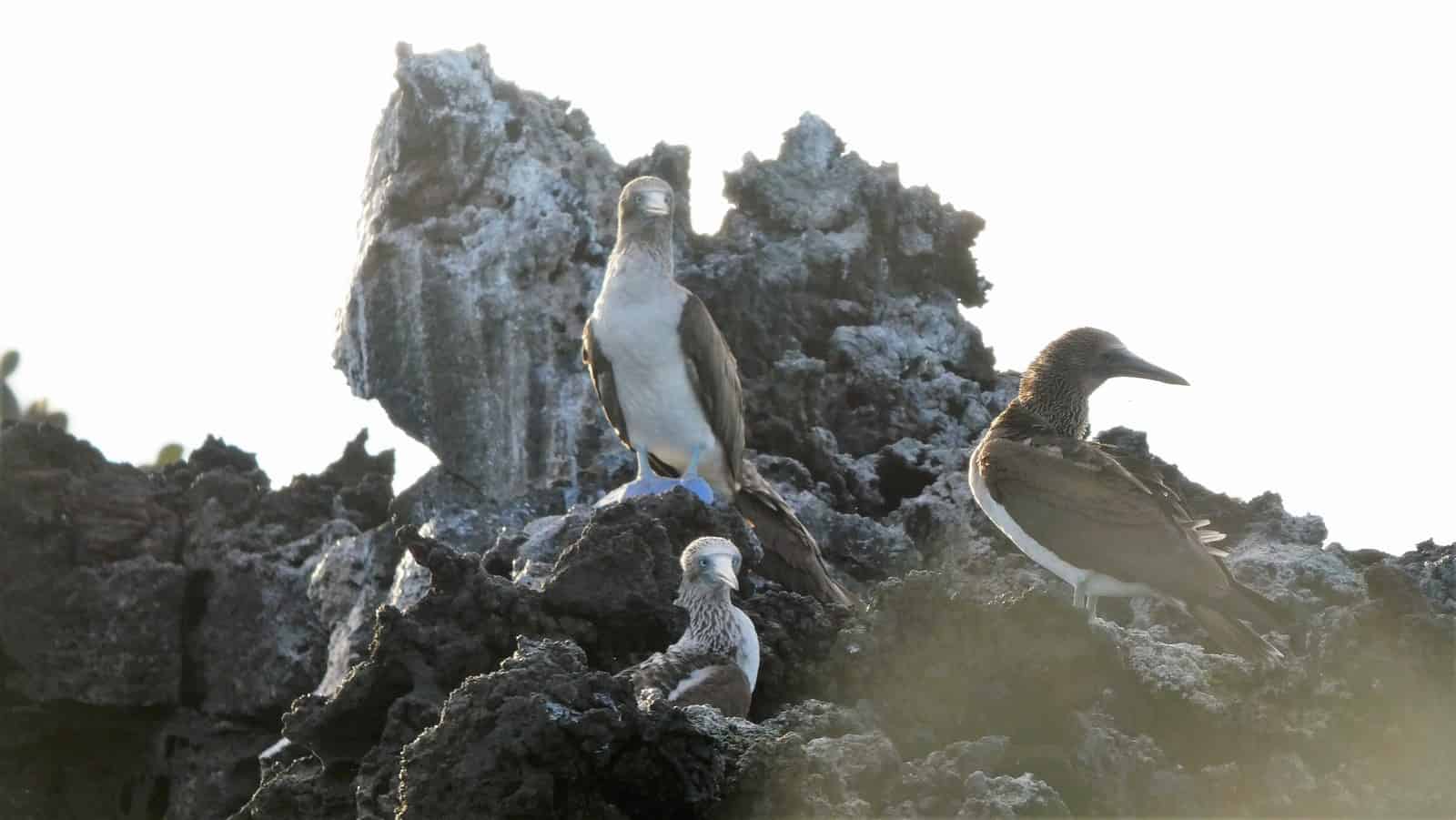
Surprisingly we saw a Blue Heron catch and eat a fish, and we saw a bunch of Hammerhead Sharks.
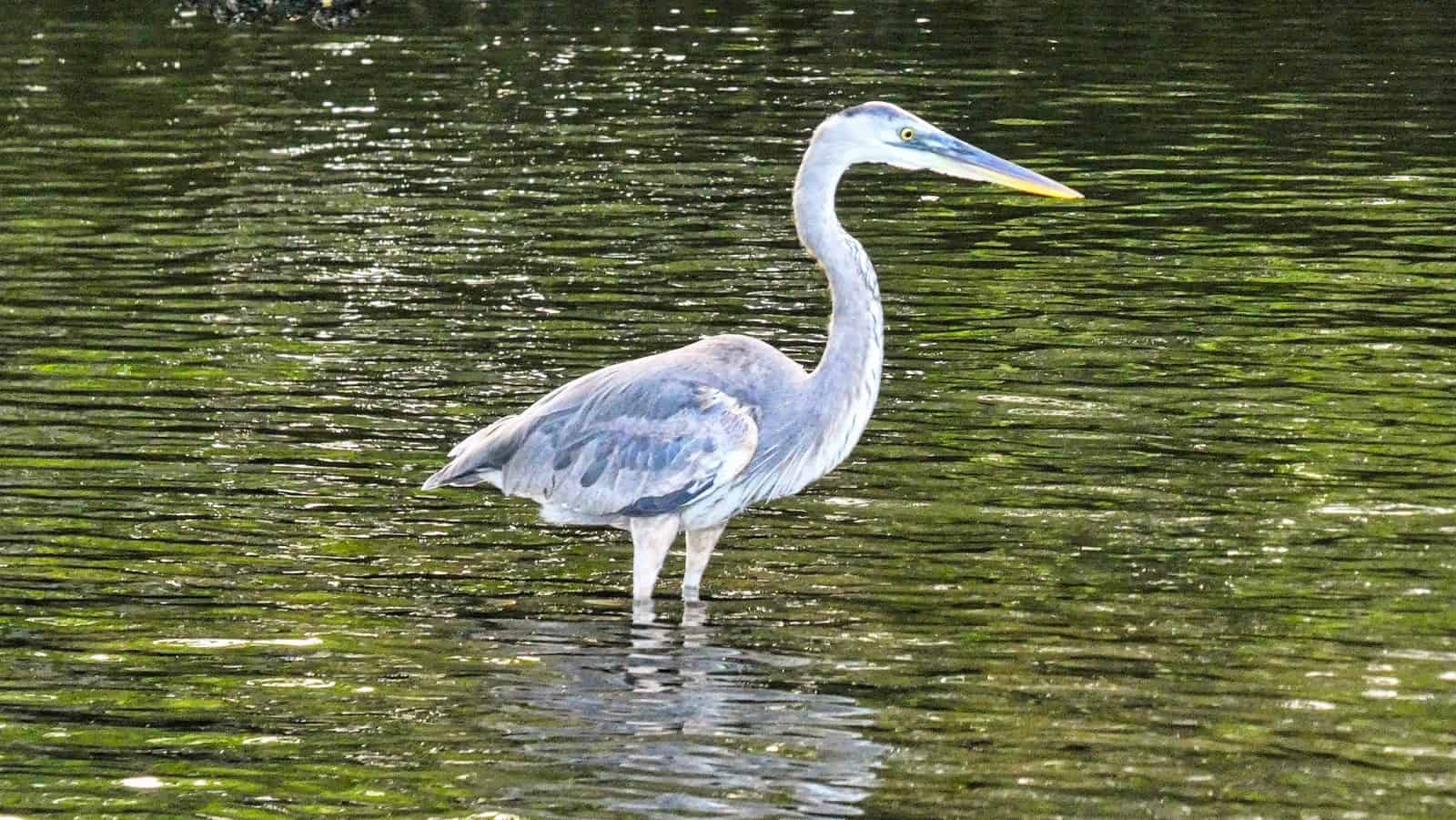
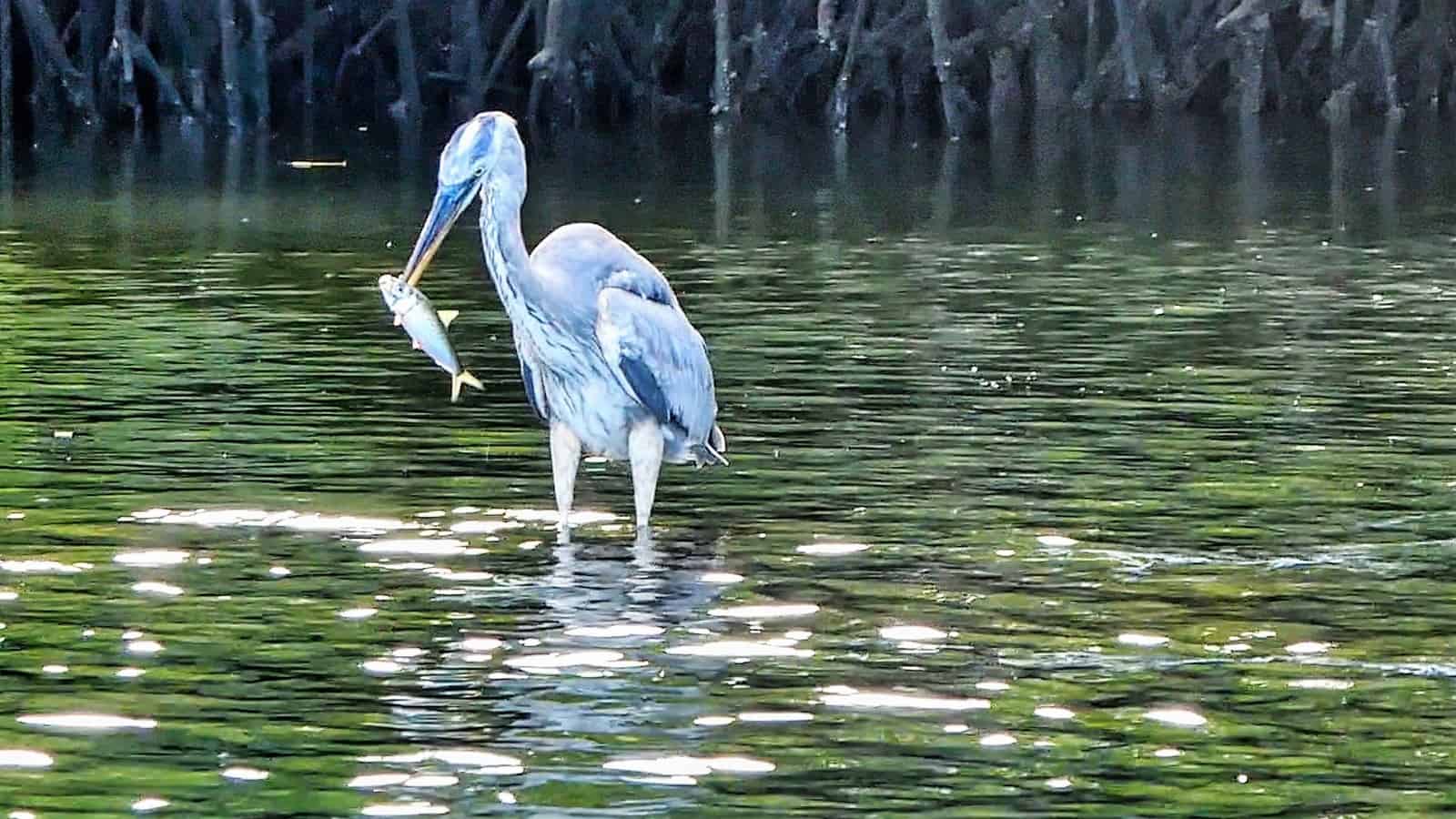
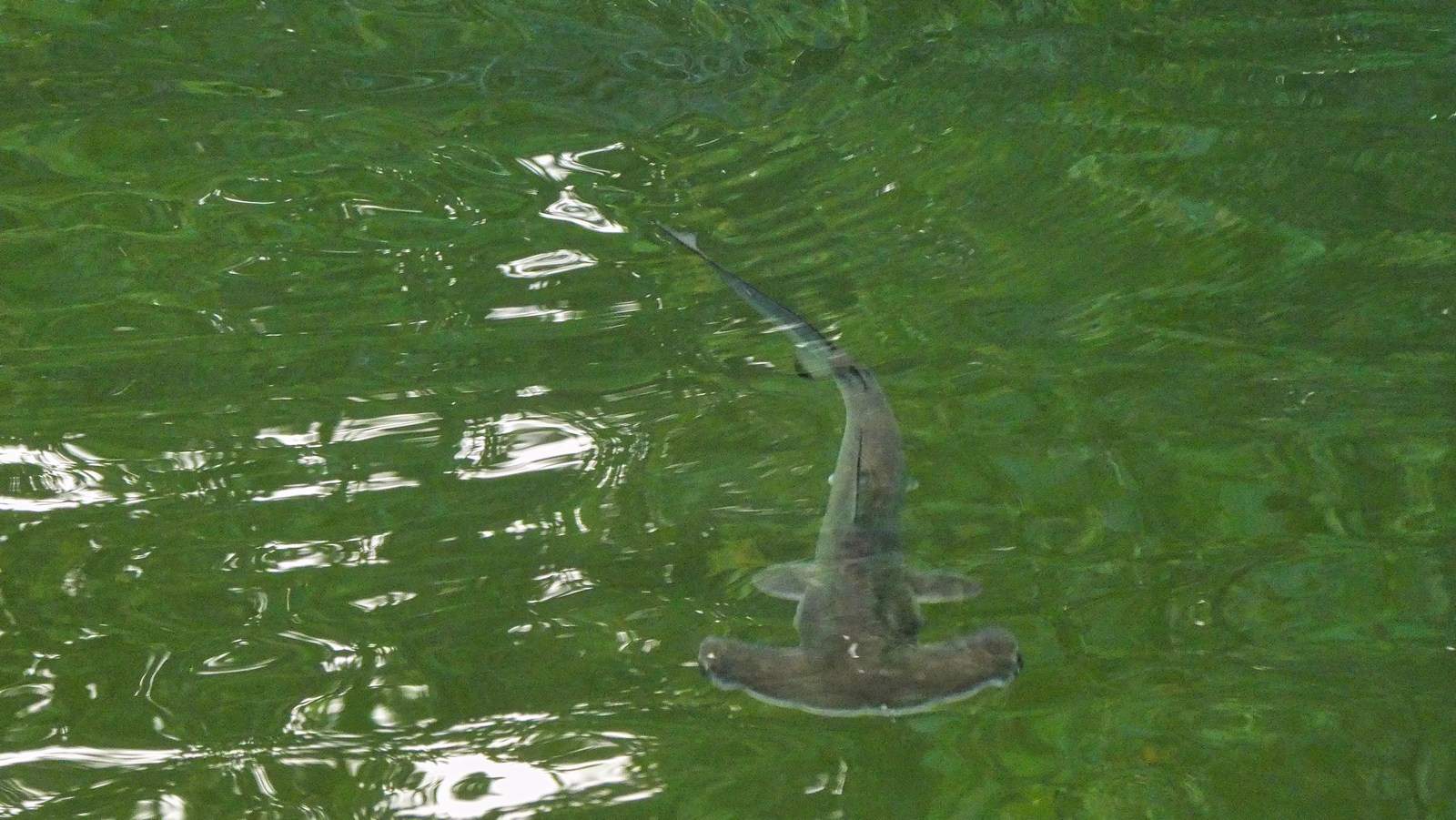
Back on board the catamaran, we had some time to freshen up and then explore the ship before catching our first Galapagos sunset and dinner.
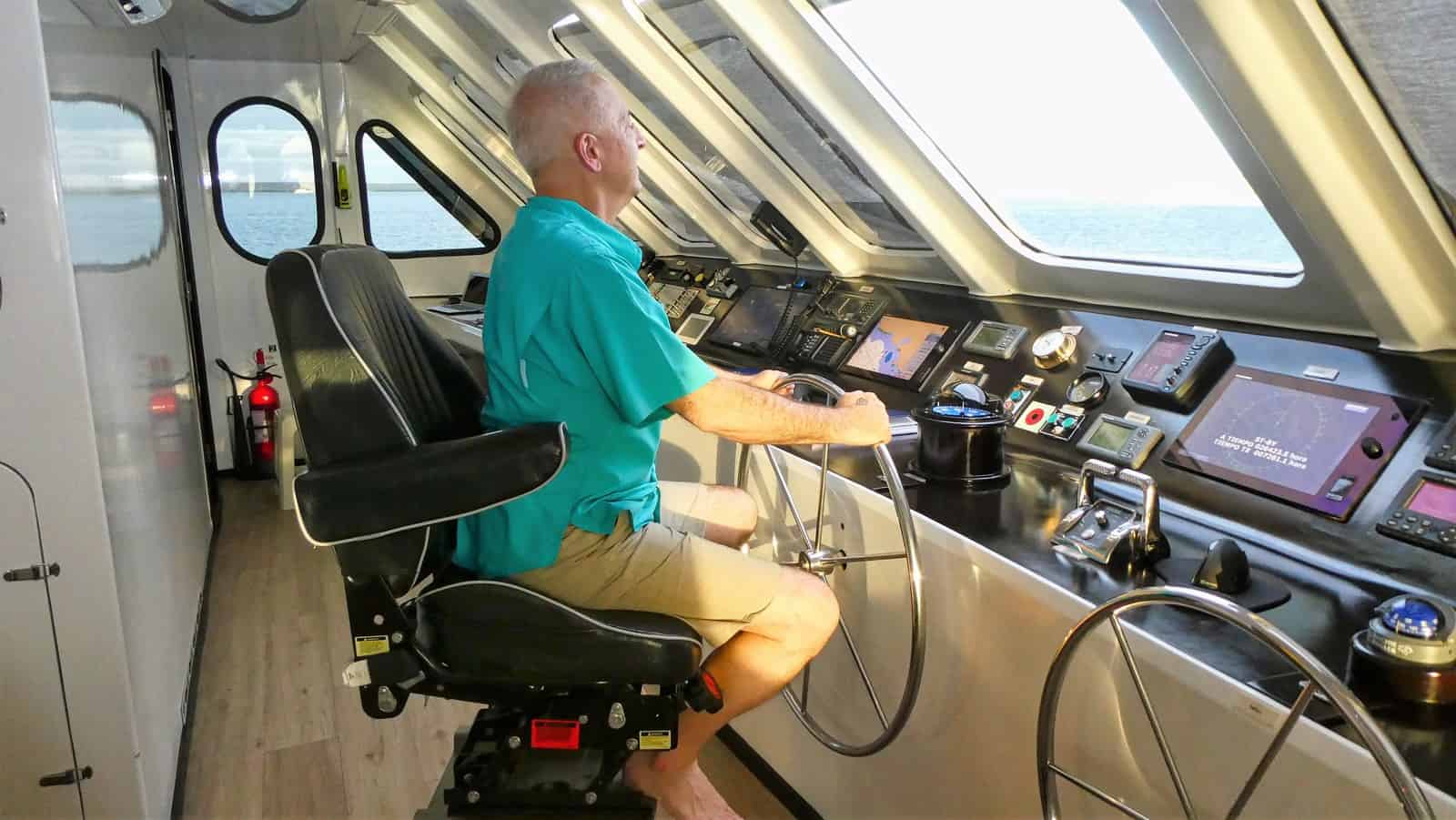
Just before dinner each night, we had a briefing from our Naturalist of what we will be doing the next day. Additionally, the briefing was our itinerary that included what we needed to bring for each excursion and if it was a wet or dry landing (more on that in a minute).
After the briefing, it was time for dinner. Thus, dinners on the M/C Alya are sit down, always plated, and there are usually three choices, with one being vegetarian/vegan. There is a starter, main entrée, and dessert every night. In between courses, we had some time to get to know one another, and we talked about the sights in Black Turtle Cove.


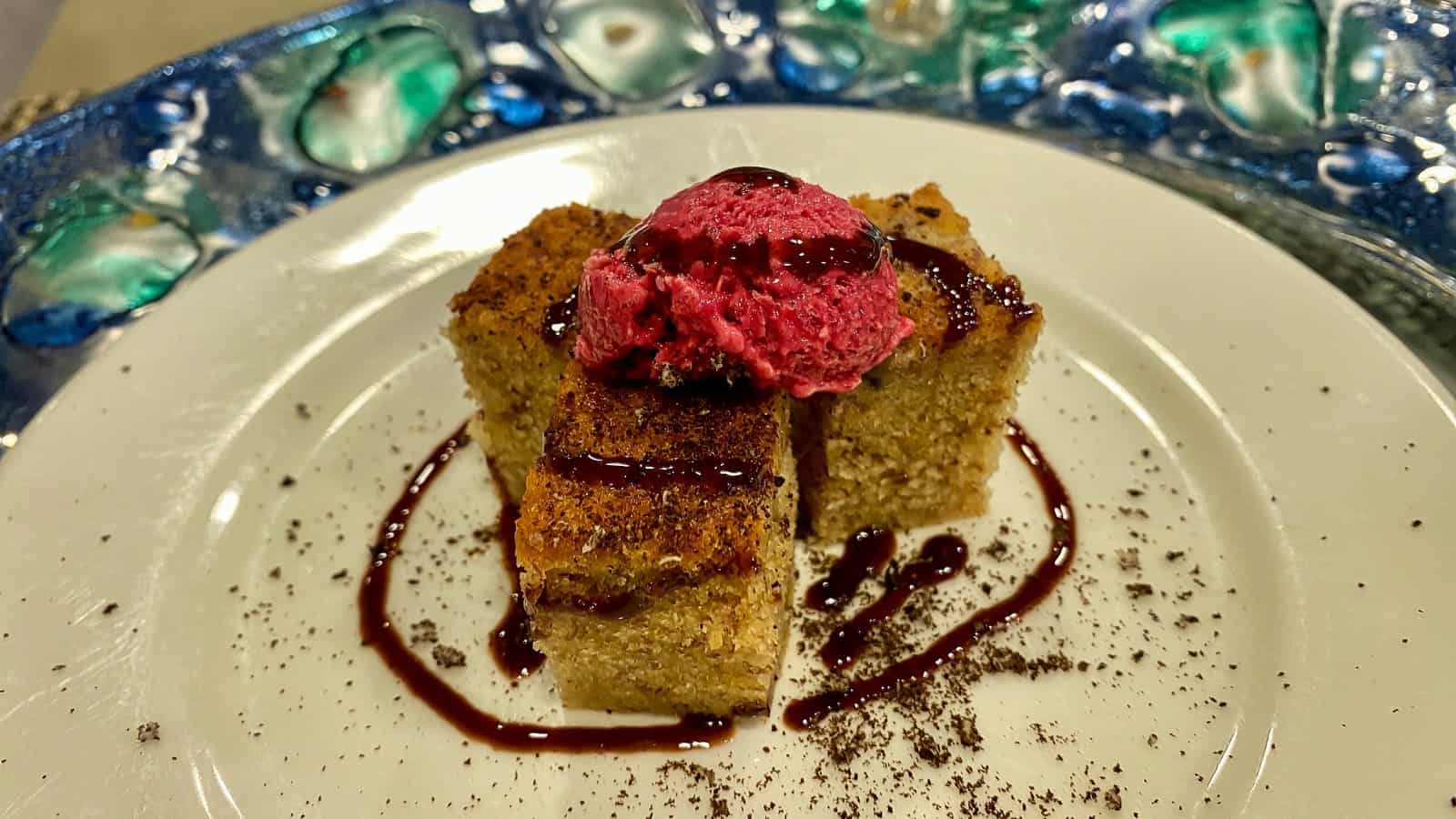
Genovesa Island, Galapagos
Day two, when we awoke, we were at Genovesa Island. On a Galapagos cruise, most of your travel is at night, which greatly reduces your travel time (because you’re asleep during it). Genovesa Island, named for the Italian city of Genoa, in honor of Christopher Columbus, is a shield volcano in the eastern Pacific Ocean. Accordingly, a shield volcano is usually composed almost entirely of fluid lava flows. It is named for its low profile, resembling a warrior’s shield lying on the ground. Because the volcano is low when it erupts, the lava is highly fluid (low viscosity) lava, which travels far.
Darwin Bay On Genovesa Island
In the morning, we visited Darwin Bay. Again, we board the pangas, but today will be a wet landing meaning the panga will drop us in up to calf-deep water, and we will need to walk ashore. Darwin Bay is a small sand and coral beach. As you walk ashore, there is sand, but there is also a lot of coral, so we recommend having water shoes or sandals that can get wet. The cruise ship provides towels so you can dry your feet once onshore before putting on your hiking shoes if you choose.
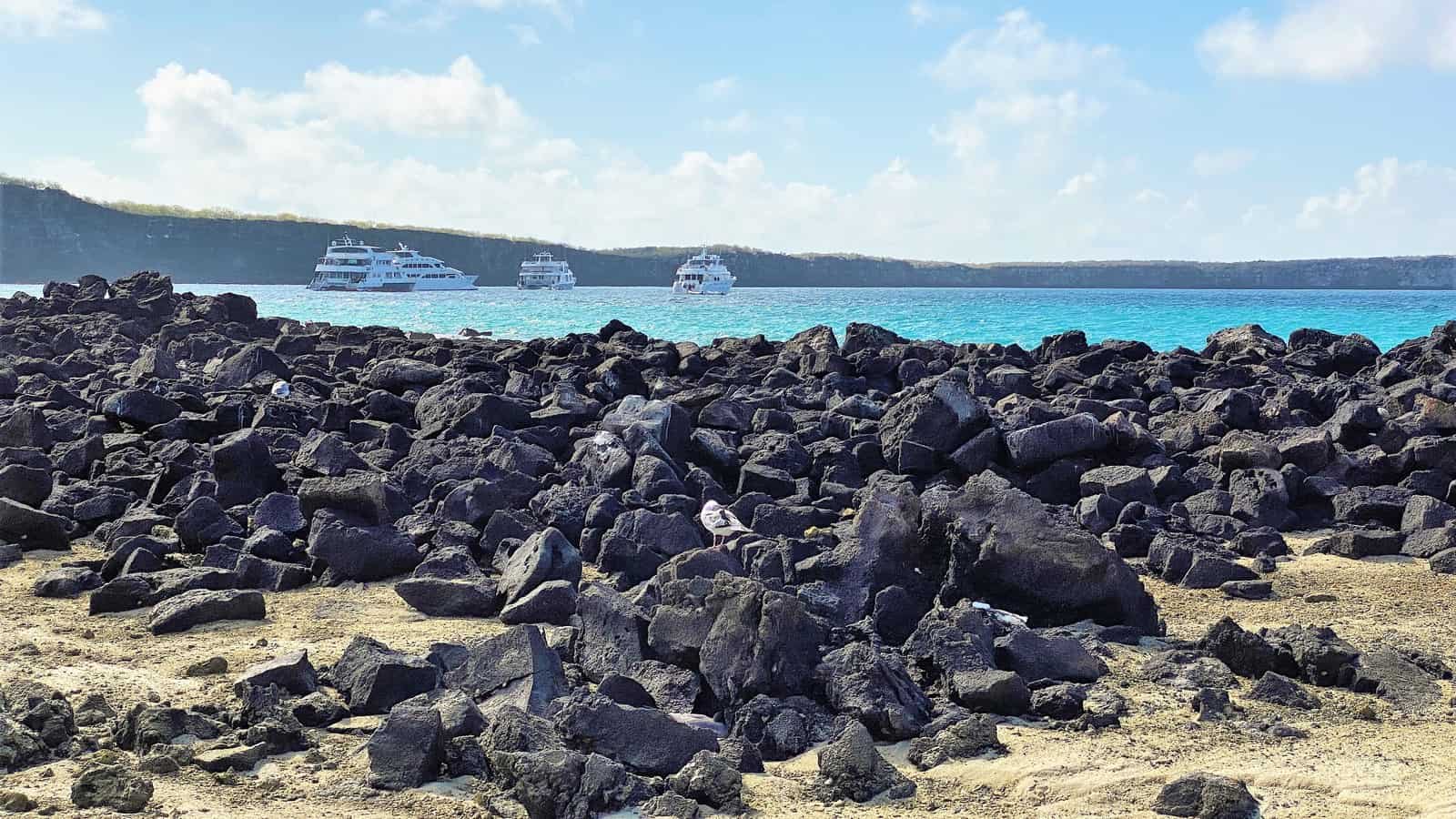
A Bird Paradise
Markedly, the Darwin Bay area of Genovesa Island is known as “a bird paradise.” Among the birds we saw were Swallow-tailed Gulls, Galapagos Mockingbirds, Lava Herons, Galapagos Doves, Frigatebirds, Red-footed Boobies, Nazca Boobies, and Yellow Warblers, with their bright yellow feathers.
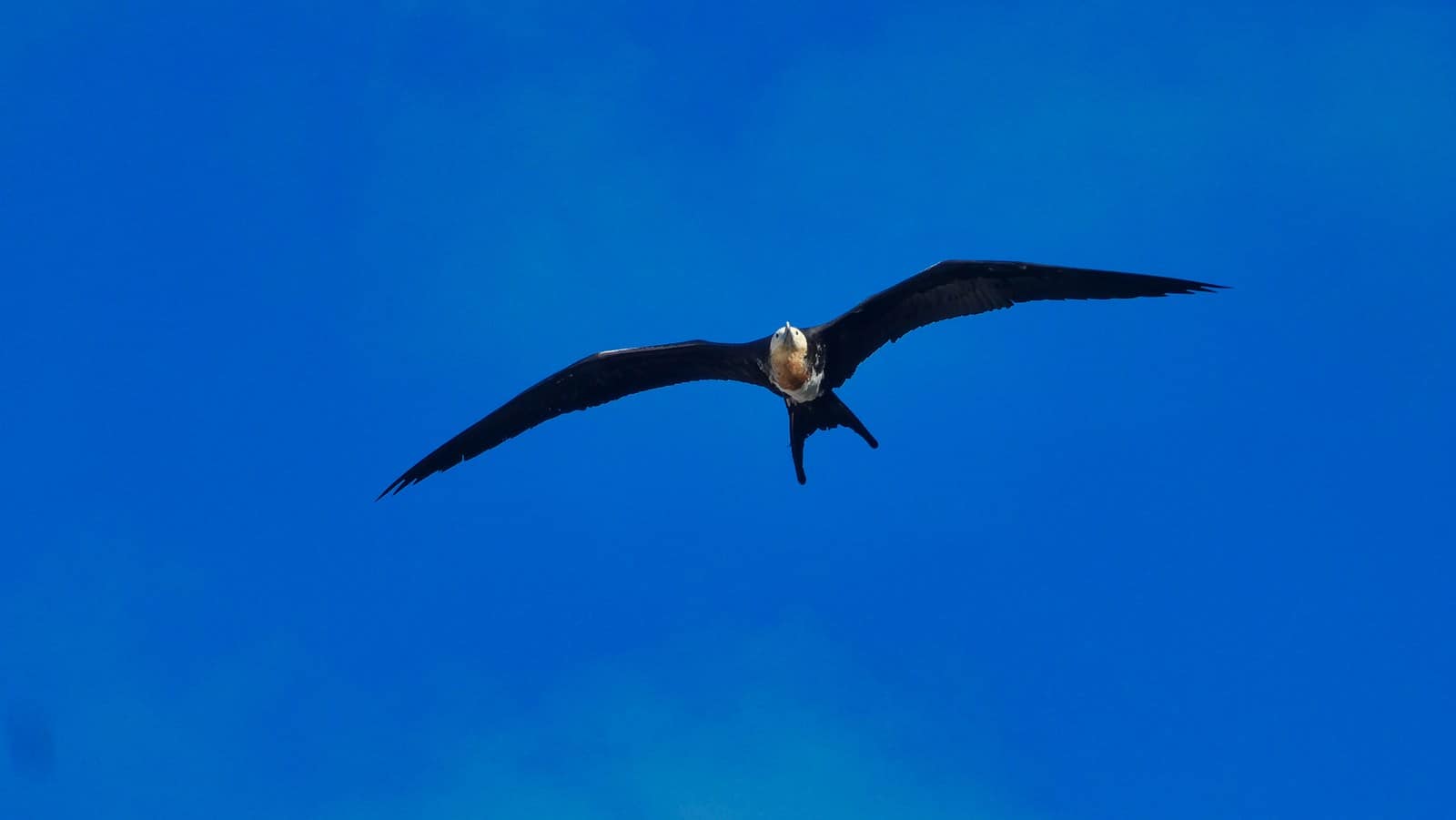
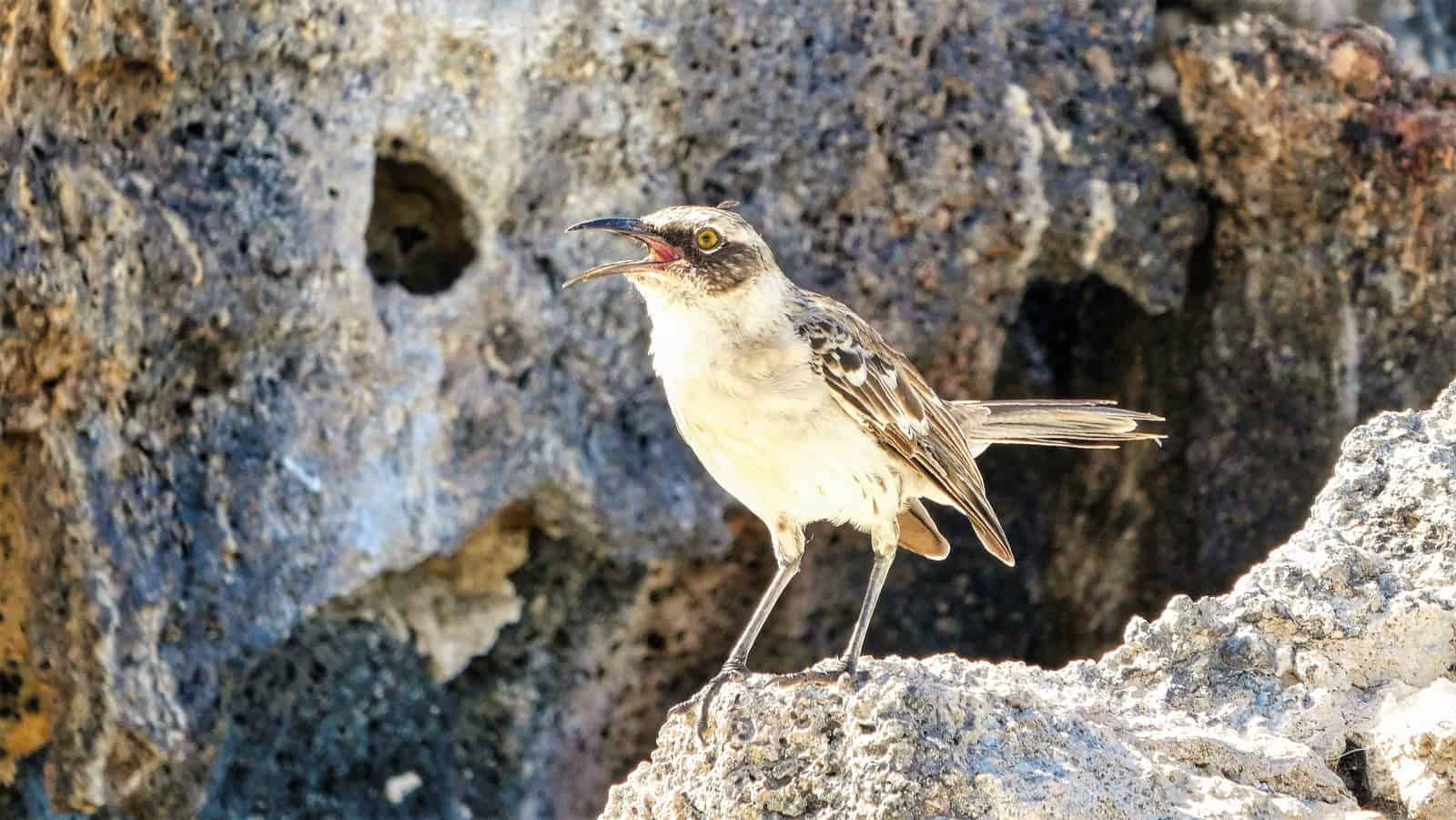
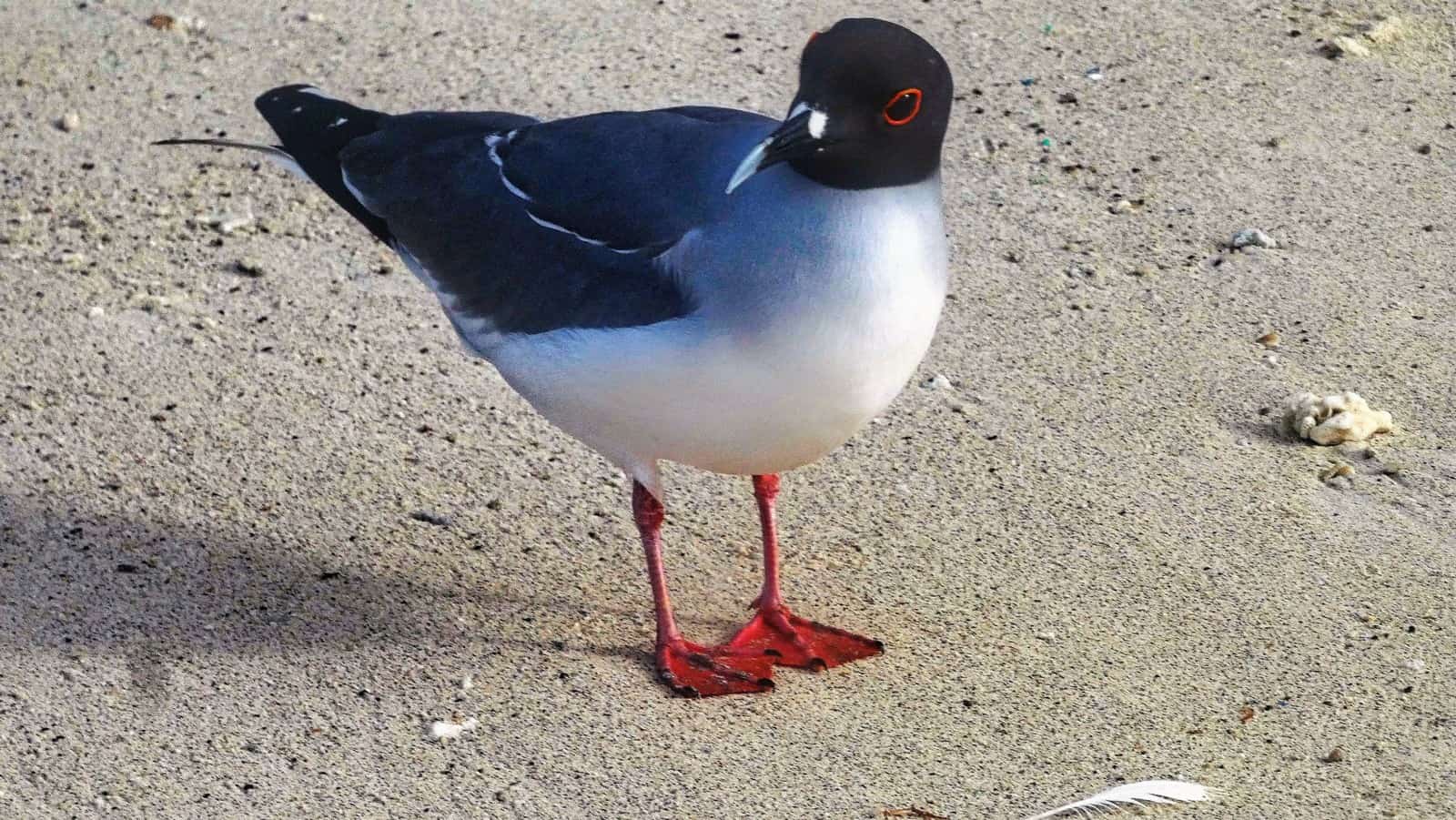
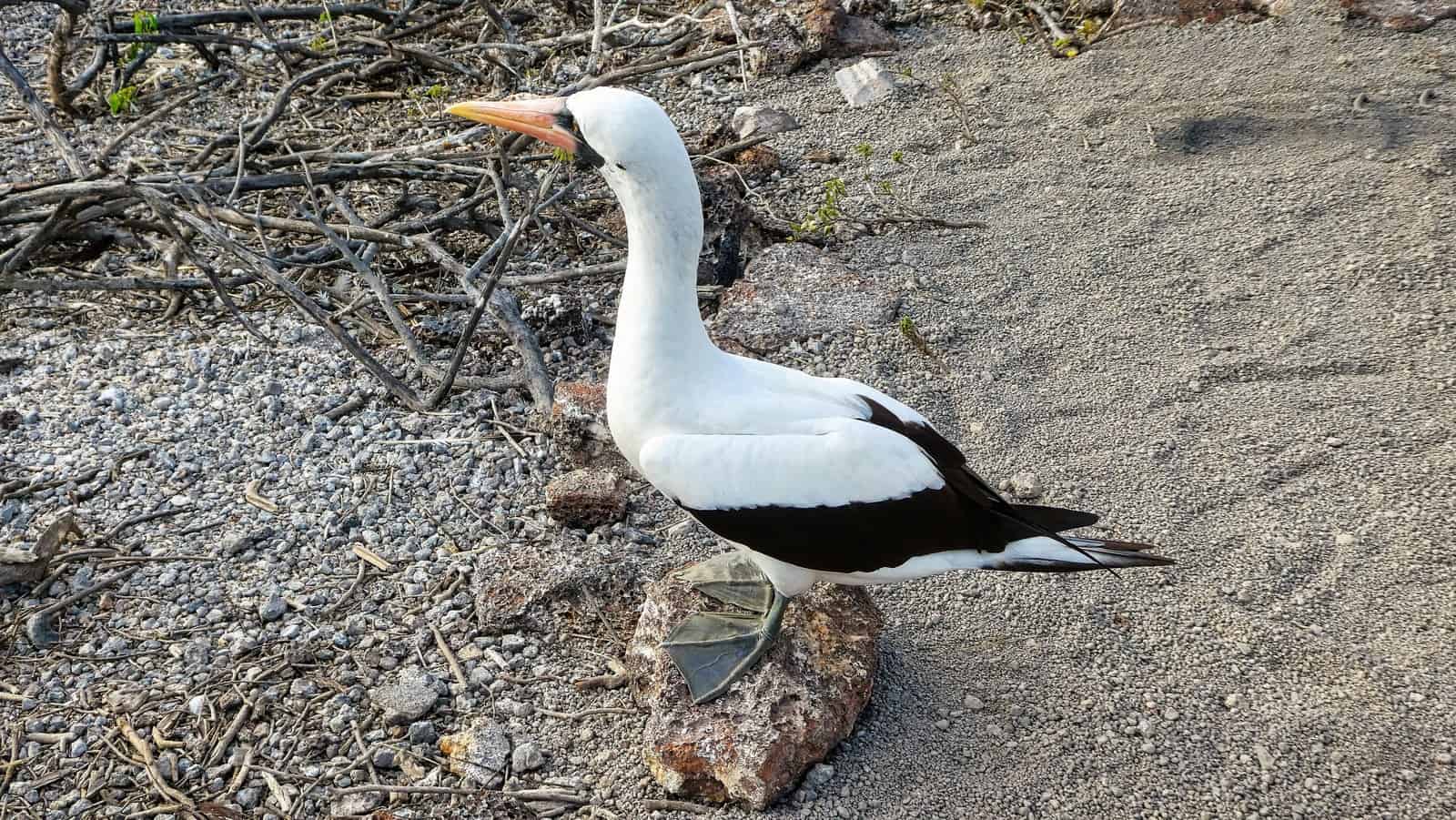
Frigatebirds are the plundering pirates of the Galapagos skies. Rather than hunt for themselves, they steal from the boobies. The male’s most distinctive feature is a balloon-like redbreast that inflates when they’re trying to impress the gals. Unquestionably it’s quite a sight to see these scarlet sacs swelling in the skies or on the branches.
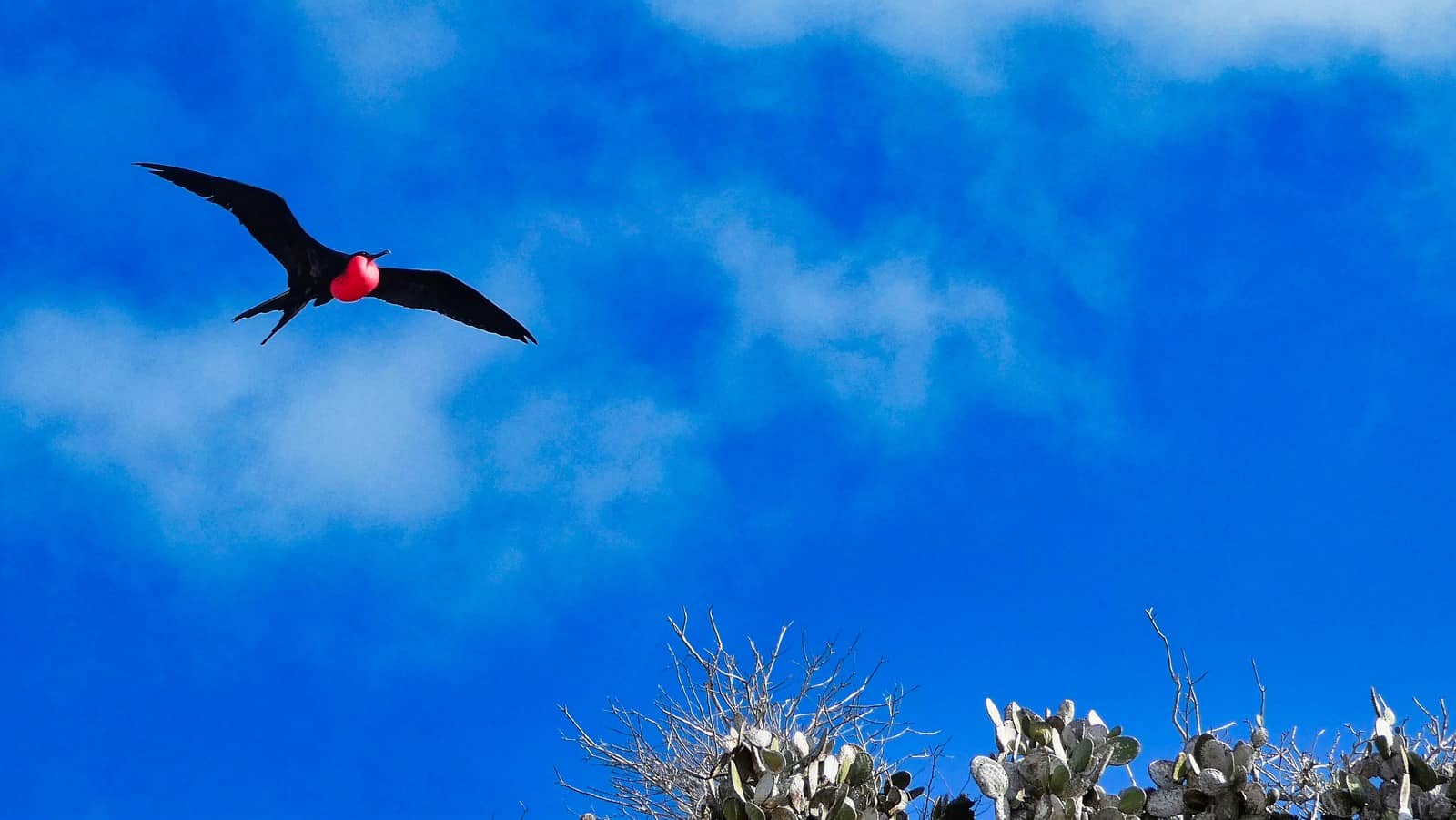
Like their blue-footed cousins, the red-footed boobies are comical. These birds mostly live here on Genovesa Island. Unlike the blue-footed boobie, the red-footed boobies live in the mangrove branches rather than on the ground.
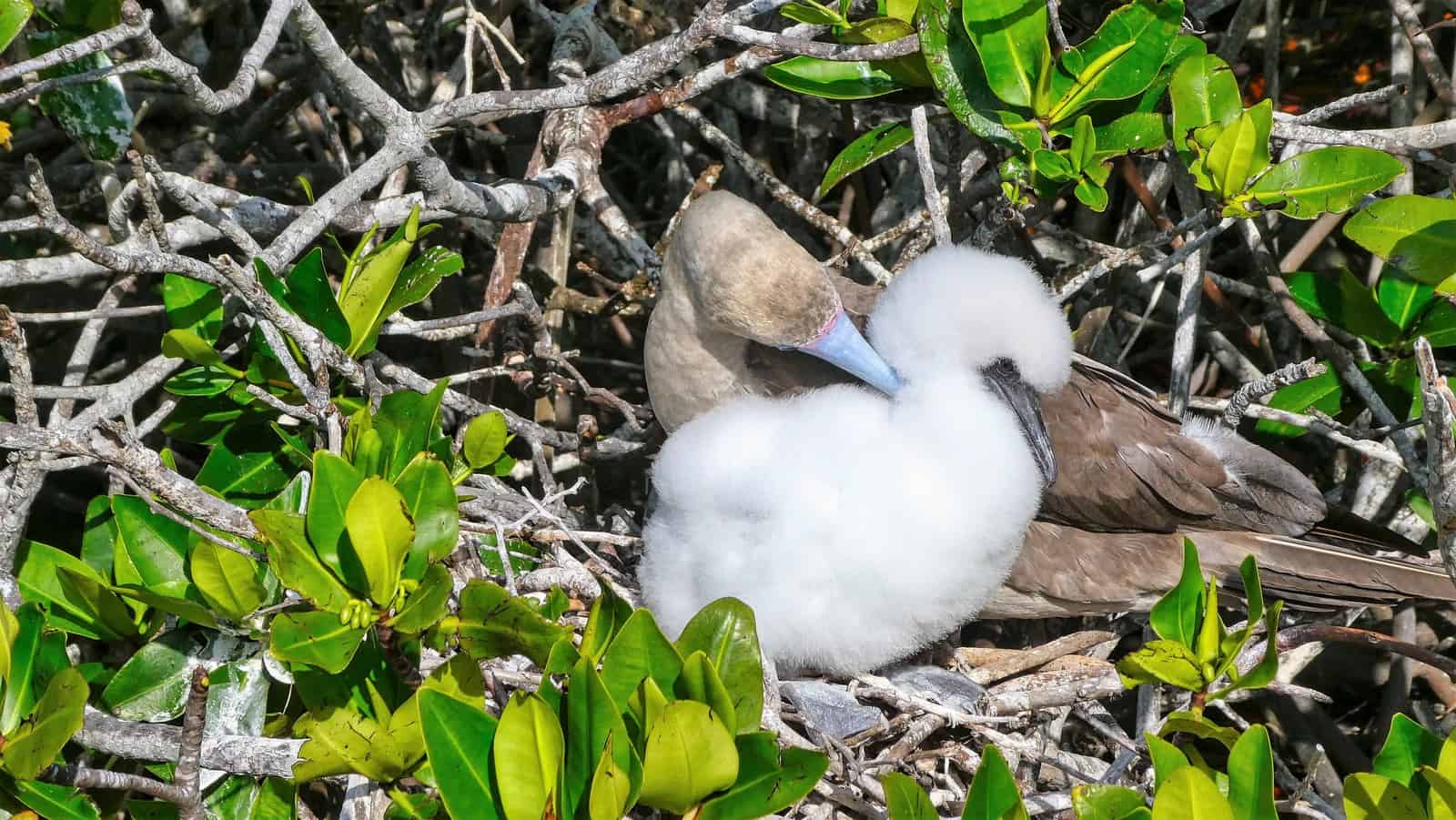
We also saw some sea lions and marine iguanas.
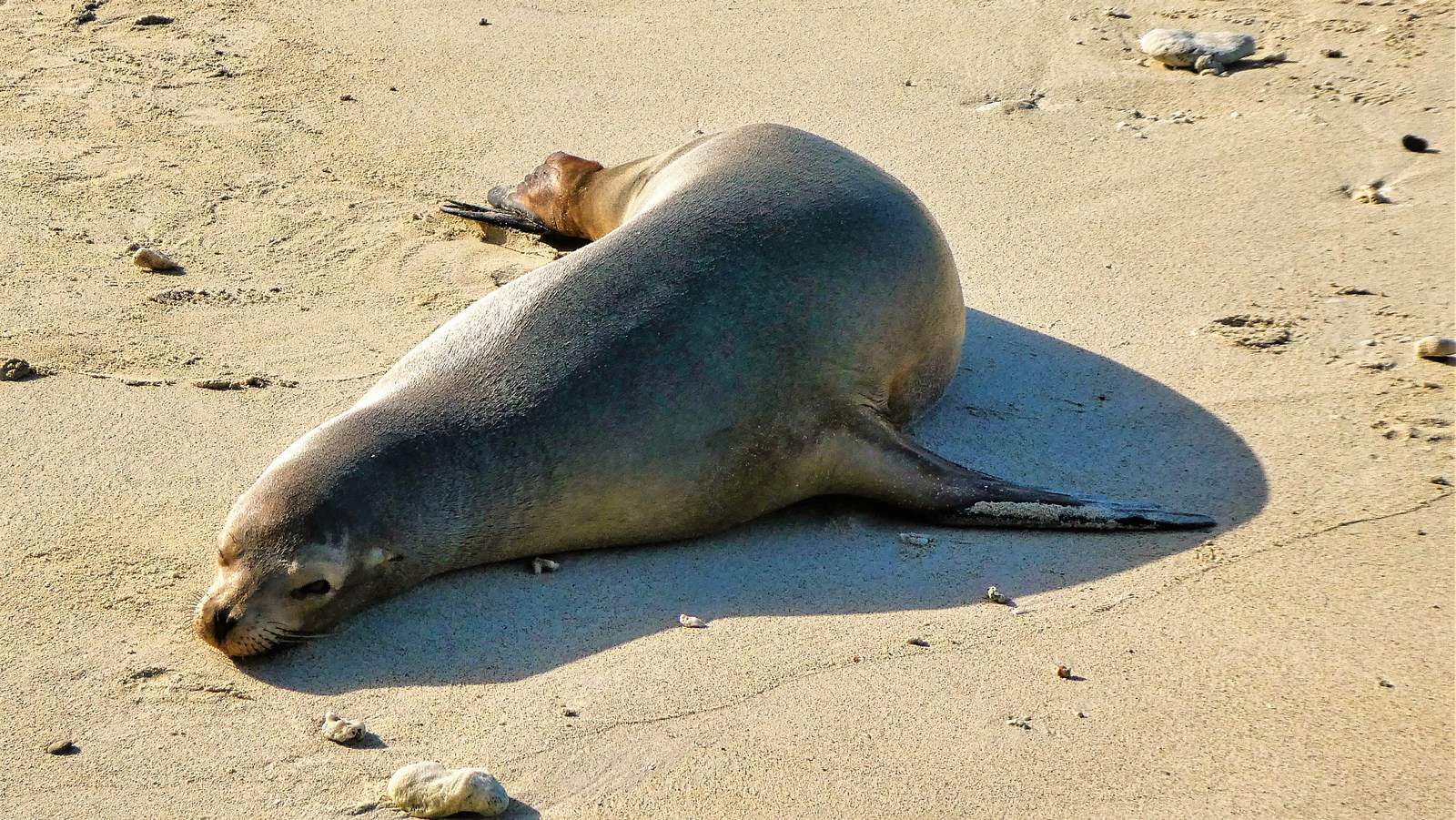
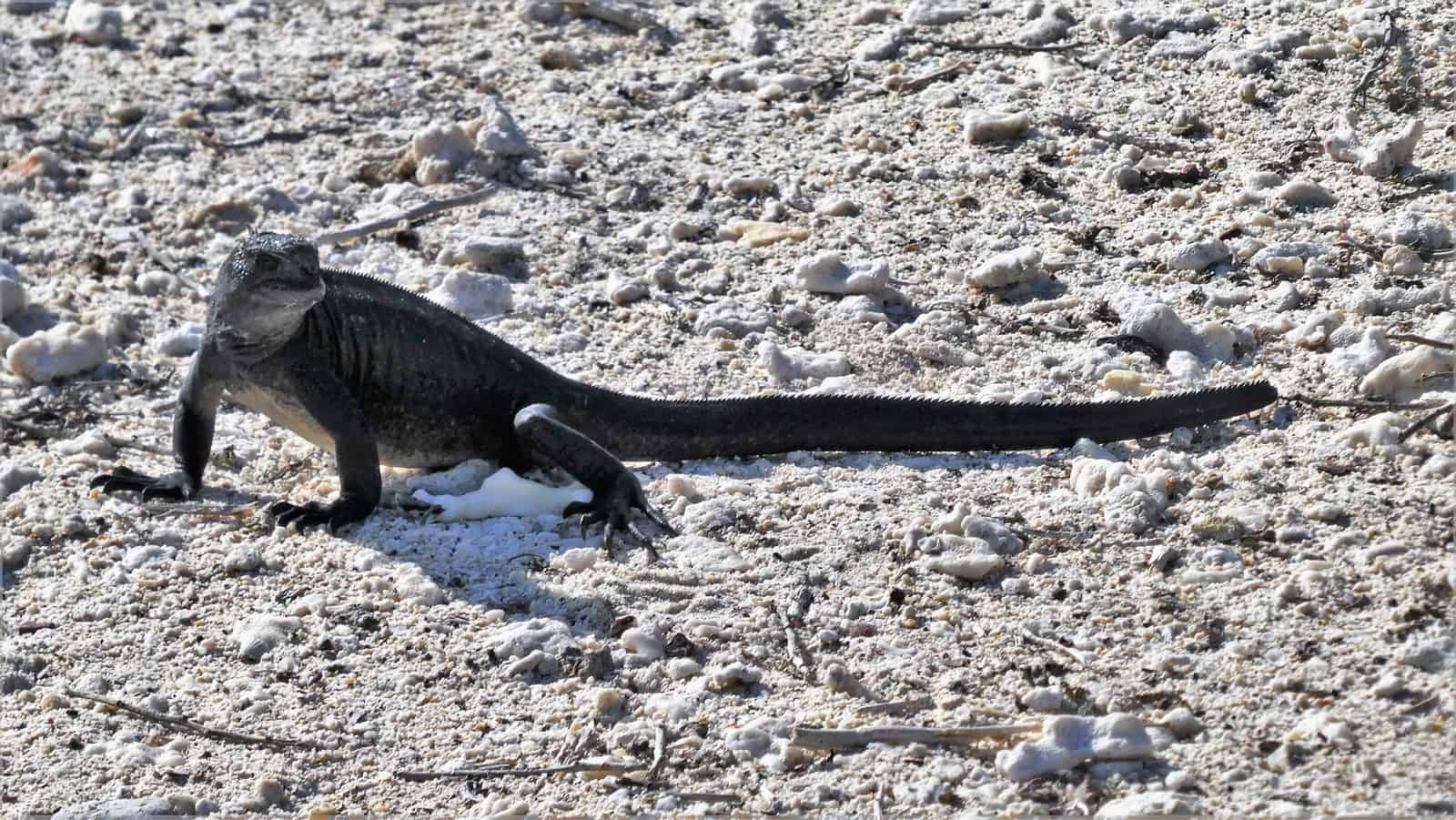
But, the great frigatebirds and red-footed boobies that breed in abundance on this island were the dominant birds we saw. In the Galapagos, you are supposed to stay two meters or six feet from the wildlife, but here we found that impossible and still stay on the trail. There were so many baby boobies. Many are anxiously awaiting the return of their parents for food that they will walk right up to you.
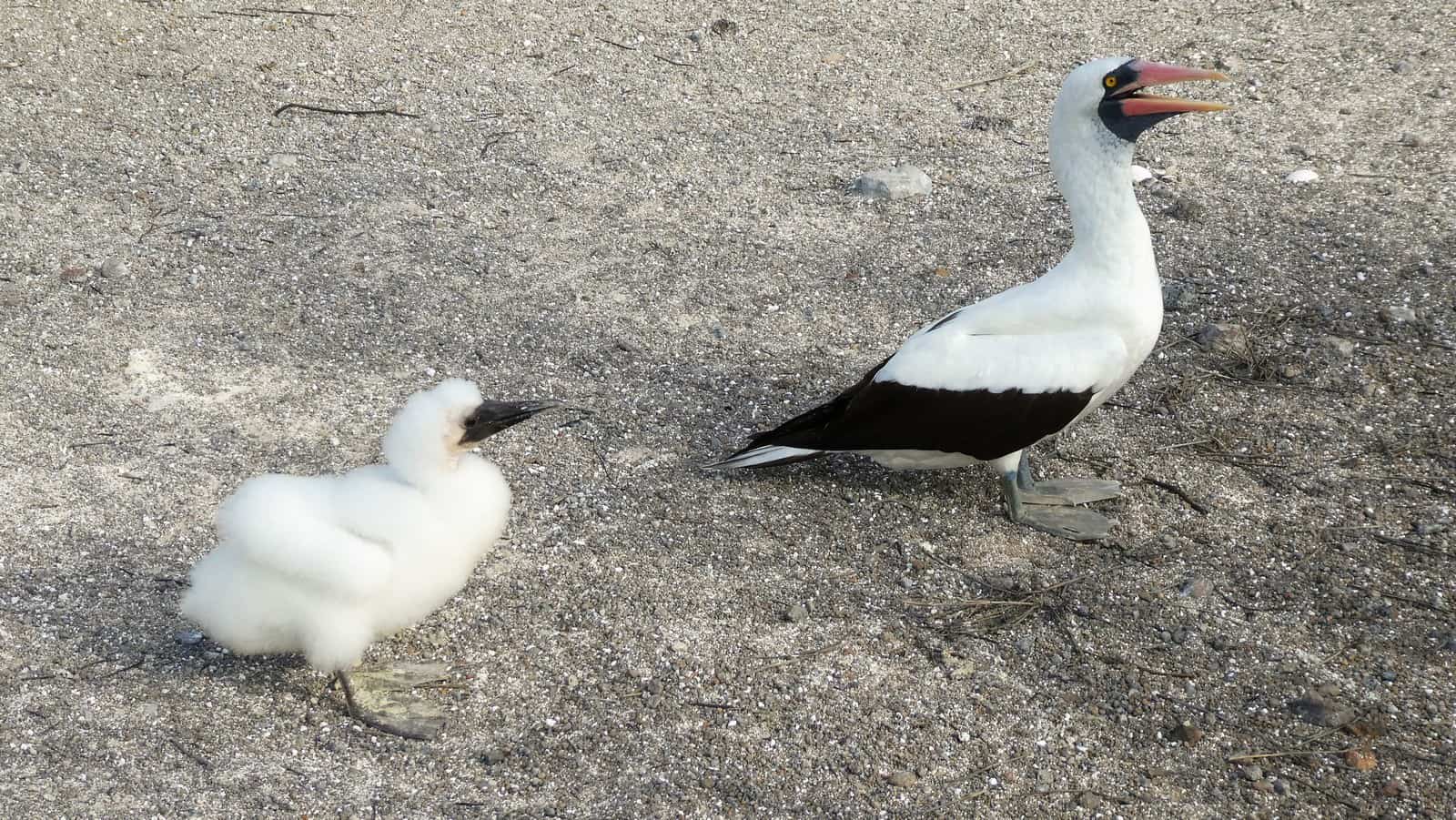
The beach has trails that take you past tide pools and lava ridges, leading to a high point that overlooks the bay. It’s great to have a guide who really knows a lot about the islands. Anytime we were walking, the Naturalist would point out things and explain more about the wildlife.
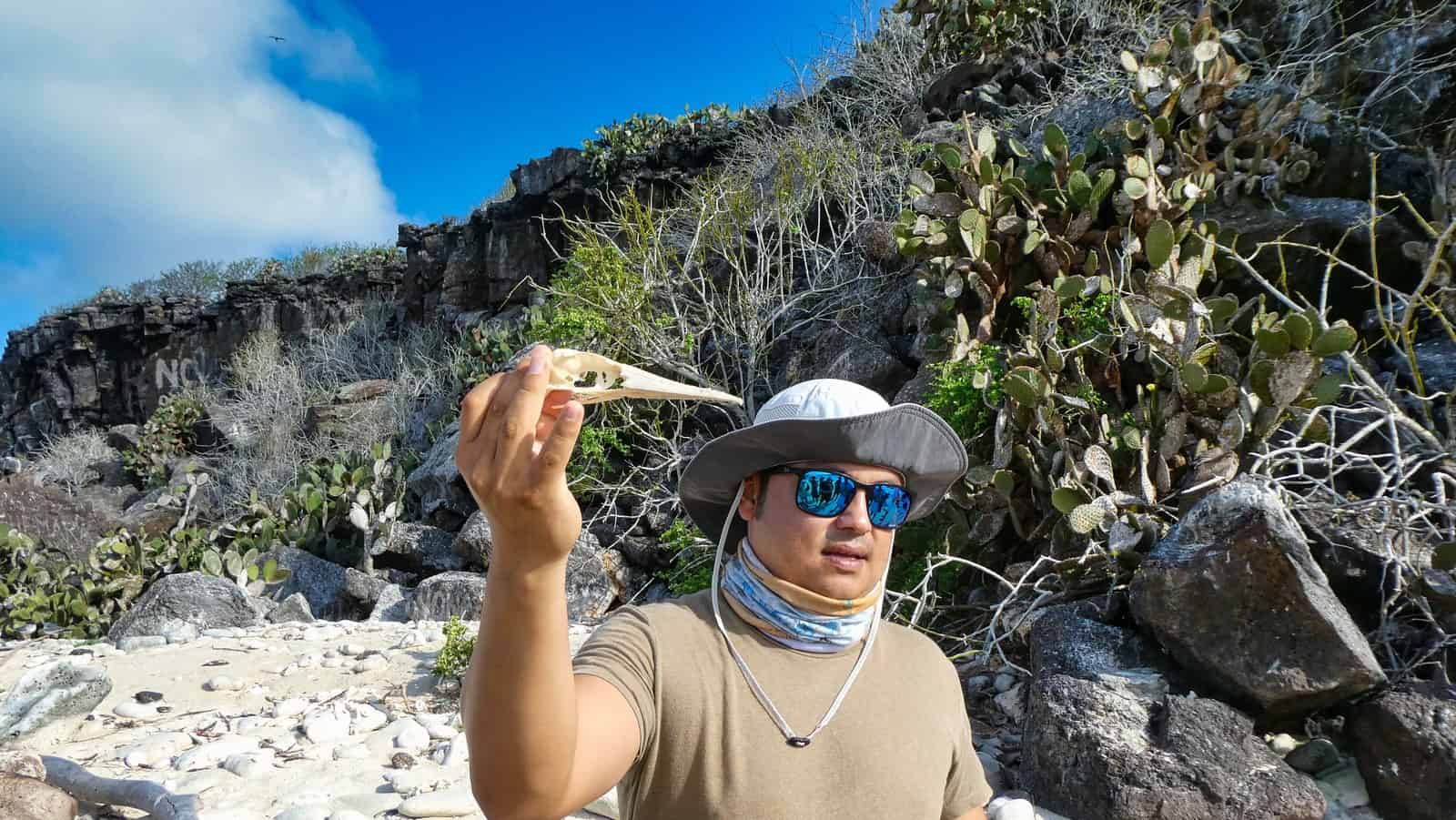
Snorkeling Around Genovesa Island
We returned to the ship, had a snack and got ready to snorkel. This time we boarded the pangas and headed to a rocky area of the island of Genovesa. Our Galapagos cruise, the M/C Alya, provided all our snorkeling equipment and wetsuits. The water wasn’t that cold that we needed wetsuits; however, we both wore them more for sun protection than warmth. In addition to snorkeling, the M/C Alya had a couple of Kayaks on board if you wanted to go for a Kayaking.
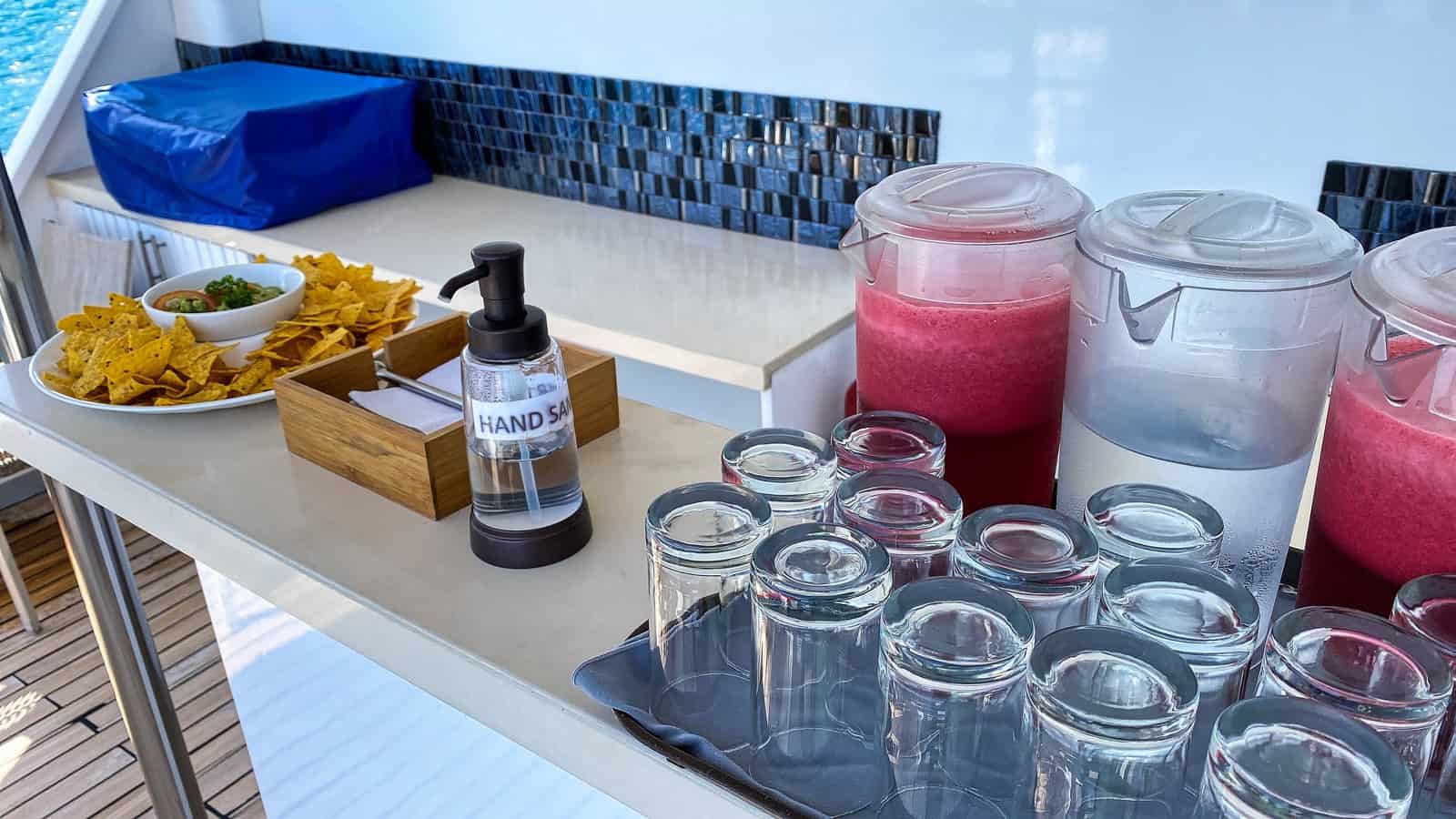
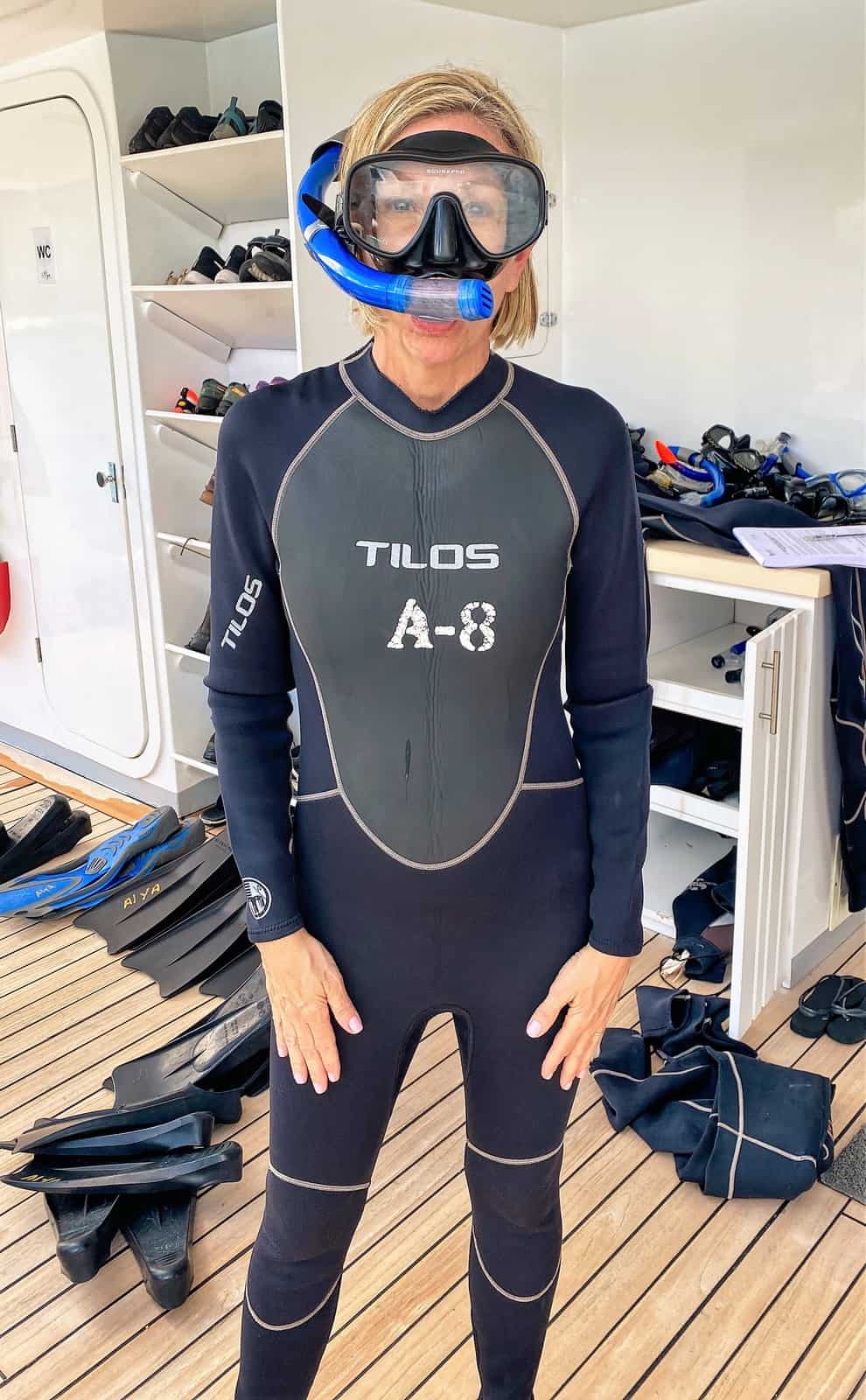
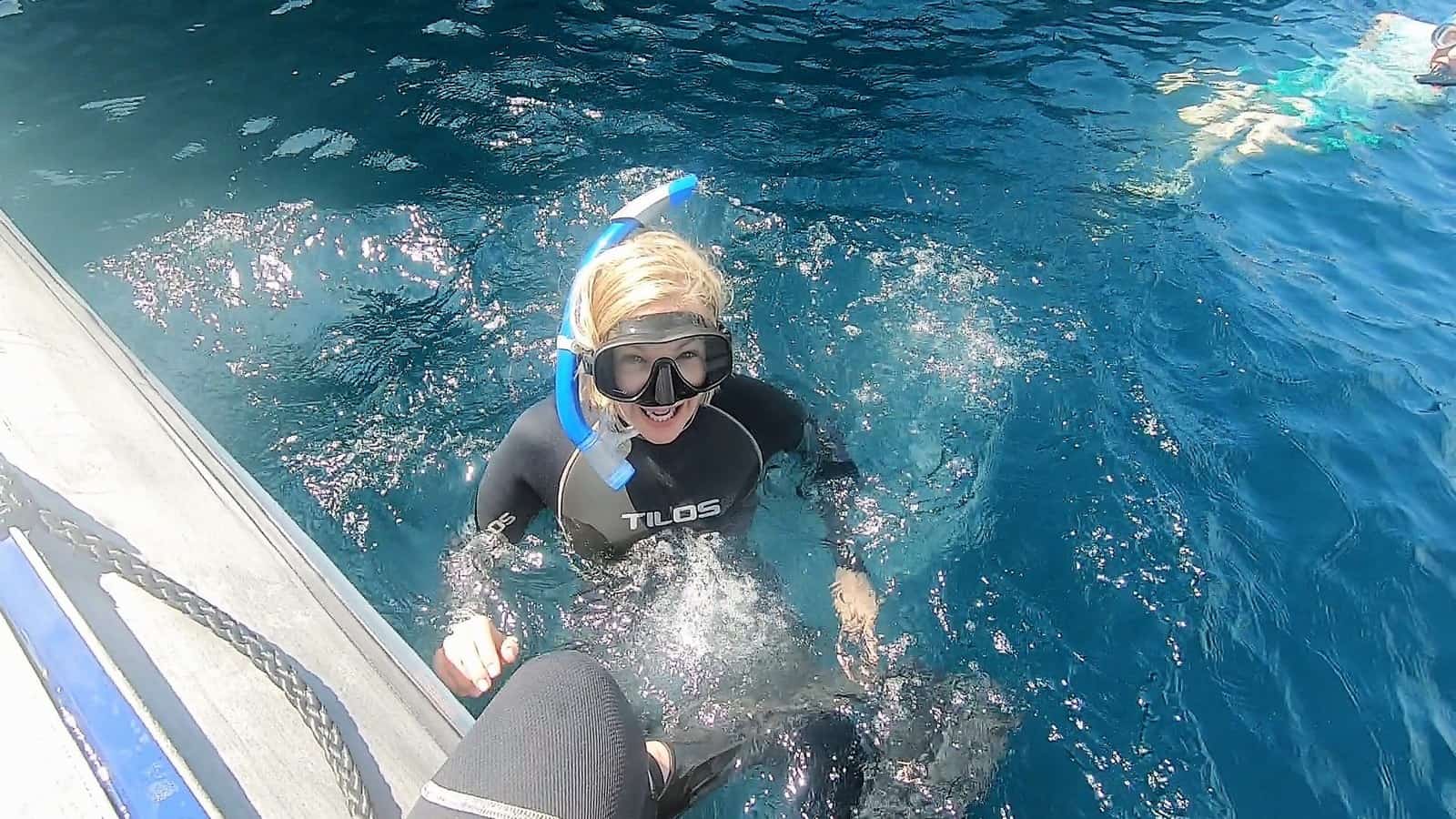
Our naturalist guide snorkeled along with us. In a word, the sea life we saw was amazing!
We saw pretty colored reef fish, including Yellow-tailed Surgeonfish. Dori from the movie Finding Nemo was a Yellow-tailed Surgeonfish.
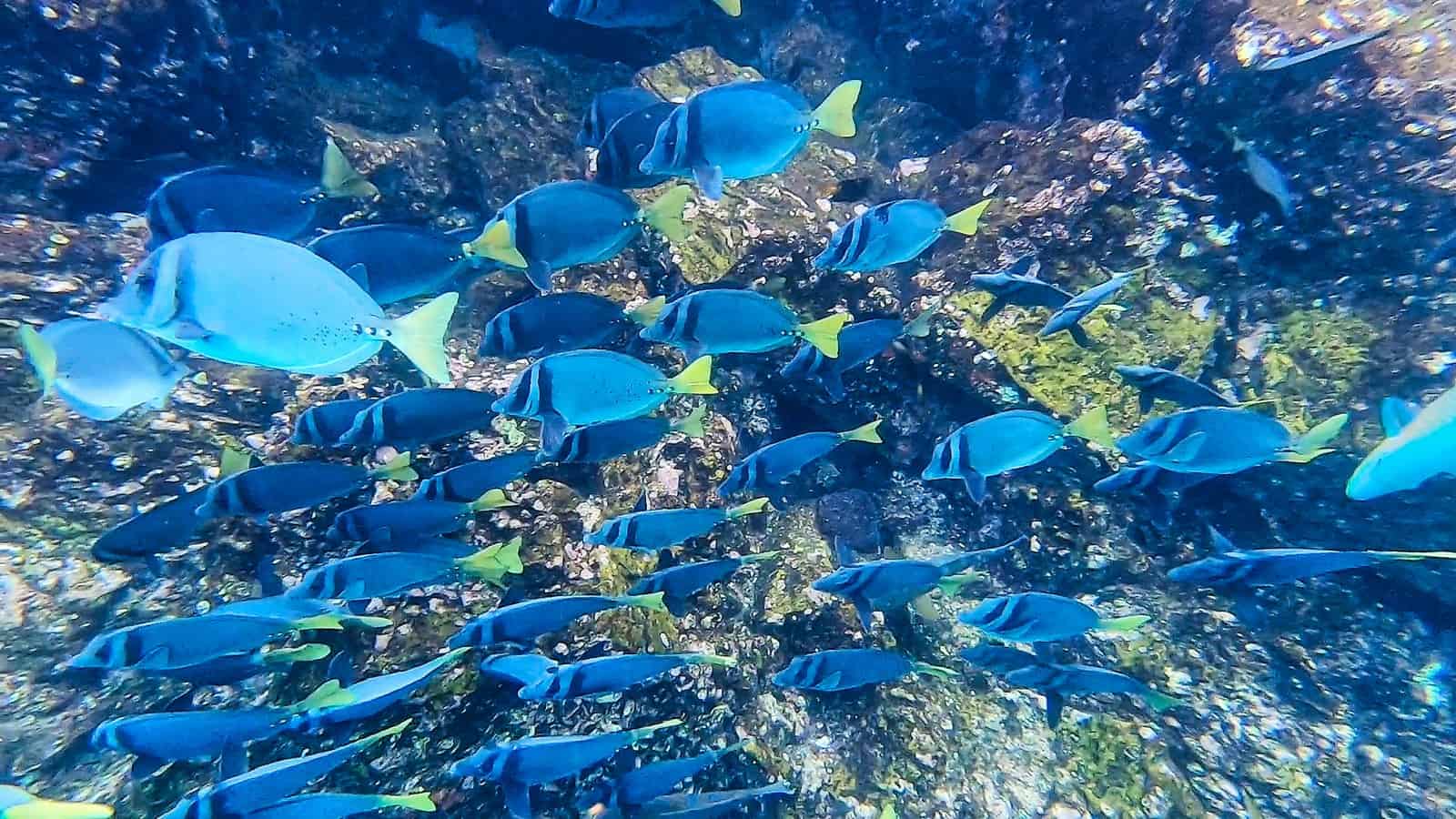
El Barranco or Prince Philips Steps
After a wonderful buffet lunch, we made a dry landing at El Barranco or what is today called Prince Philips Steps. The Duke of Edinburgh, the husband of Queen Elizabeth II, visited this island in 1964, thus giving it a new name. Prince Philips Steps is an area located at the top of the island, which is about 150 feet above sea level.
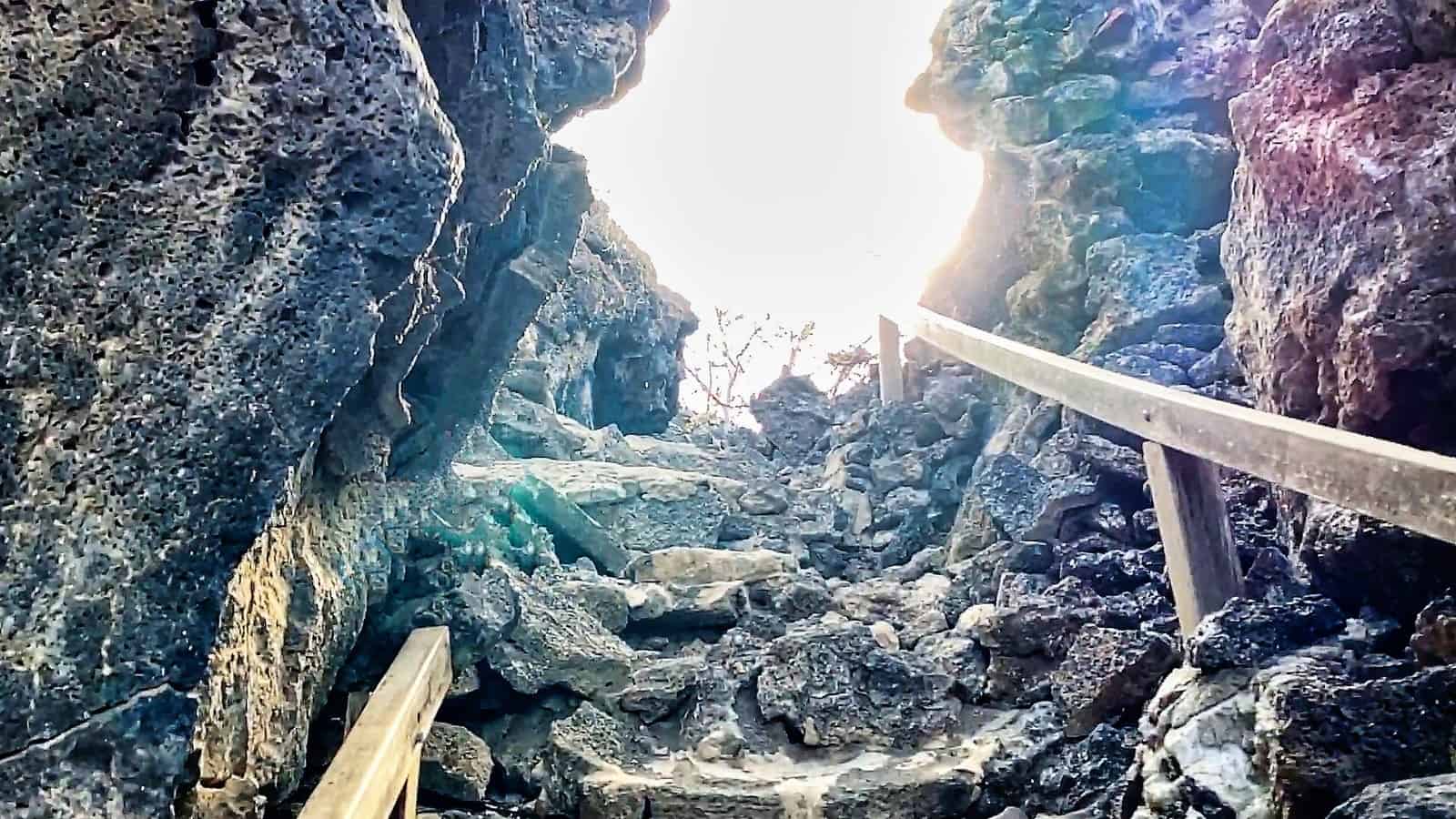
The climb to the top was easy, but we recommend wearing closed-toed shoes for this trip. We saw lots of red-footed boobies, frigatebirds, and gulls. Also, there were small marine iguanas. At the top of the climb was an extensive flat dried lava field. Undeniably, the landscape was impressive and our vantage point allowed us to get a better view of the caldera, our landing spot on the island.
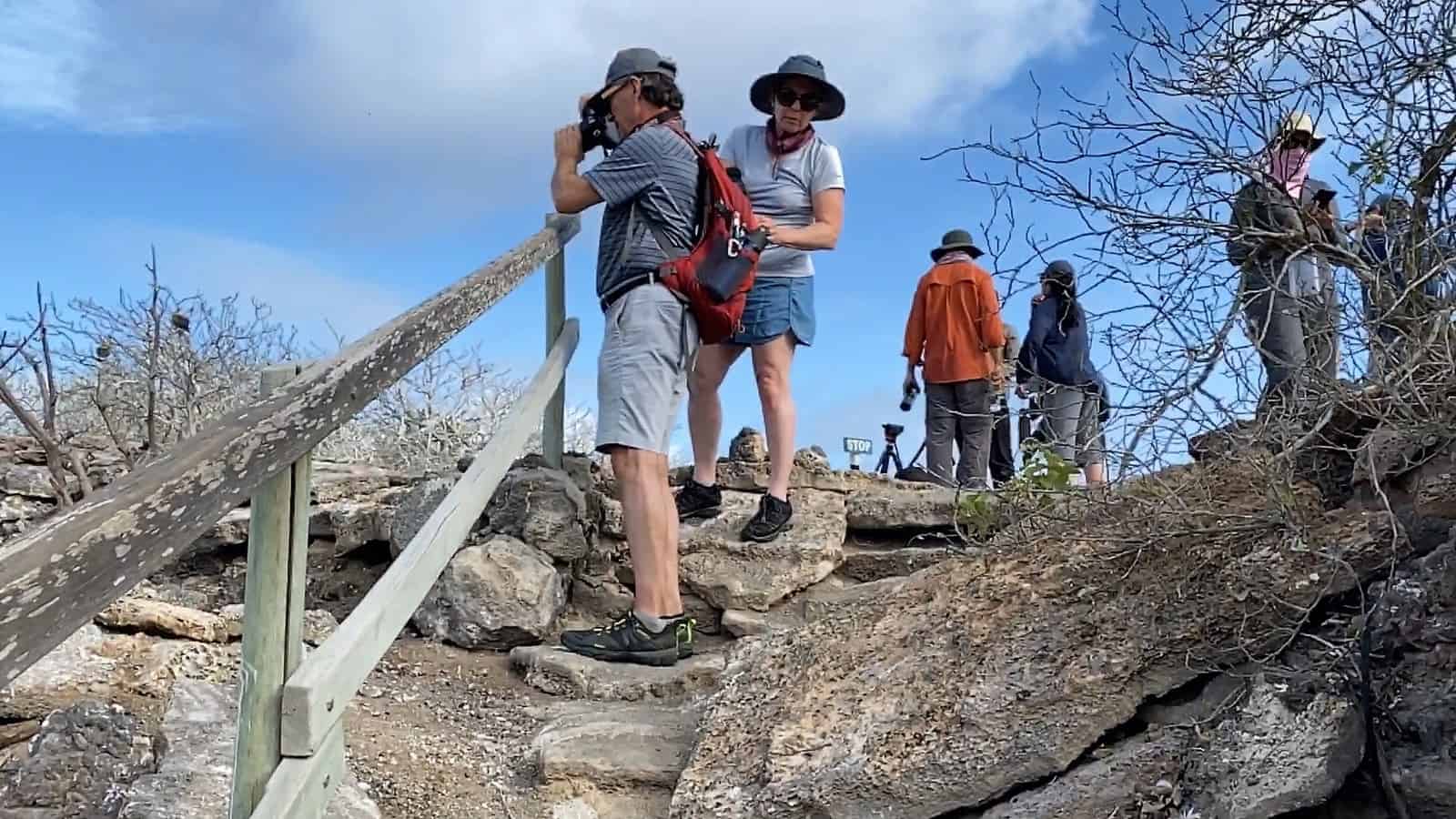
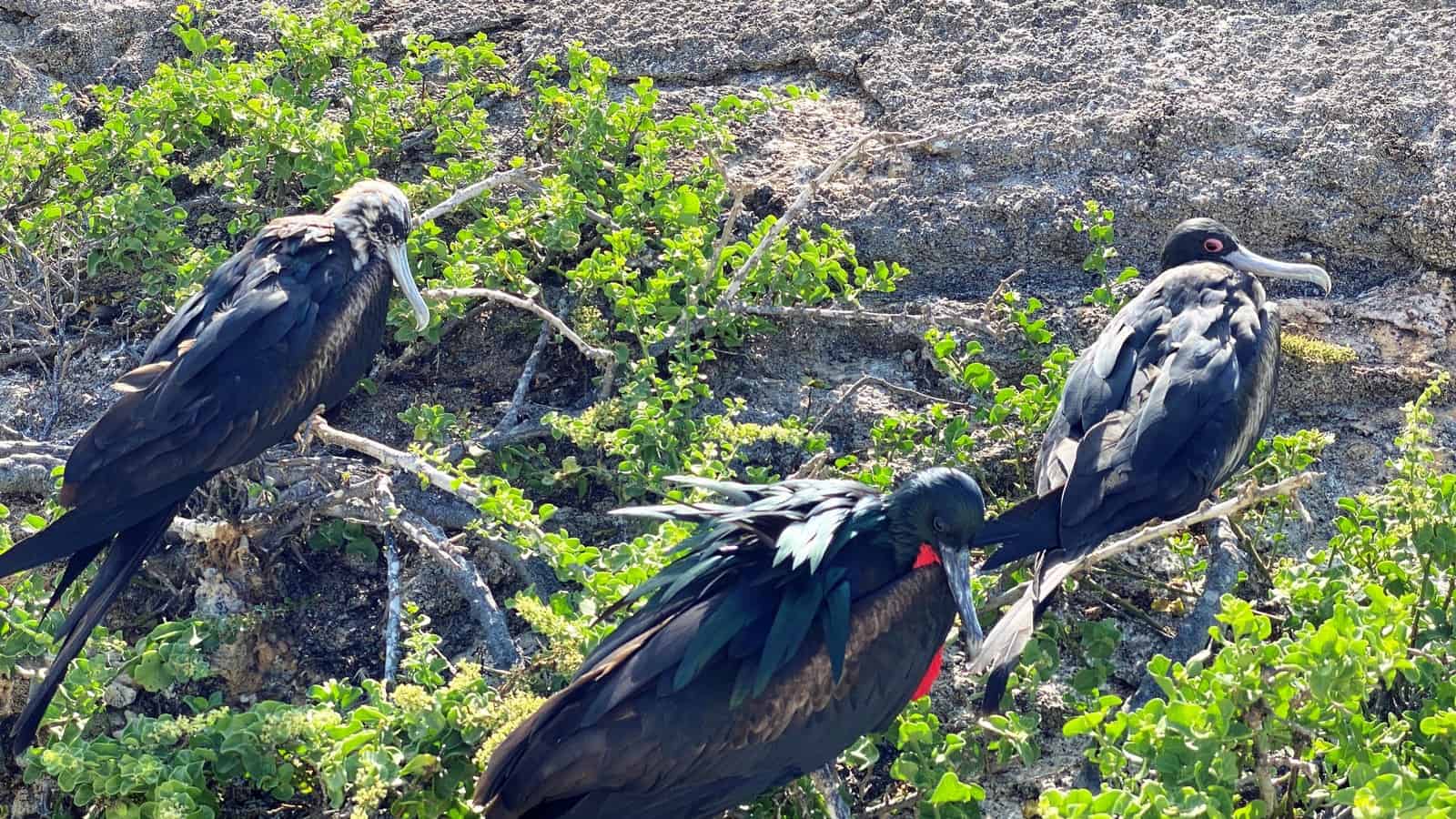
Additionally, we spotted a Galapagos short-Eared Owl, which is endemic to the islands. Most owls hunt at night; however, the Galapagos short-eared owl has adapted to hunt in the daytime as well; thus, they avoid competition with the Galapagos hawk. The Galapagos Short-eared Owls can hunt birds much larger than themselves, such as boobies, by striking at the back of the neck.
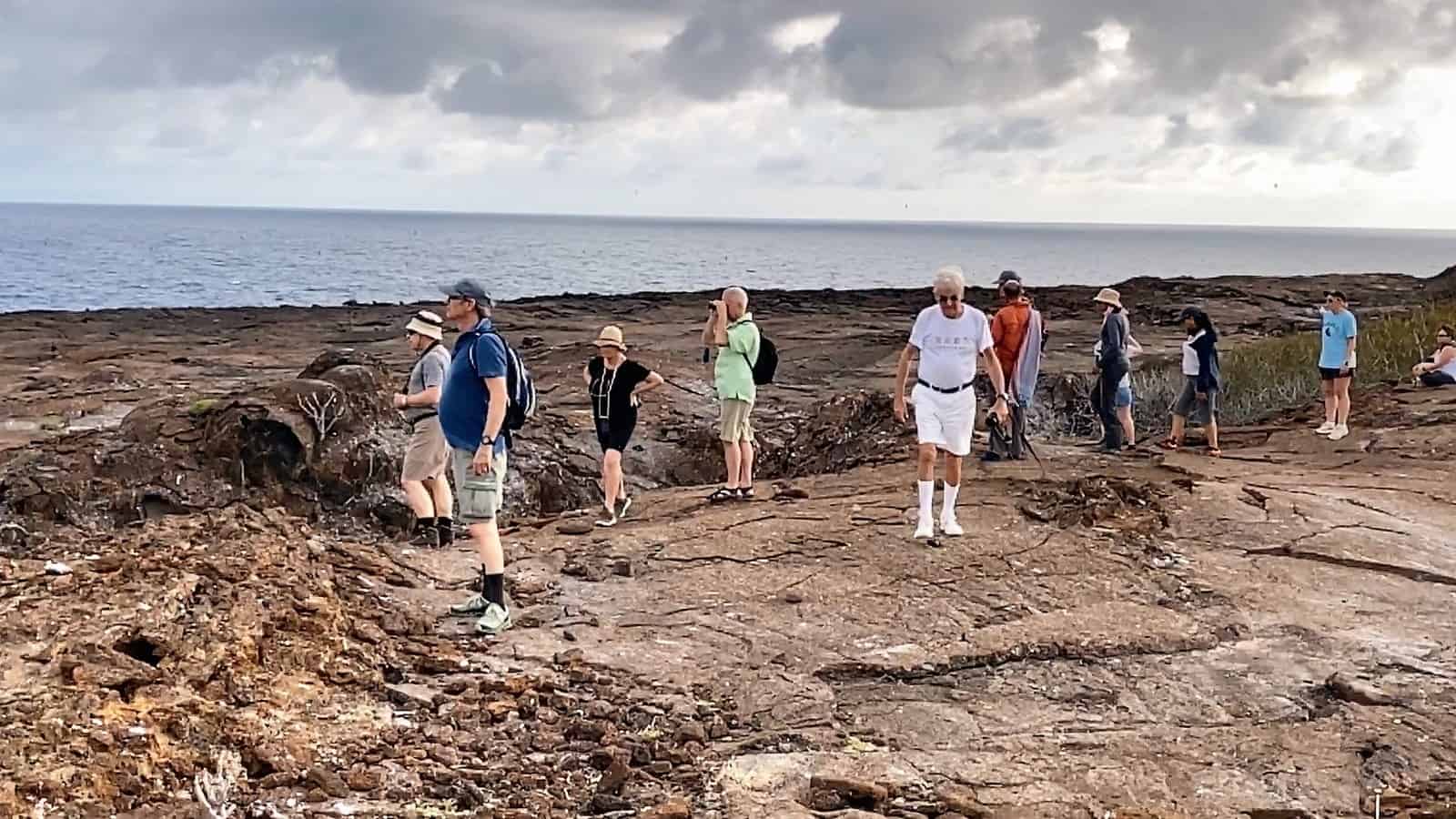
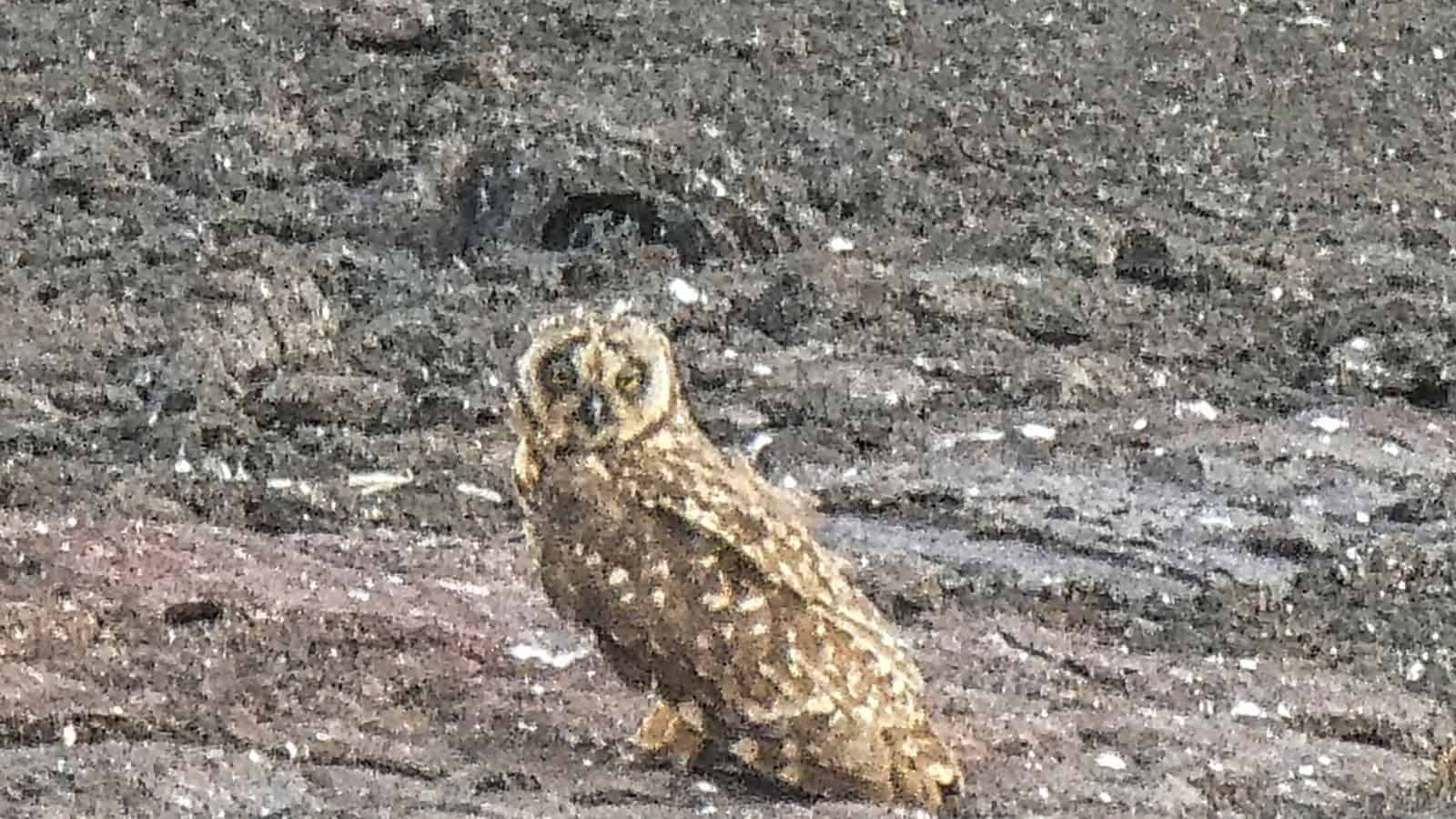
Found Hiding in the Rocks
Surprisingly while on our trek back to the panga, I was looking for more owls, and I found a young Red-billed Tropicbird waiting for its mom to return in a hollow lava tube. Everyone else on the island was curious to see what I was photographing.
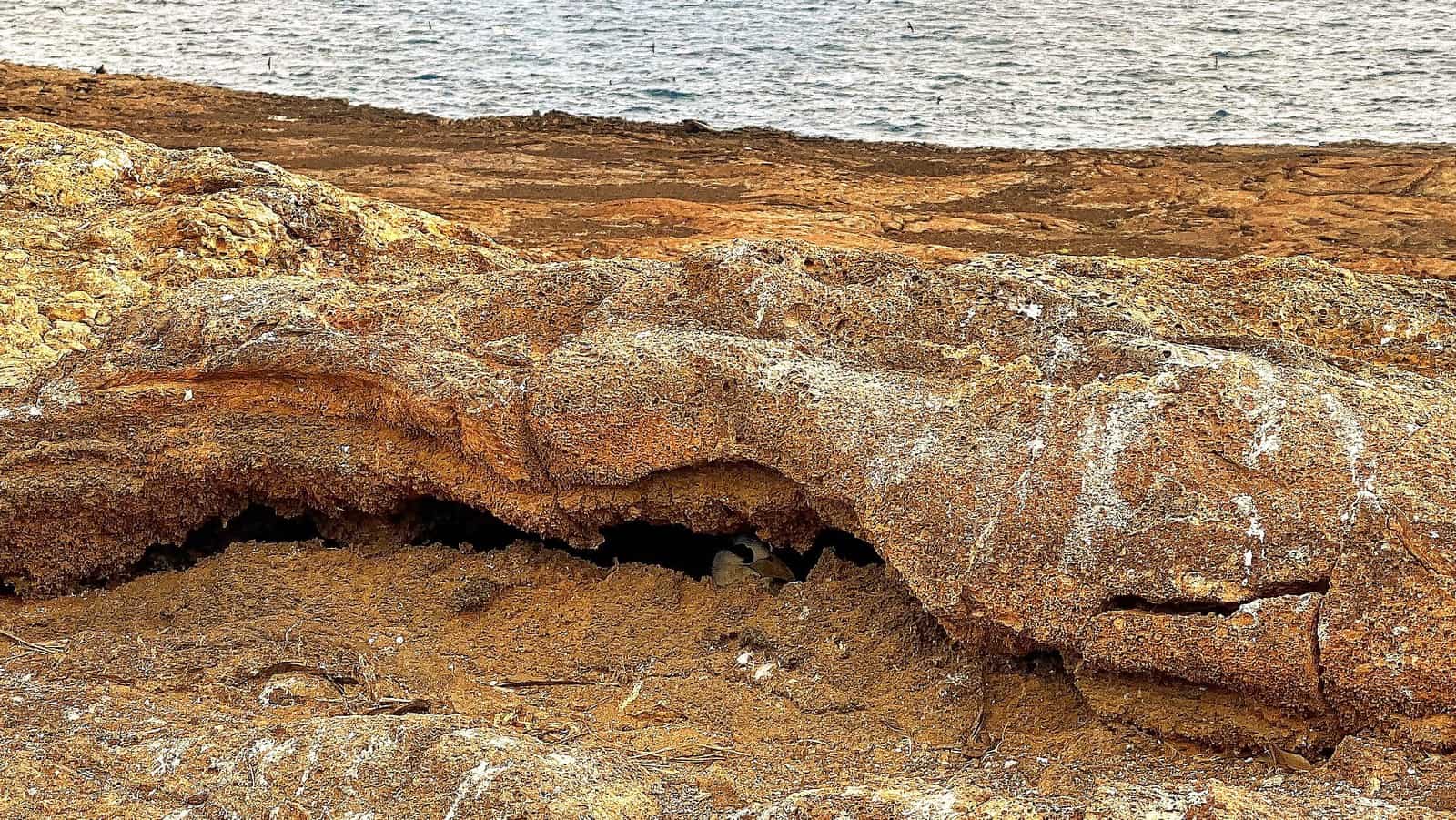
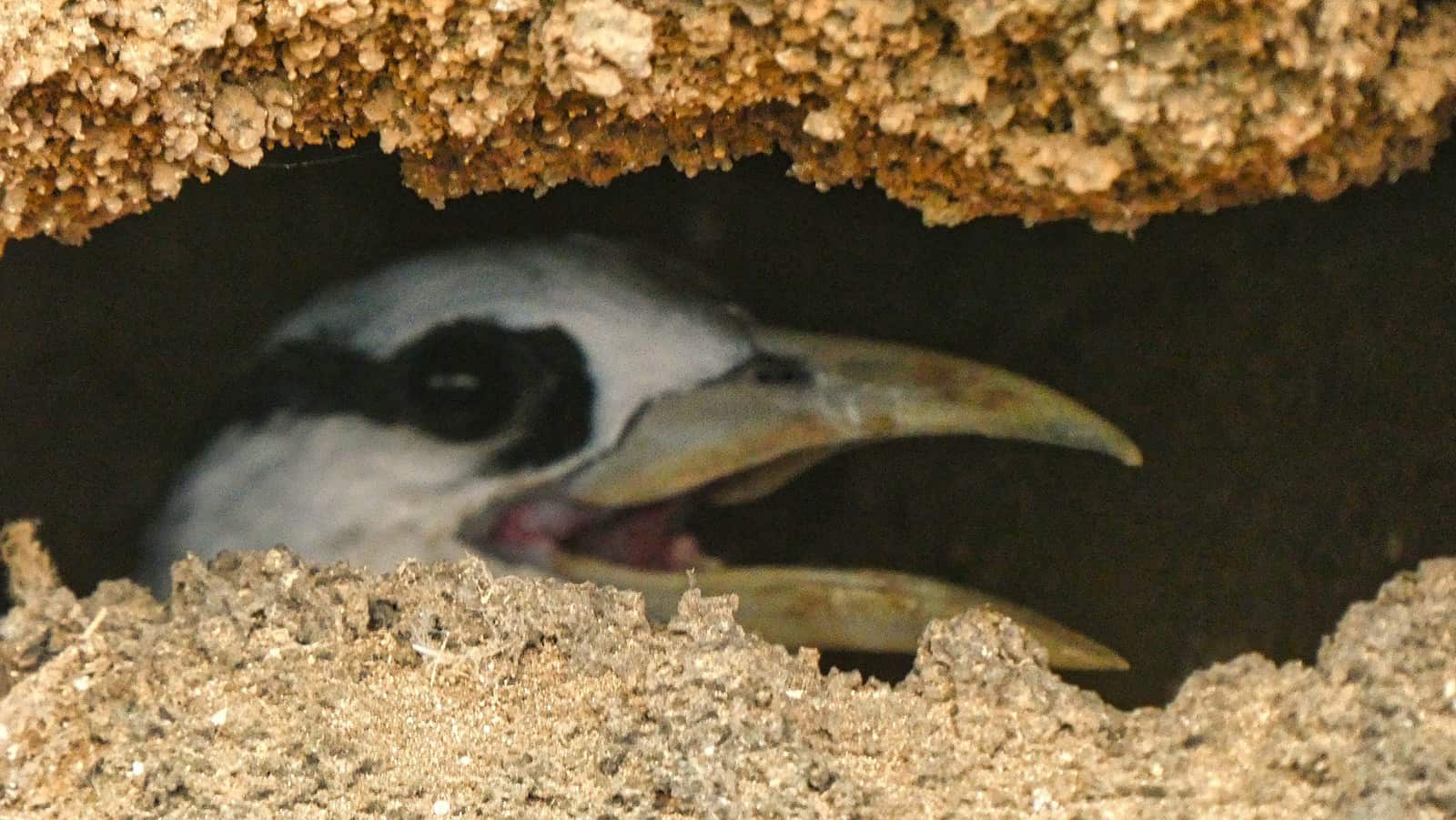
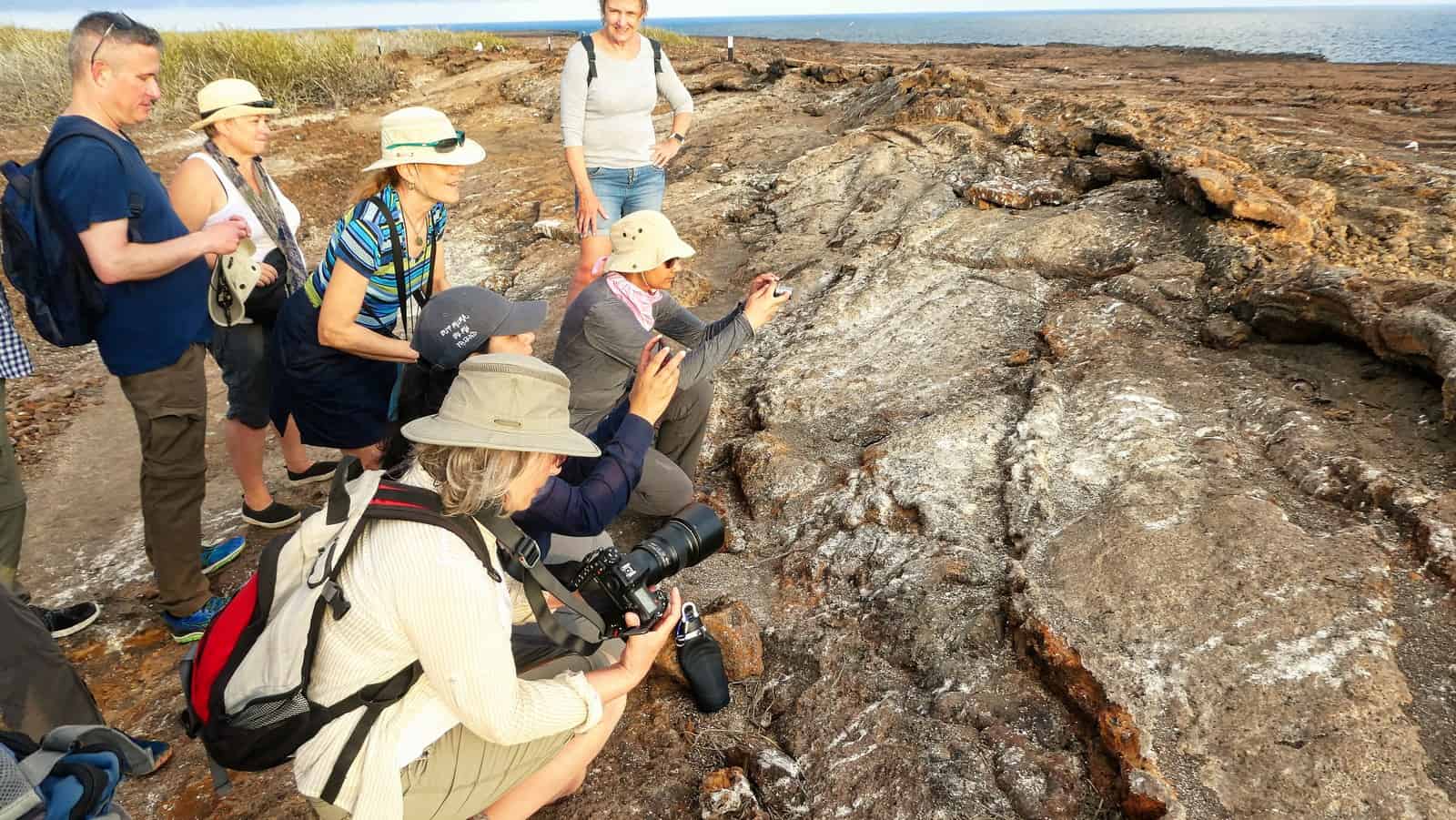
Every time we arrived back on board the ship, a crew member was waiting with cold wet washcloths, juice, and a freshly made snack. Furthermore, our room was cleaned and some impressive towel art was placed on the bed.
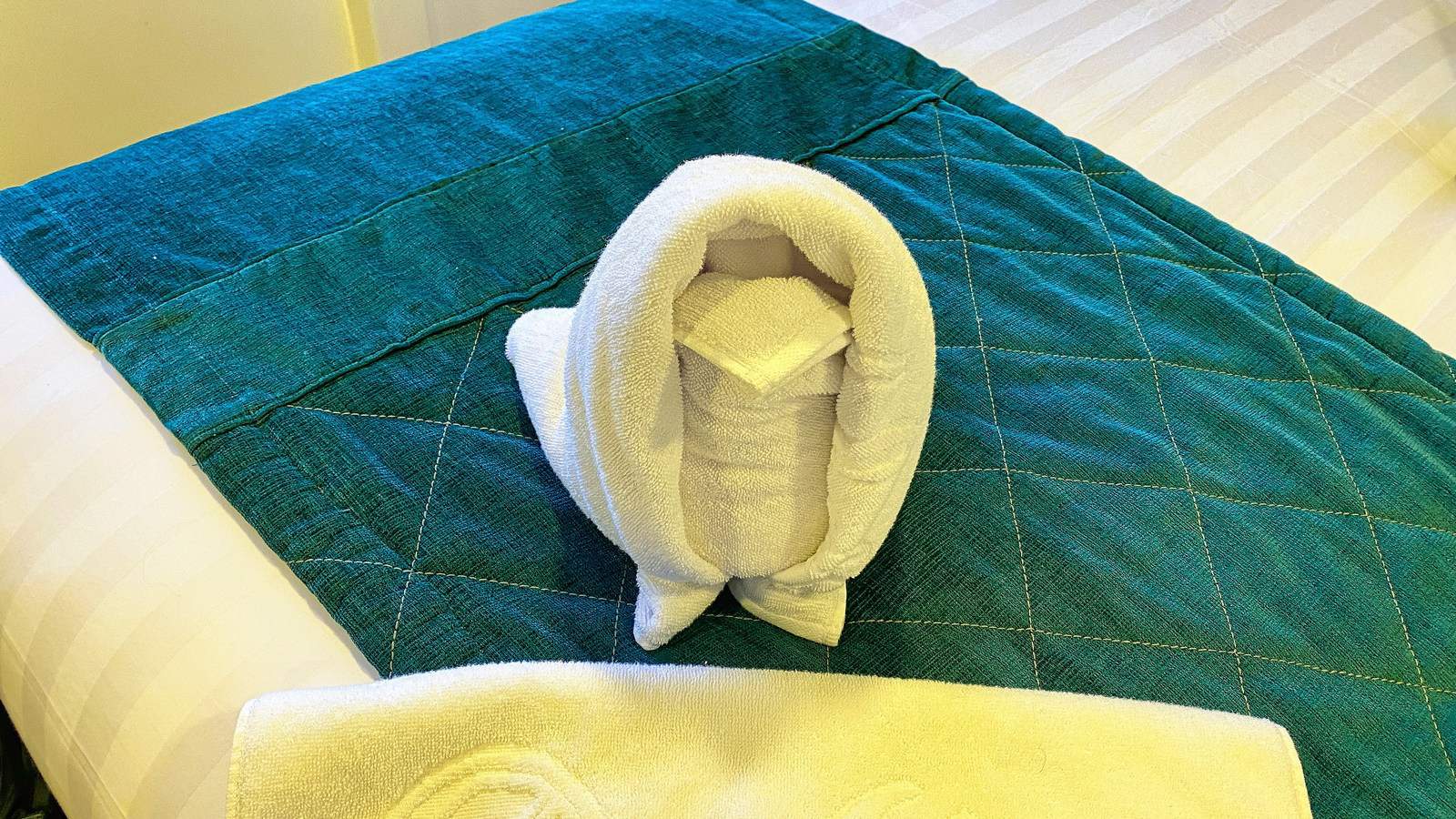
Tonight was the night where the ship would be crossing over the equator. So, the captain offered everyone to visit the bridge at a specific time to get a picture of the compass when it read 0 degrees latitude. Keith said that in his US Navy days, when a sailor crossed the equator, he went from a pollywog to a shellback.
The evening we came back across the equator, the crew dressed as pirates, and we played a charade game where you had to act out a Galapagos animal. Afterward, we had an island drink and did a conga line dance.
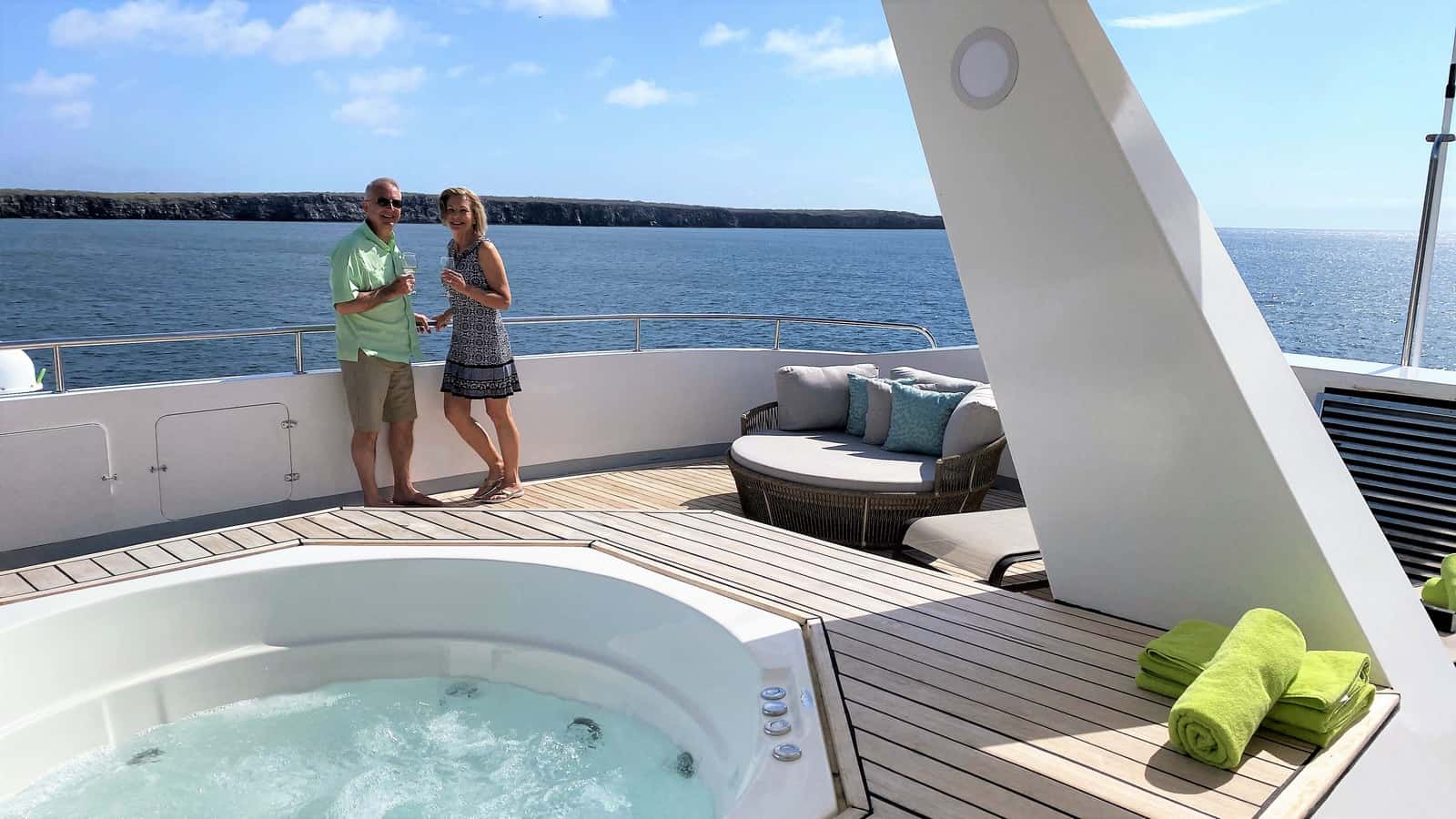
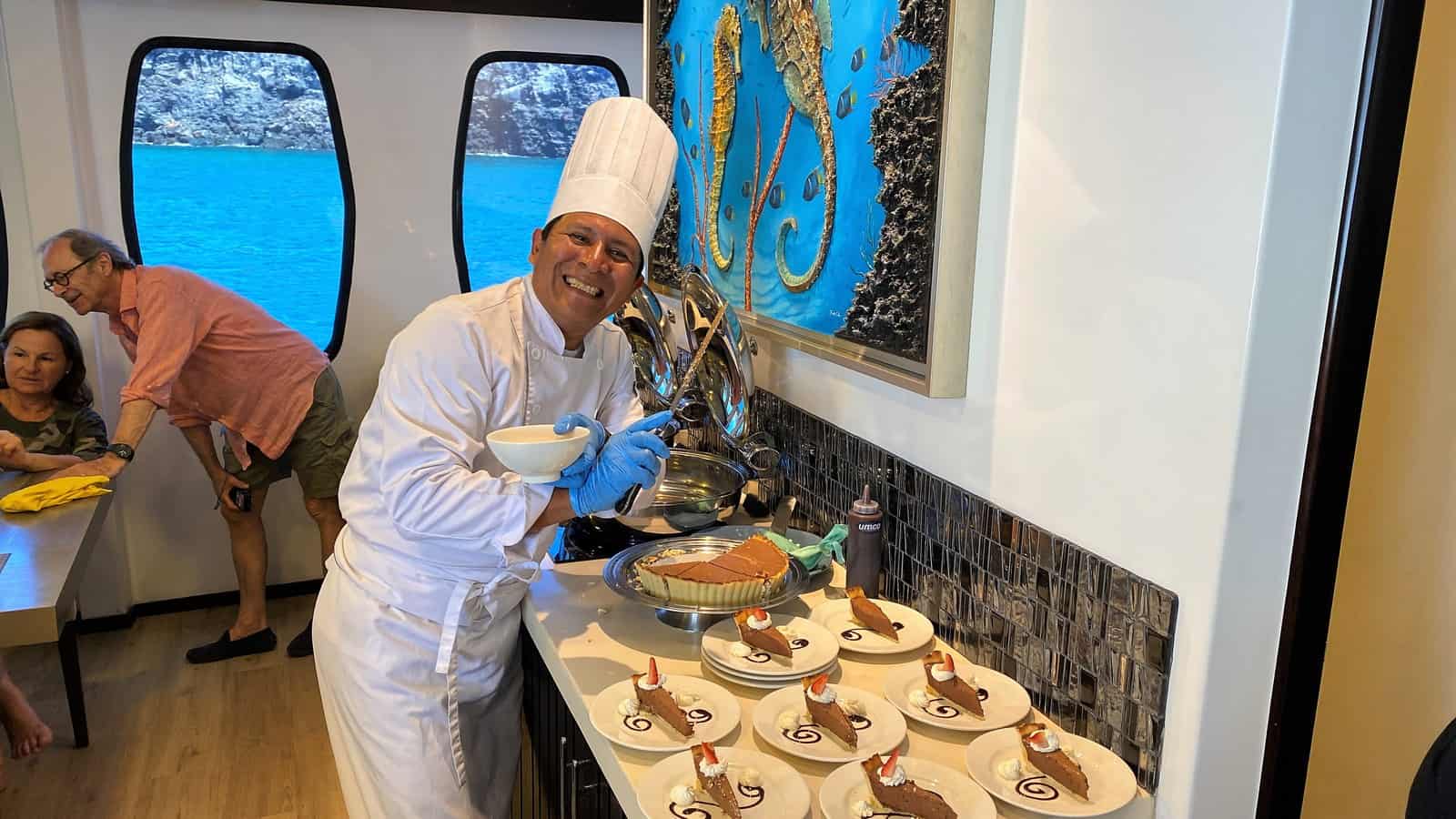
Sullivan Bay on Santiago Island
Day 3 began with a fascinating volcanic site named after Bartholomew James Sullivan. He was the first lieutenant on HMS Beagle, the ship that brought Charles Darwin to the Galapagos.
The landscape formed only 150 years ago is quite eerie yet stunning. Hence Sullivan Bay is the perfect place to see and feel the volcanic origin of Galapagos.
There is not much plant life on this island, but we saw one of the most beautiful cactus we have ever seen. It is called the Lava Cactus. There is a walkway to an upper overlook where you can see around the entire island. Markedly, it’s a great place to view Pinnacle Rock.
We visited this area in the early morning because the temperature is more pleasant and the light was better for photographs.
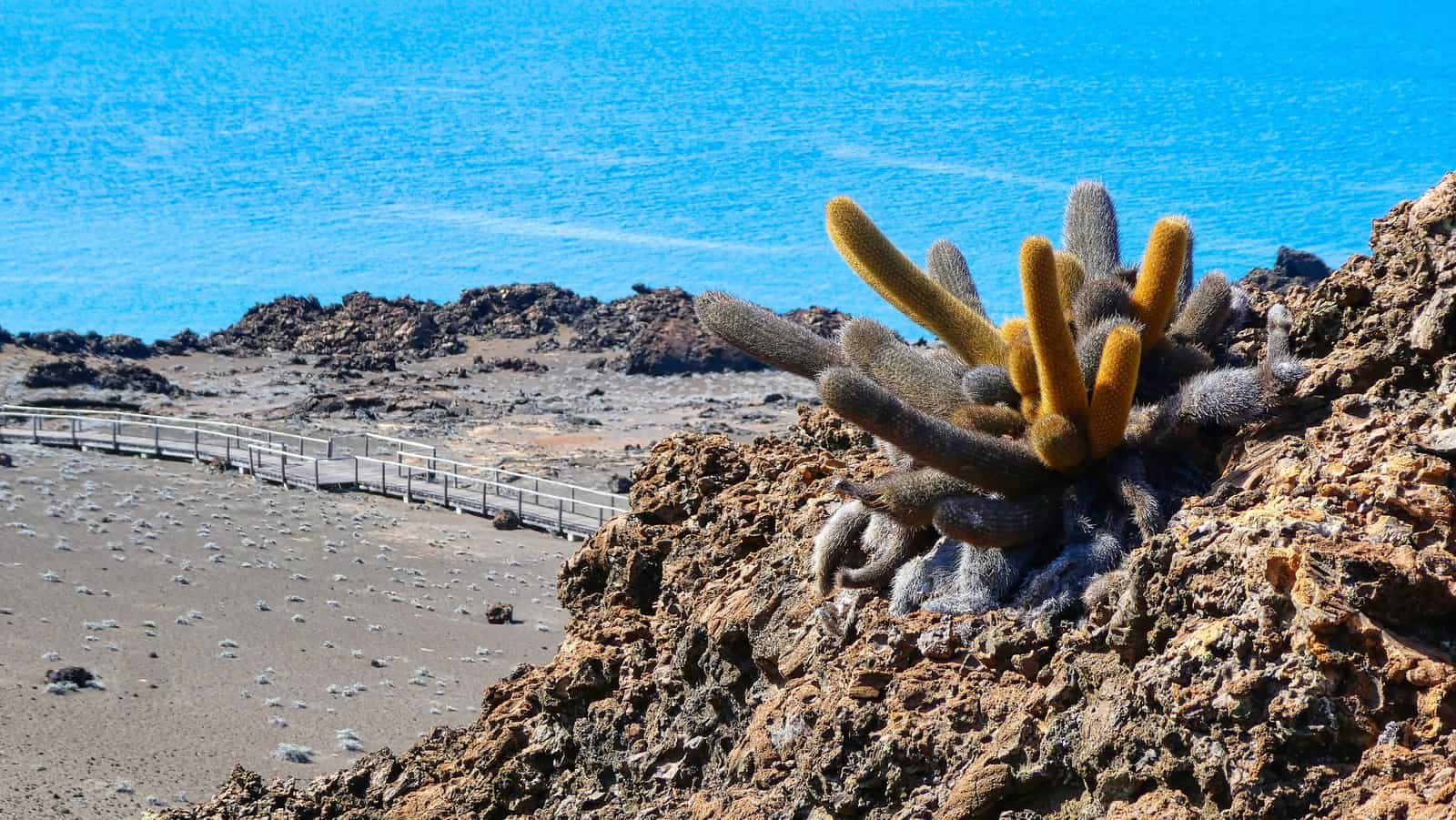
Bartolome Island
In the afternoon, we made a dry landing on Bartolome Island. Bartolome Island consists of an extinct volcano and a variety of red, orange, green, and sparkling black volcanic formations. The island is small, just a half square mile. Without a doubt, this island offers some of the most beautiful landscapes in the Galapagos.
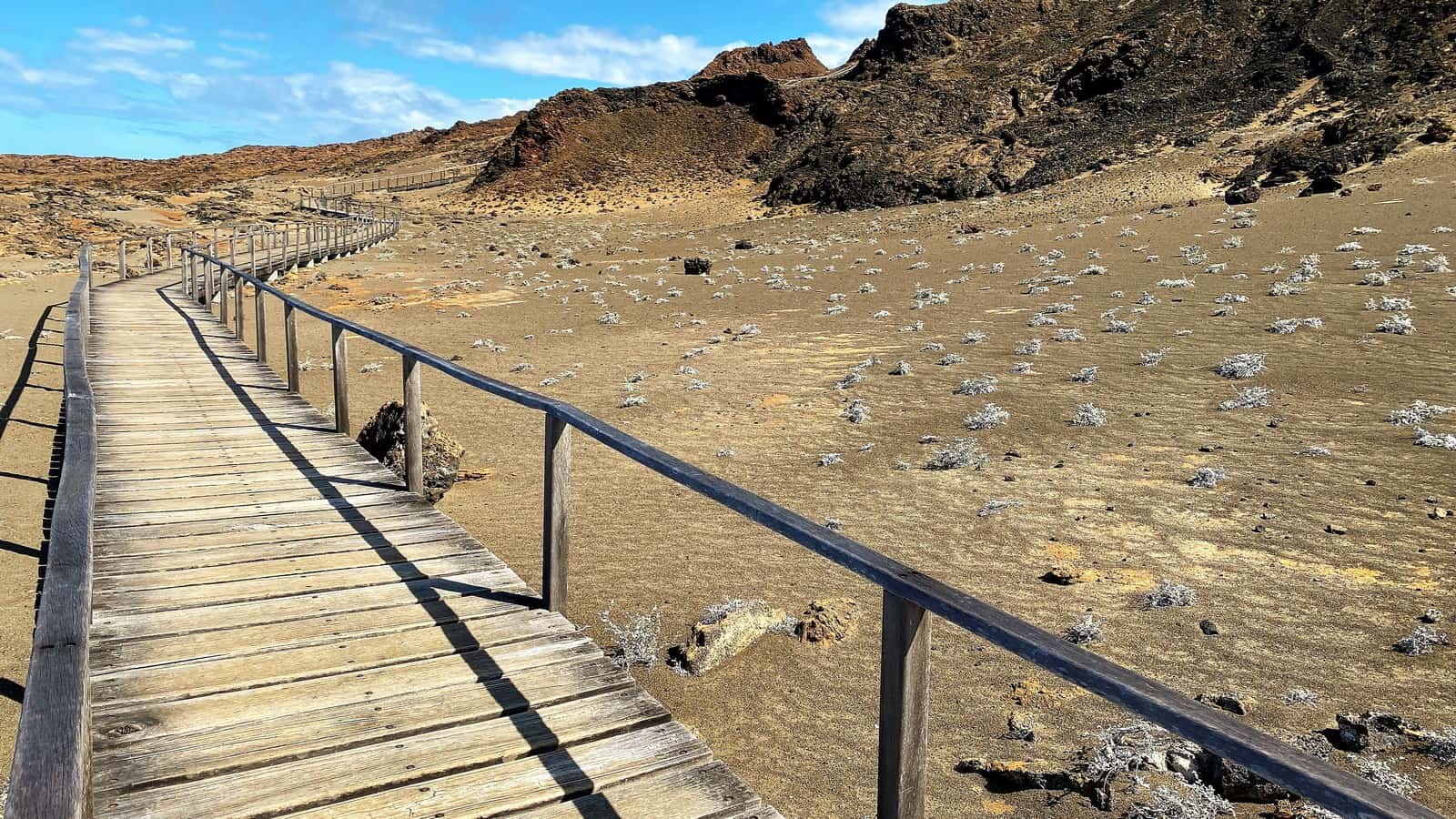
Bartolome has a volcanic cone that is easy to climb and provides great views of the other islands. There are a wooden trail and stairs that lead through volcanic lava to the summit. Moreover, the landscape consists of Tiquilia galapagoa plants which are endemic to the island and cacti. The tiquilia plant is a mat plant, which to us, looks like a succulent that has adjusted to the dryness. Bartolome has a moonlike landscape. And from the summit, the views are spectacular, including an underwater crater. Making Bartolome one of the most photographed islands in the Galapagos.
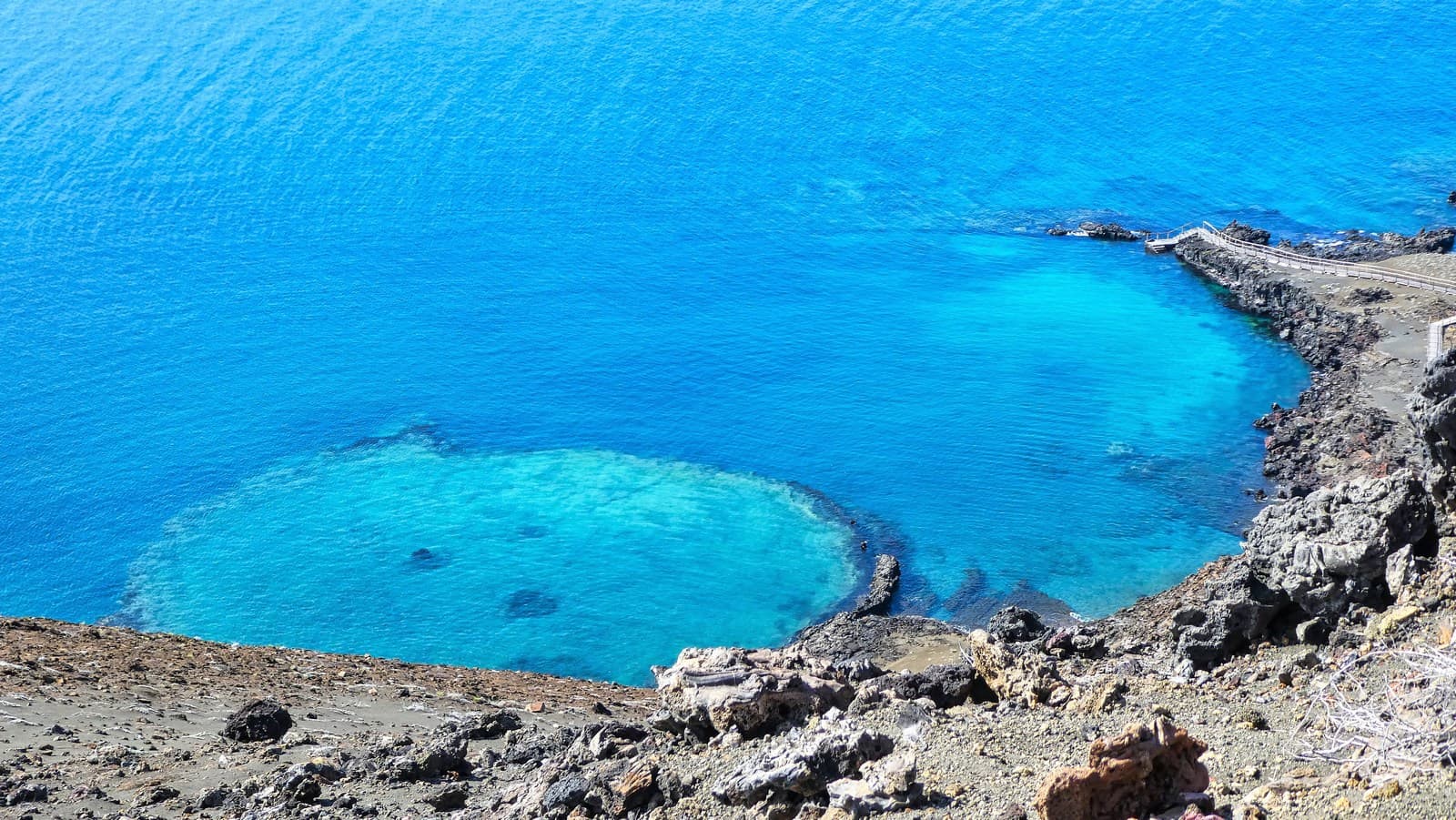
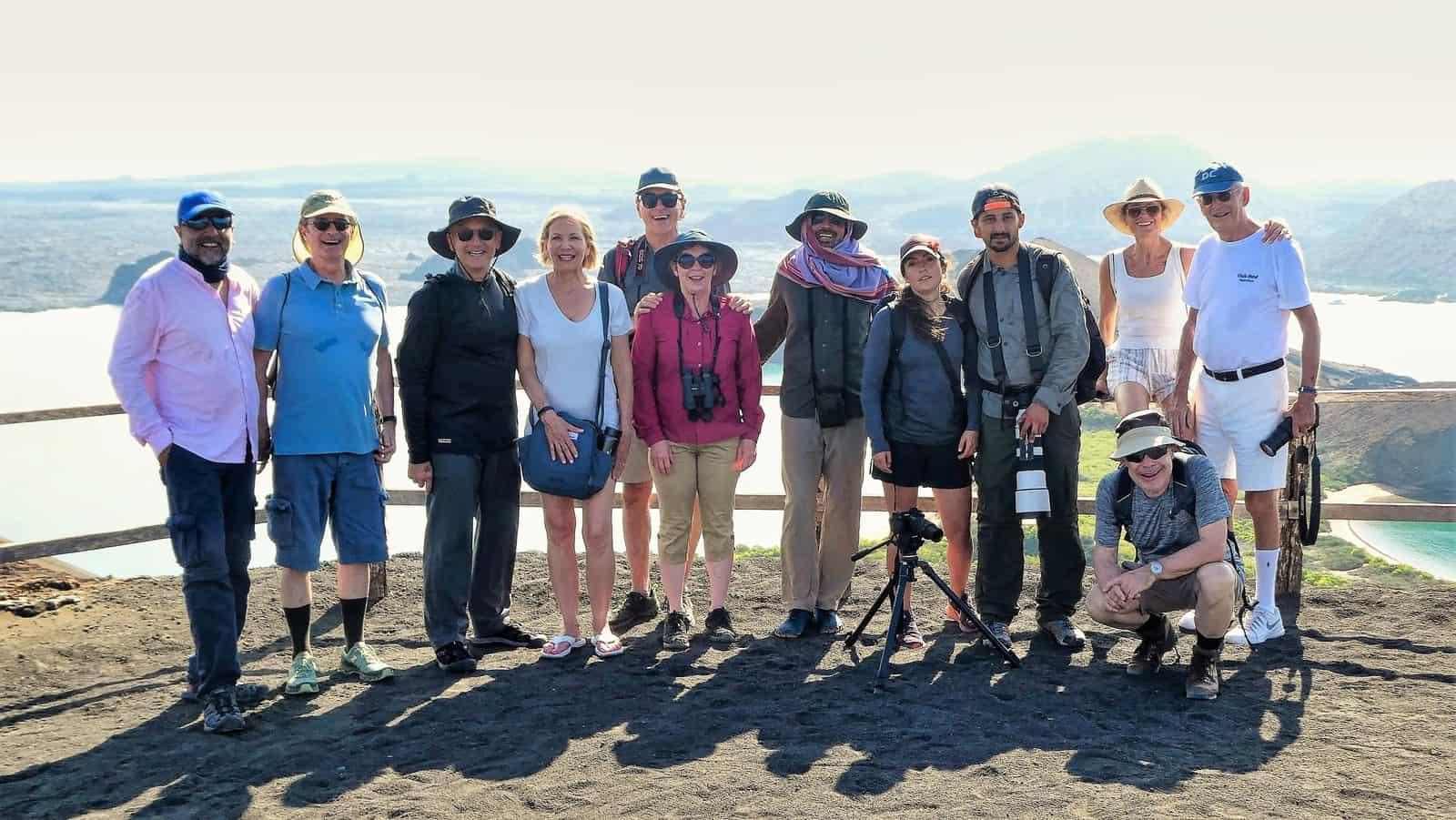
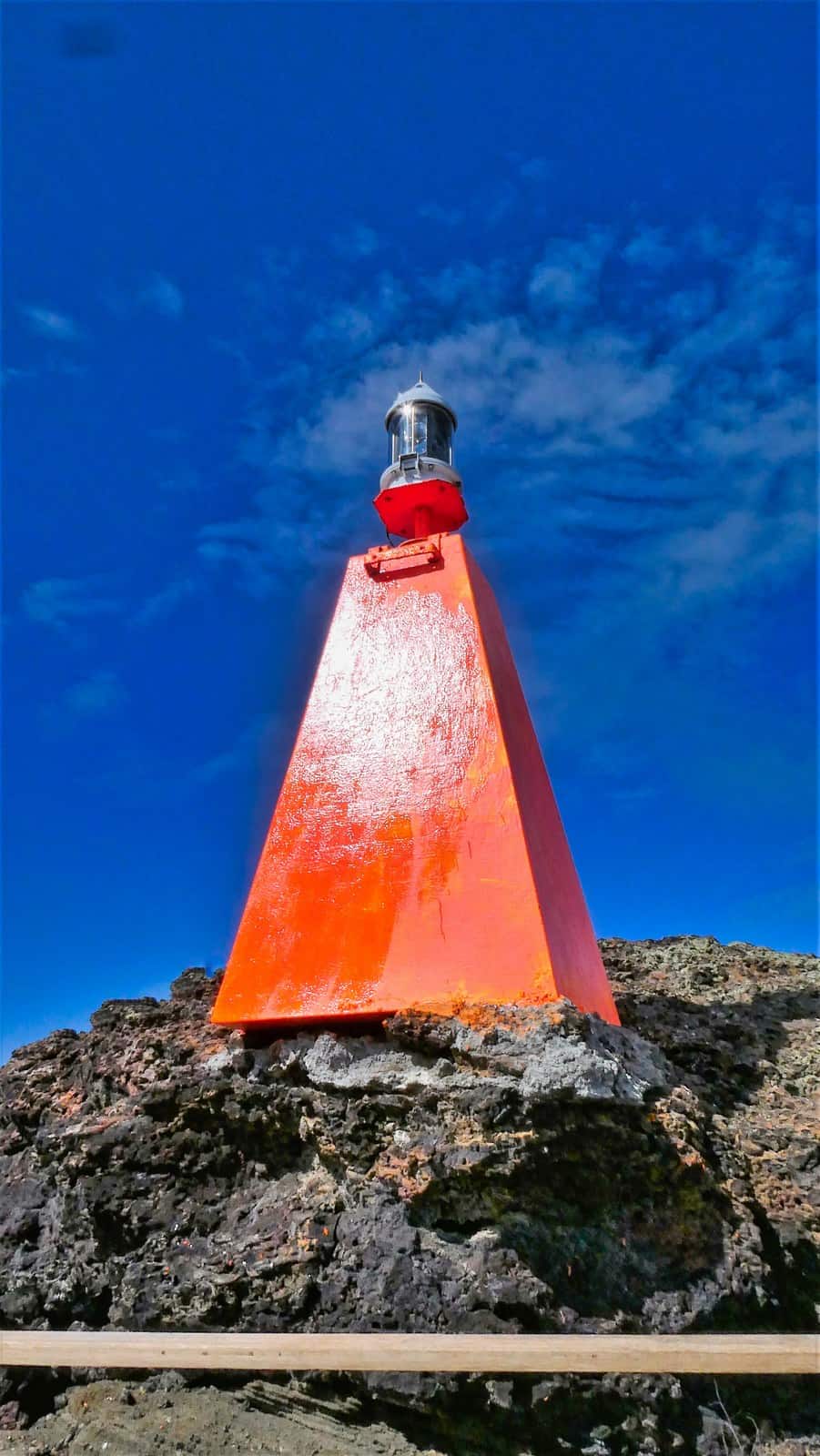
Iconic Pinnacle Rock
Bartolome is famous for its Pinnacle Rock, which is the distinctive characteristic of this island, and the most representative landmark of the Galápagos. Pinnacle Rock formed as magma came up from an underwater volcano. The sea cooled the hot lava, which then exploded and came together to form this huge rock. Likewise, a picture of Bartolome with Pinnacle Rock is the iconic picture of the Galapagos.
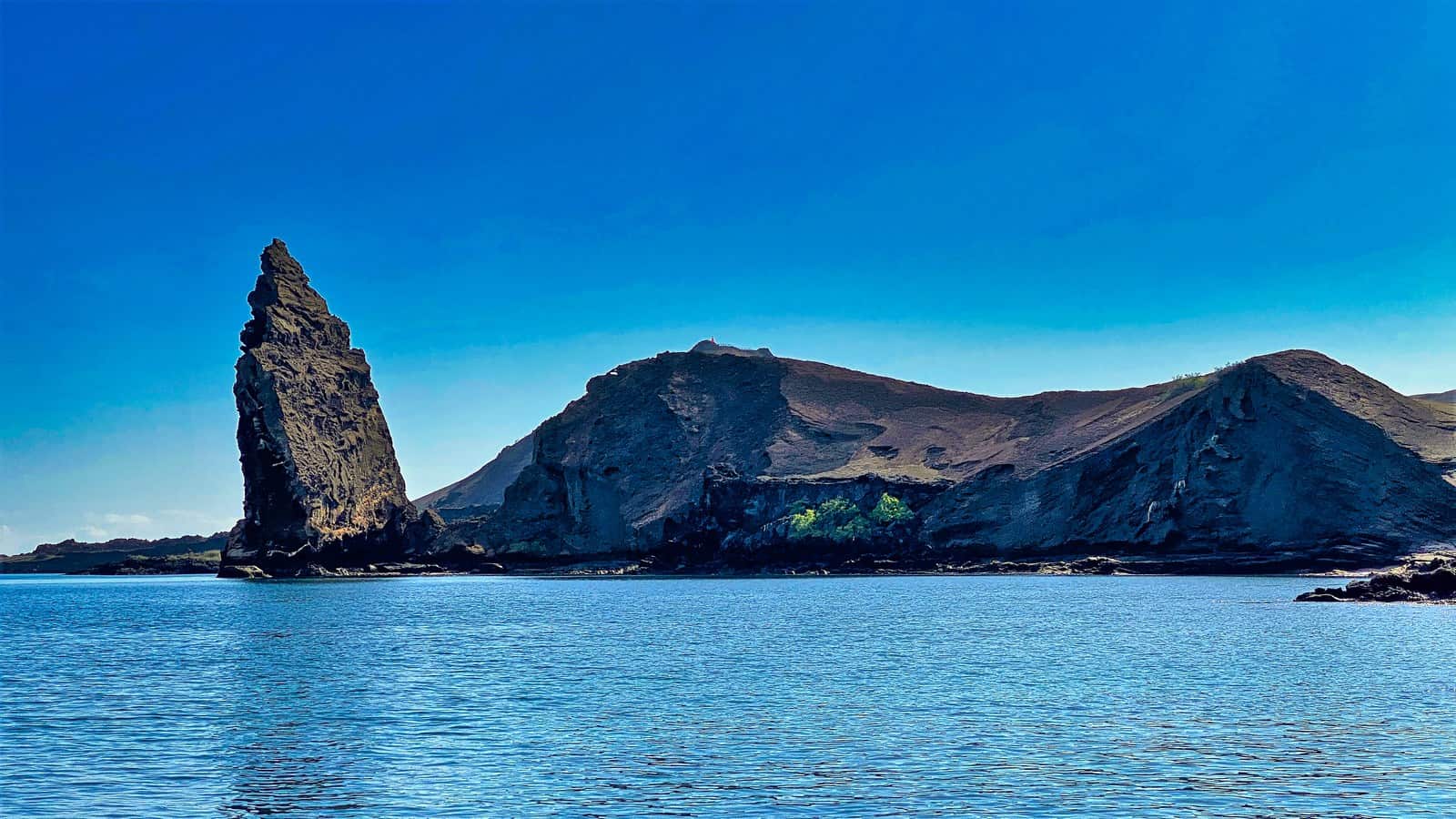
A fun but sad fact depending on how you look at it: US airmen used Pinnacle Rock during WWII for target practice. Despite this, however, the rock remains unchanged.
Many animals, especially marine species, can be seen around this island because very cold water surrounds the shore and provides food. We saw penguins, sharks, herons, rays, lava lizards, and even a Galapagos hawk.
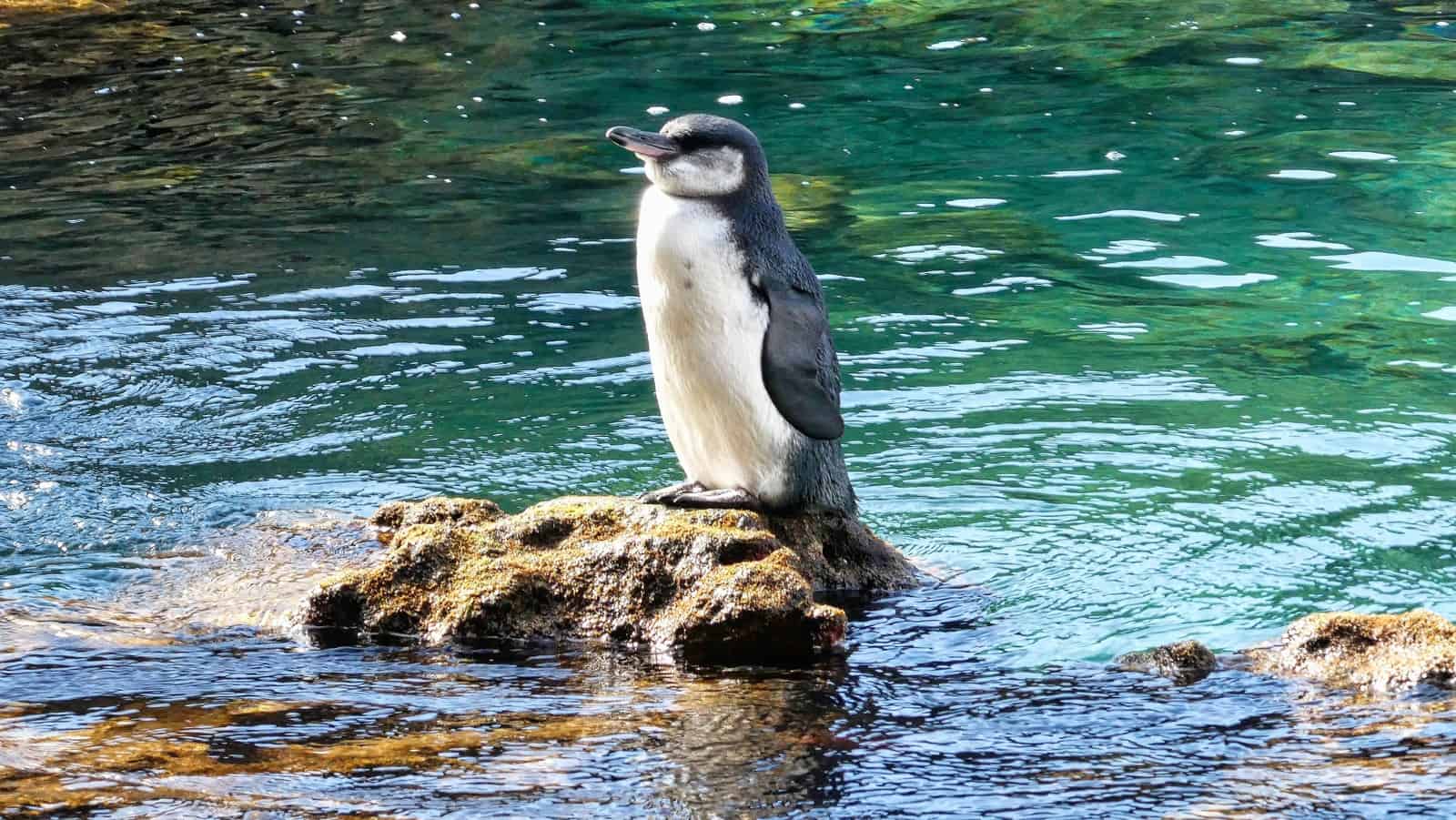
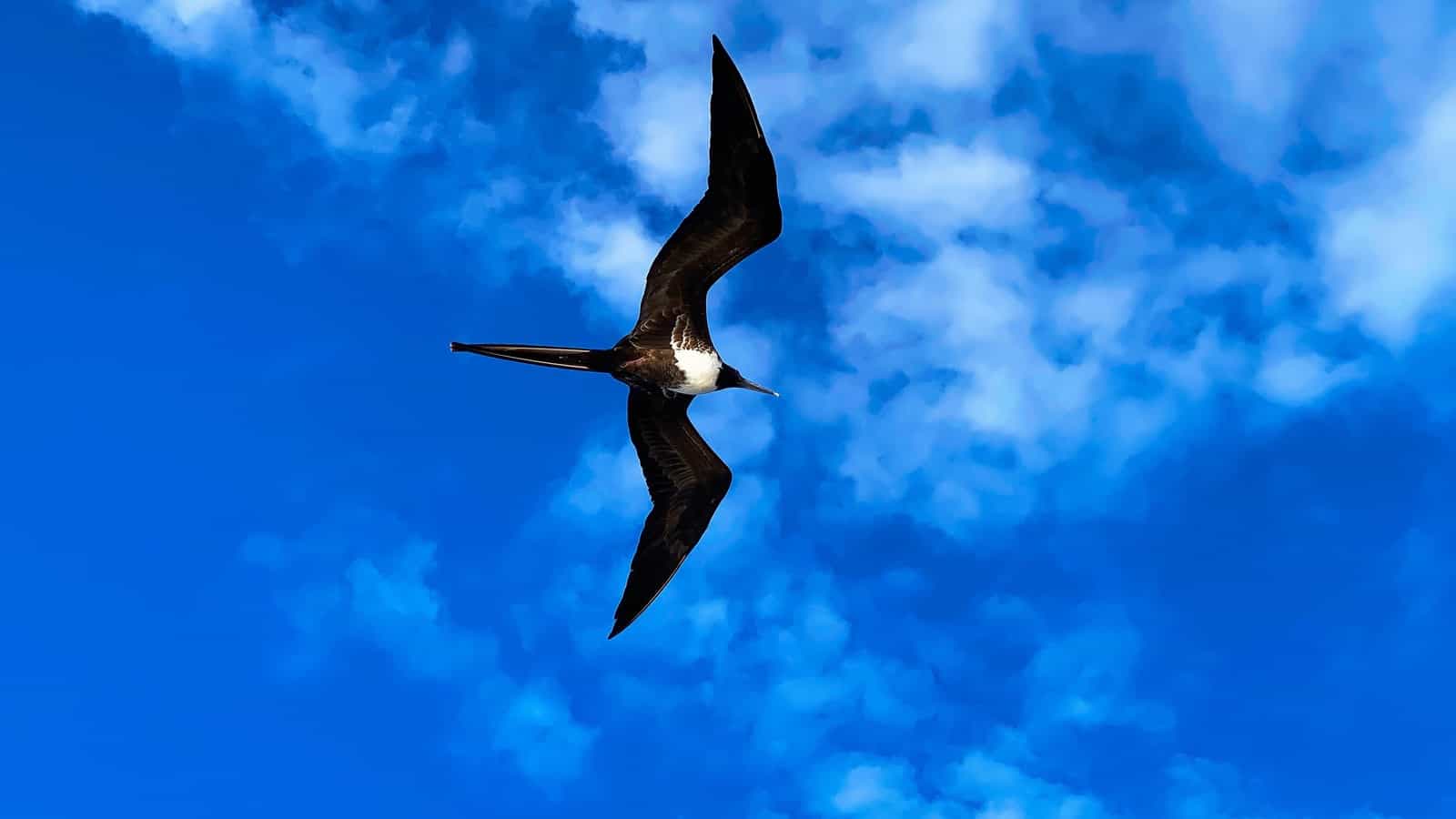
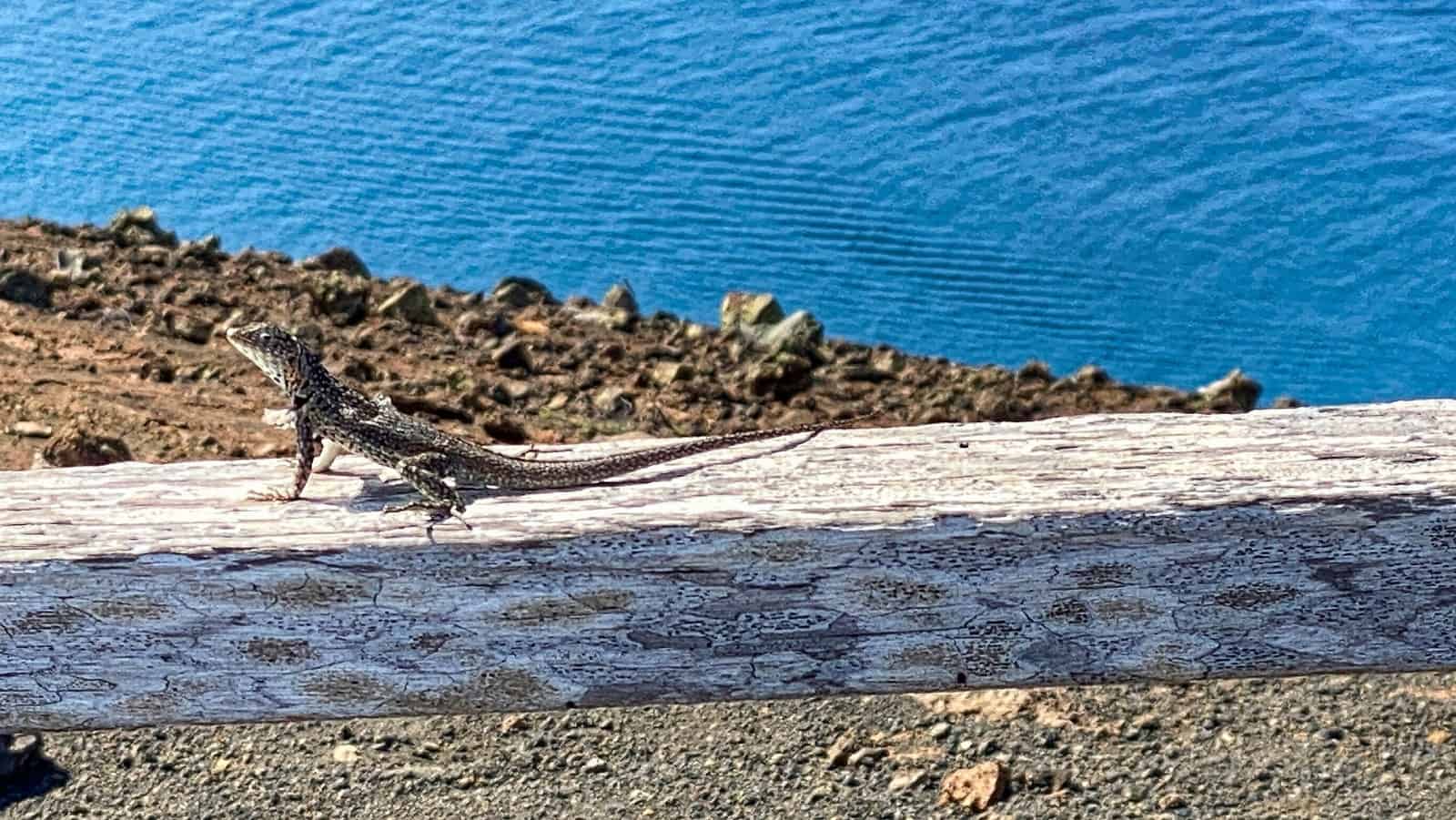
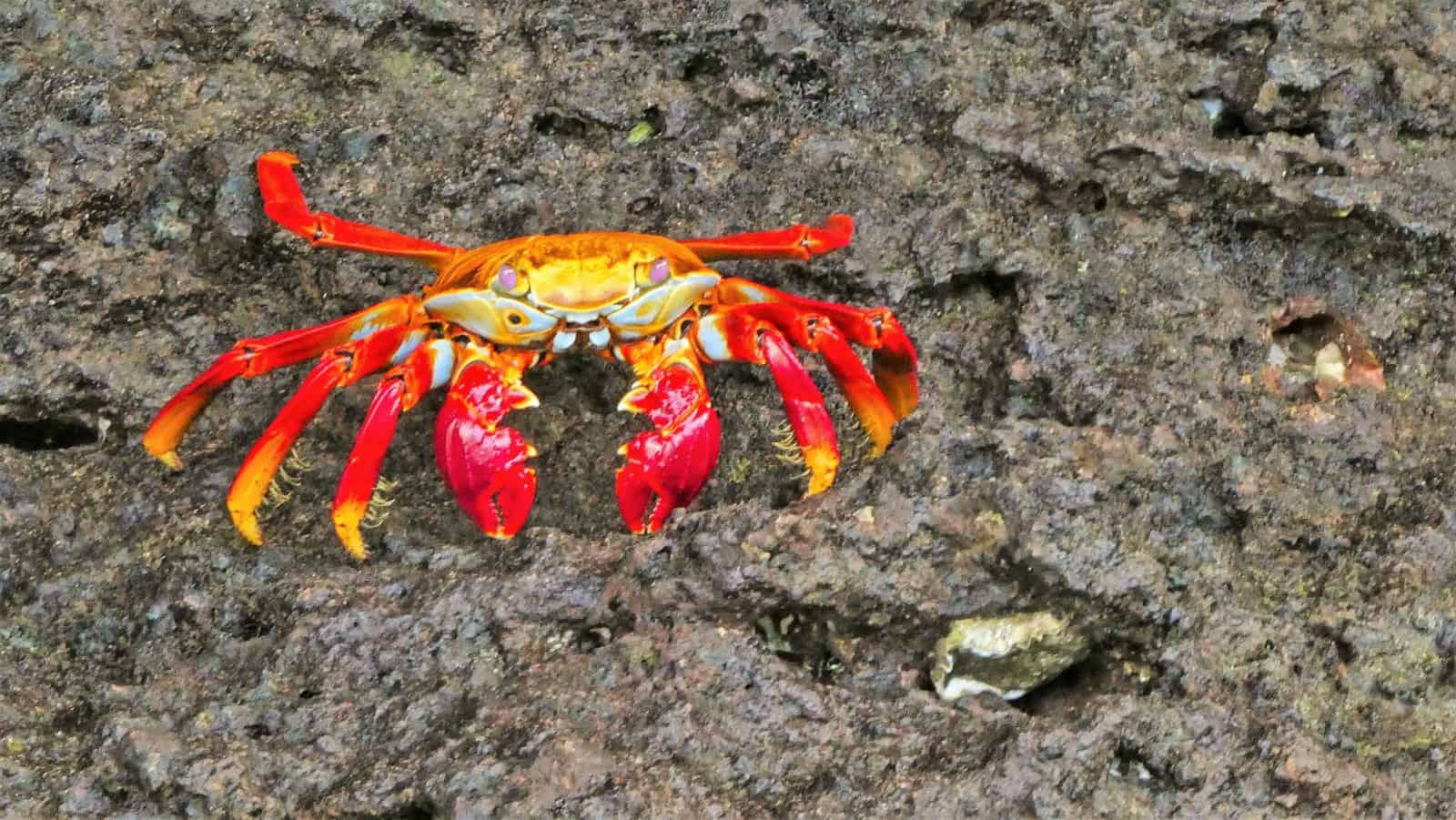
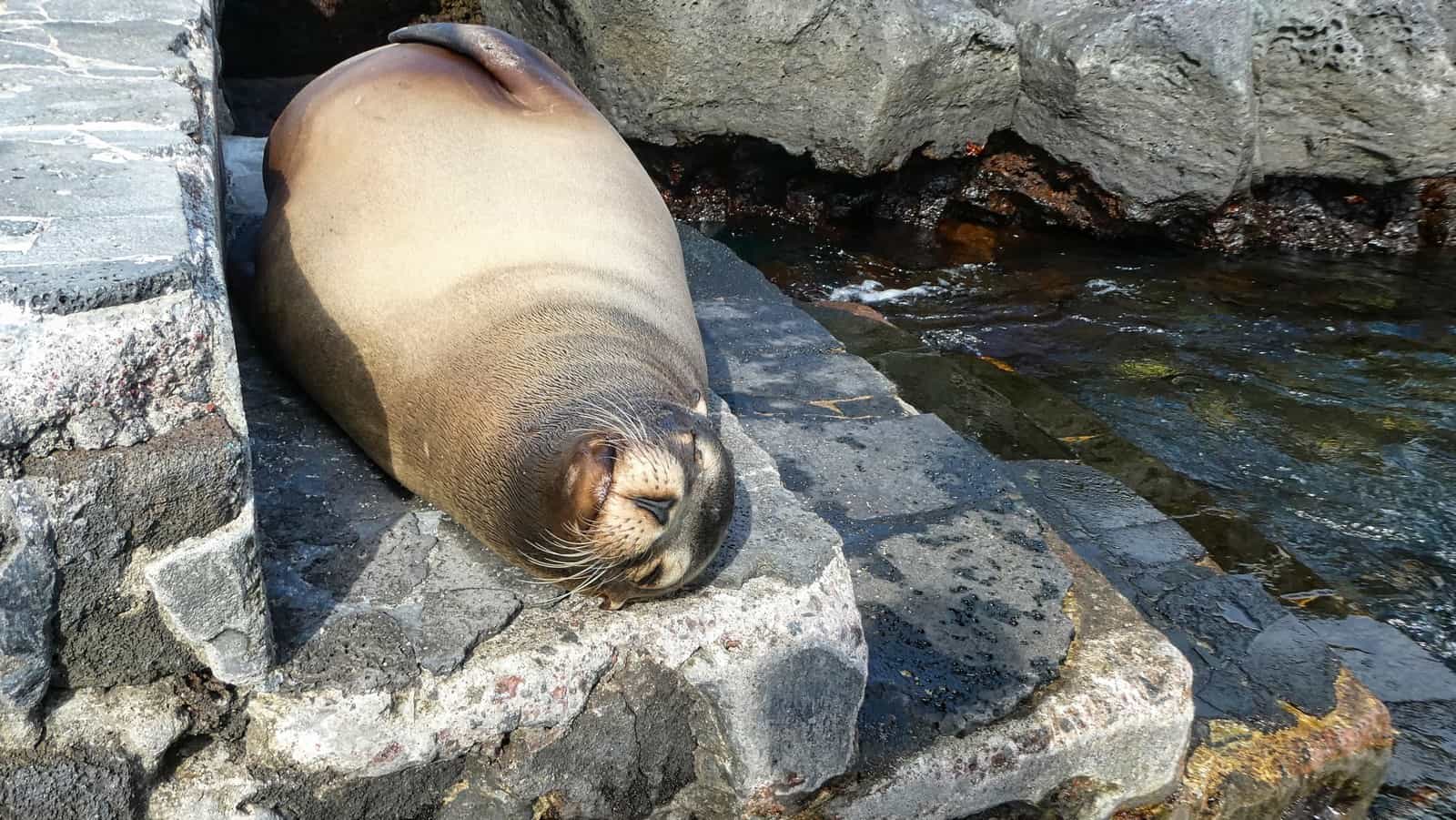
Chinese Hat Santiago Island
On day 4, we visited the highly anticipated Chinese Hat. Specifically, the Chinese Hat or “Sombrero Chino” in Spanish, is named for its shape. The only way to visit this island is from a Galapagos Islands cruise ship. There are no day trips from land-based tours. The Chinese Hat Island is the southernmost part of Santiago Island.
Chinese Hat consists of lava tubes and pillow-type lava formations, indicating that the flows were formed under the sea and rose upwards. Additionally, there is a trail that begins at a small white-sandy beach, passing through the lava fields where you can view the lava formations up close.
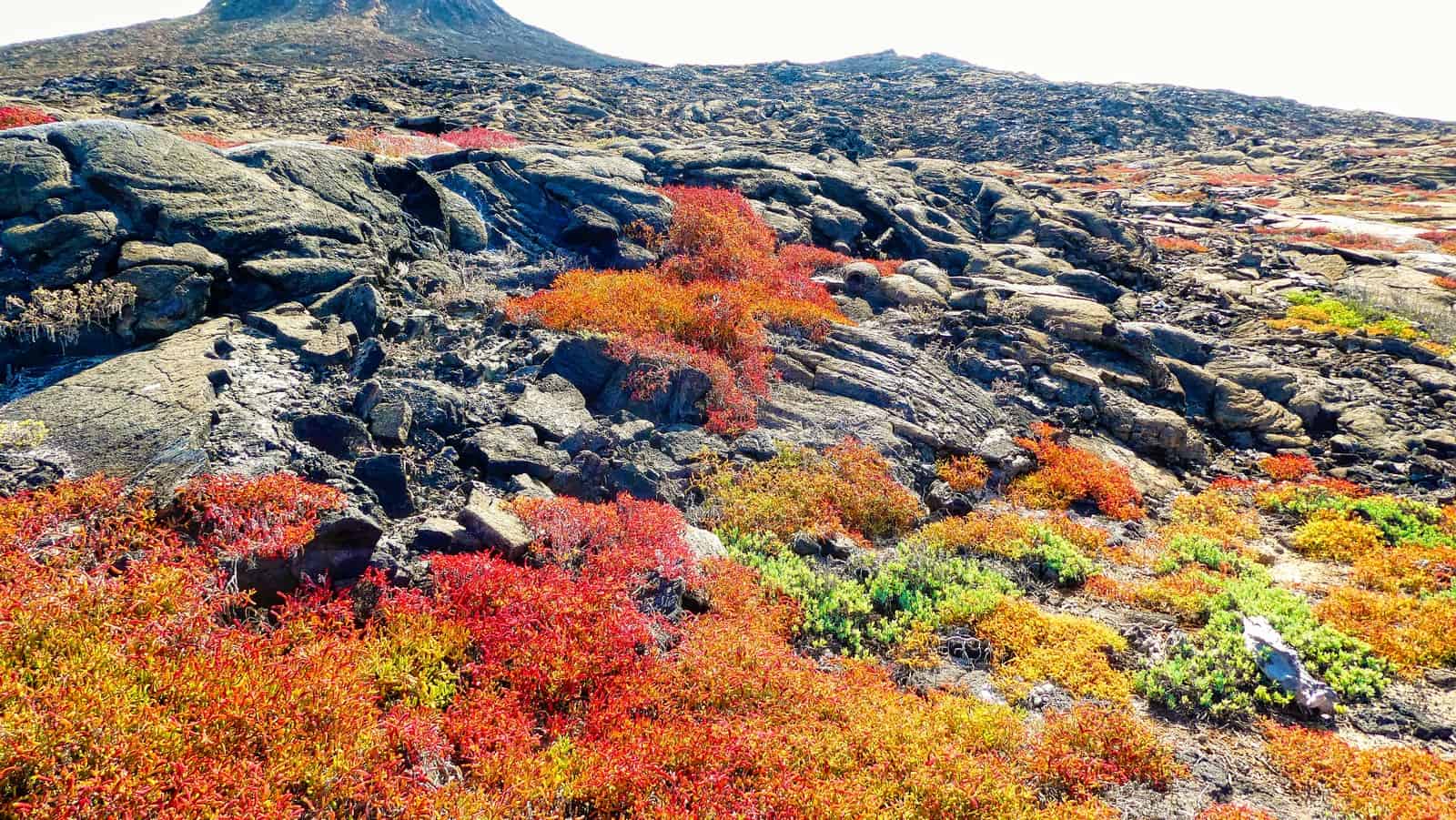
When we made our dry landing on Chinese Hat, there was no doubt in our minds that we were on land formed by the remnants of a long-ago volcano.
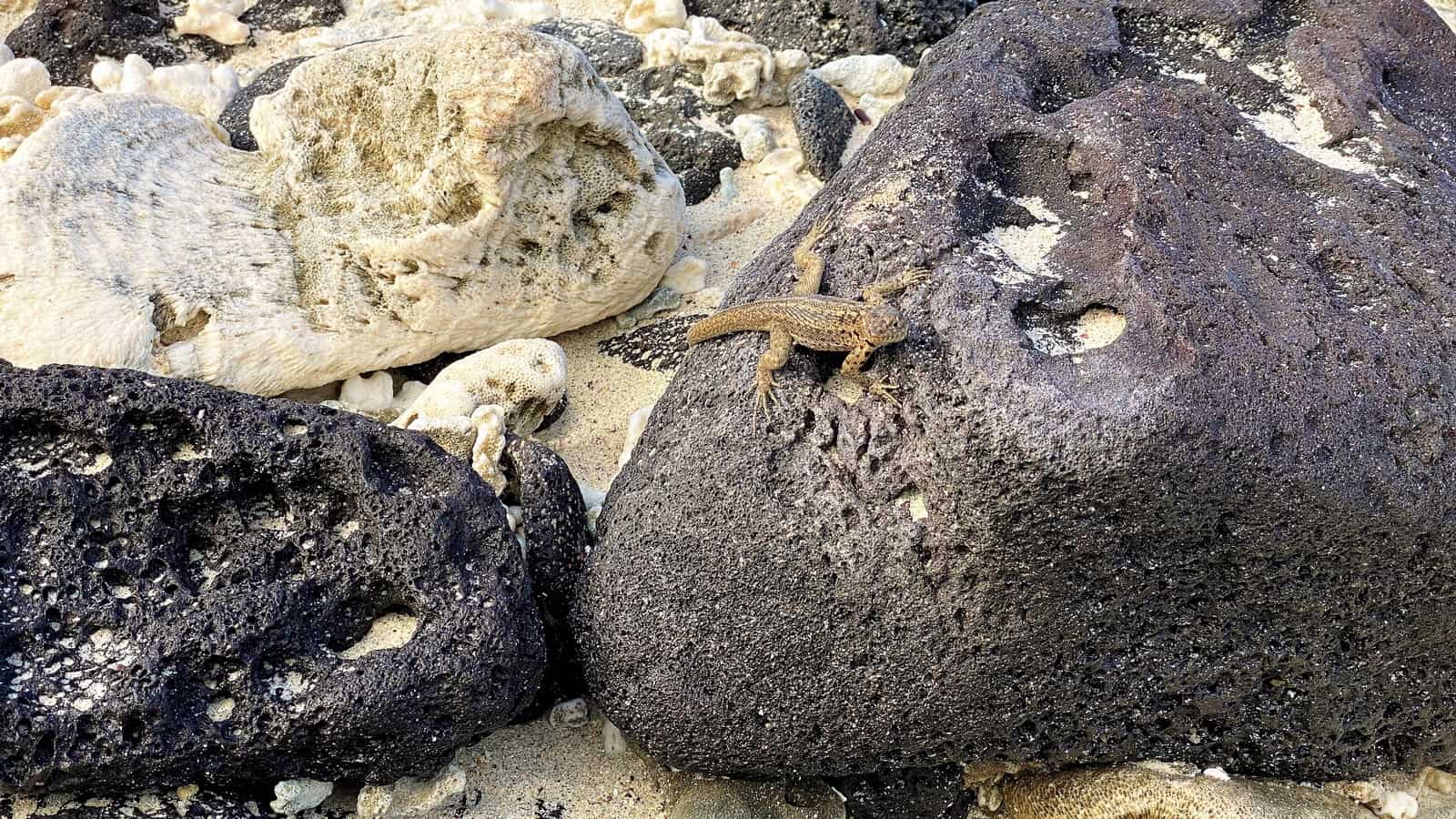
There is a lot of wildlife to see from a panga ride around Chinese Hat. We saw penguins on and around the island. Similarly, scurrying around the rocky shoreline, we saw many colorful Sally Lightfoot crabs. With their bright red shells with splotches of yellow and sometimes blue, they dot the black volcanic rocks and scamper sideways across the shoreline.
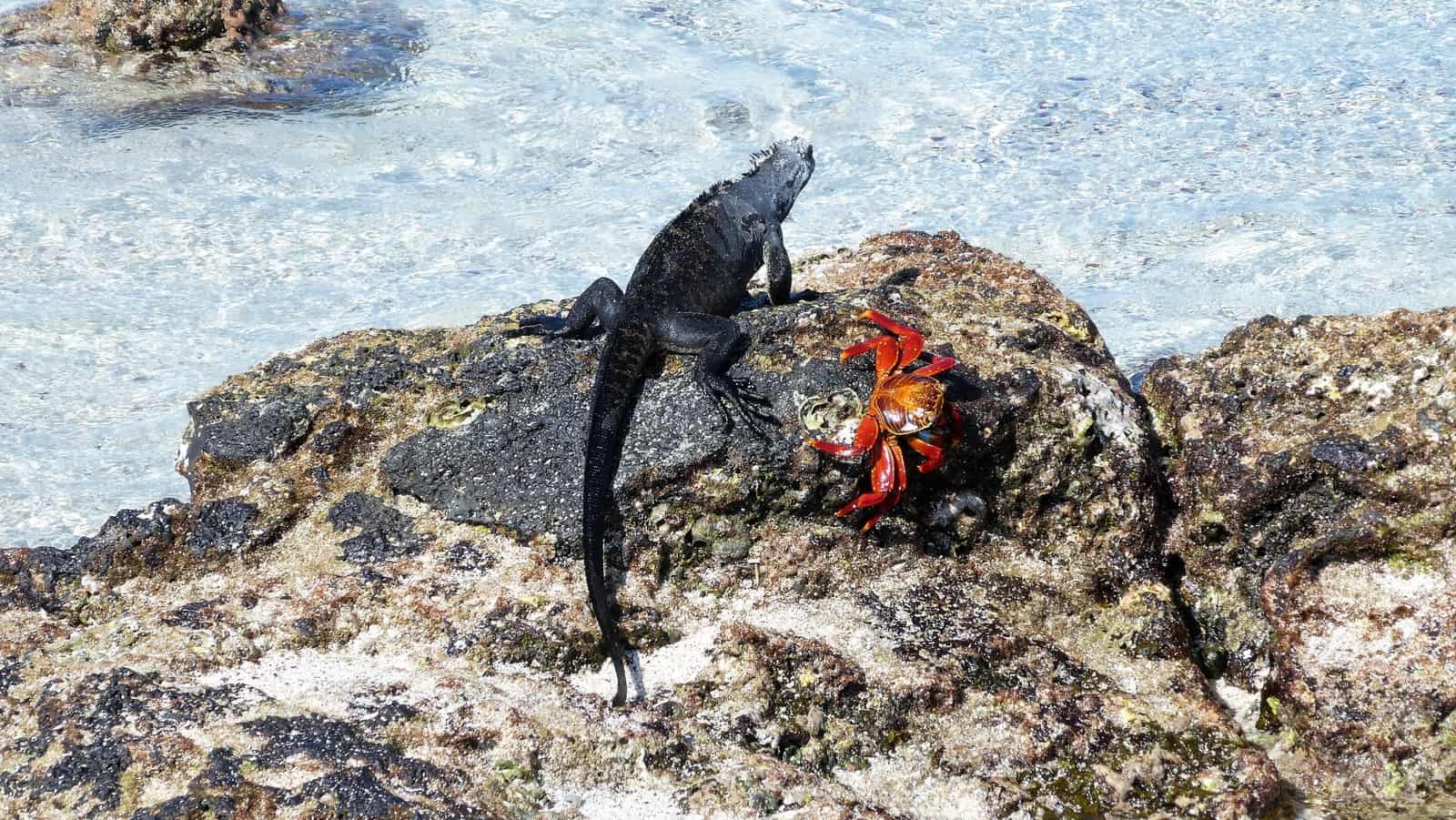
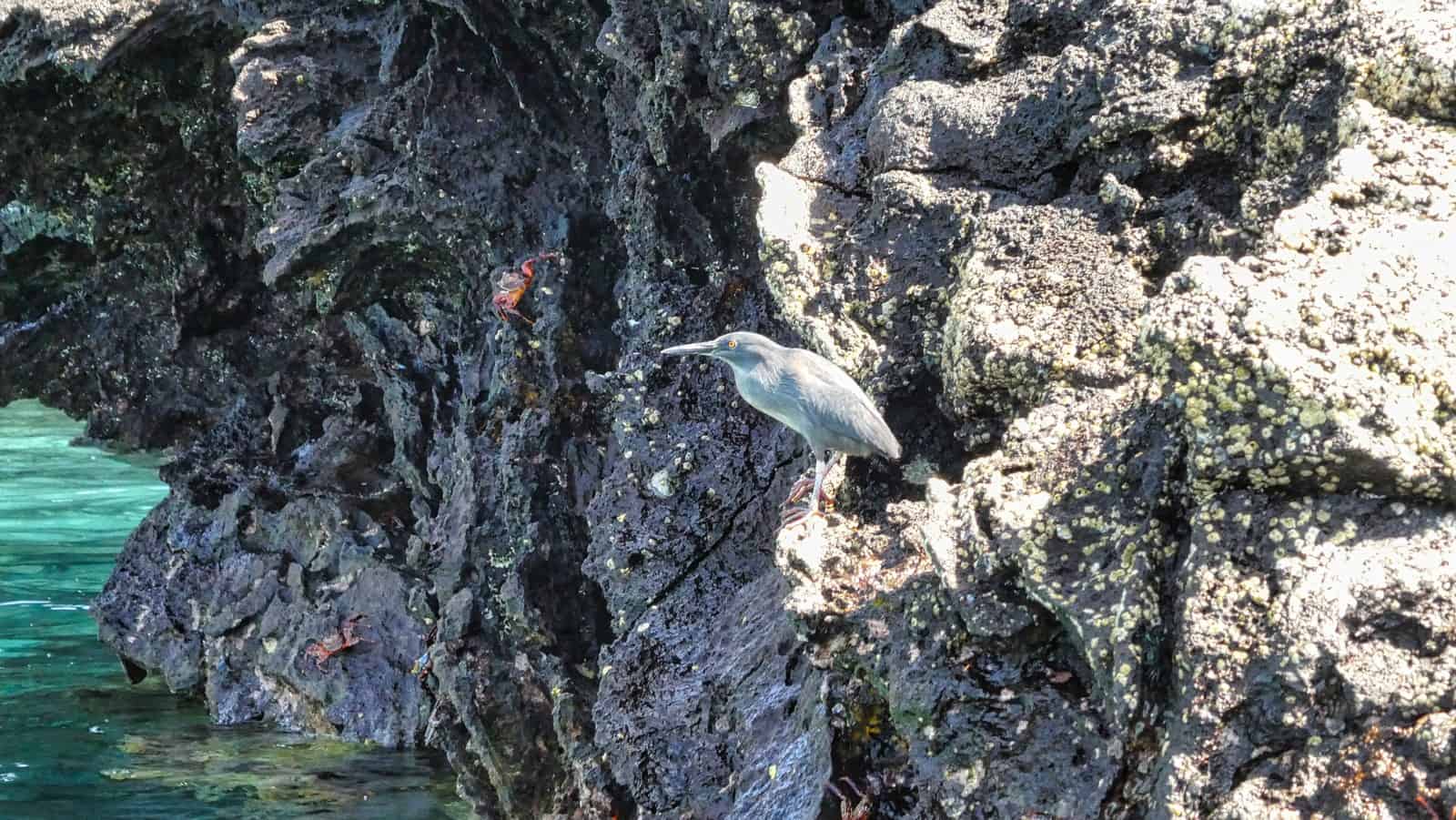
Penguins, Where It’s Warm?
When you think of penguins, you think Antarctica, not Ecuador. However, there are a unique species of penguin that calls tropical Galapagos home. Surprisingly, they love the cold waters of the Humbolt current that keeps the ocean at a comfortable temperature here. Galapagos penguins mate for life, and both mom and dad tend to the eggs and raise the chicks. Interestingly, we saw penguins swimming looking for food. While there were lots of fish below, the penguins were very picky, looking for their favorite fish, the sardine.
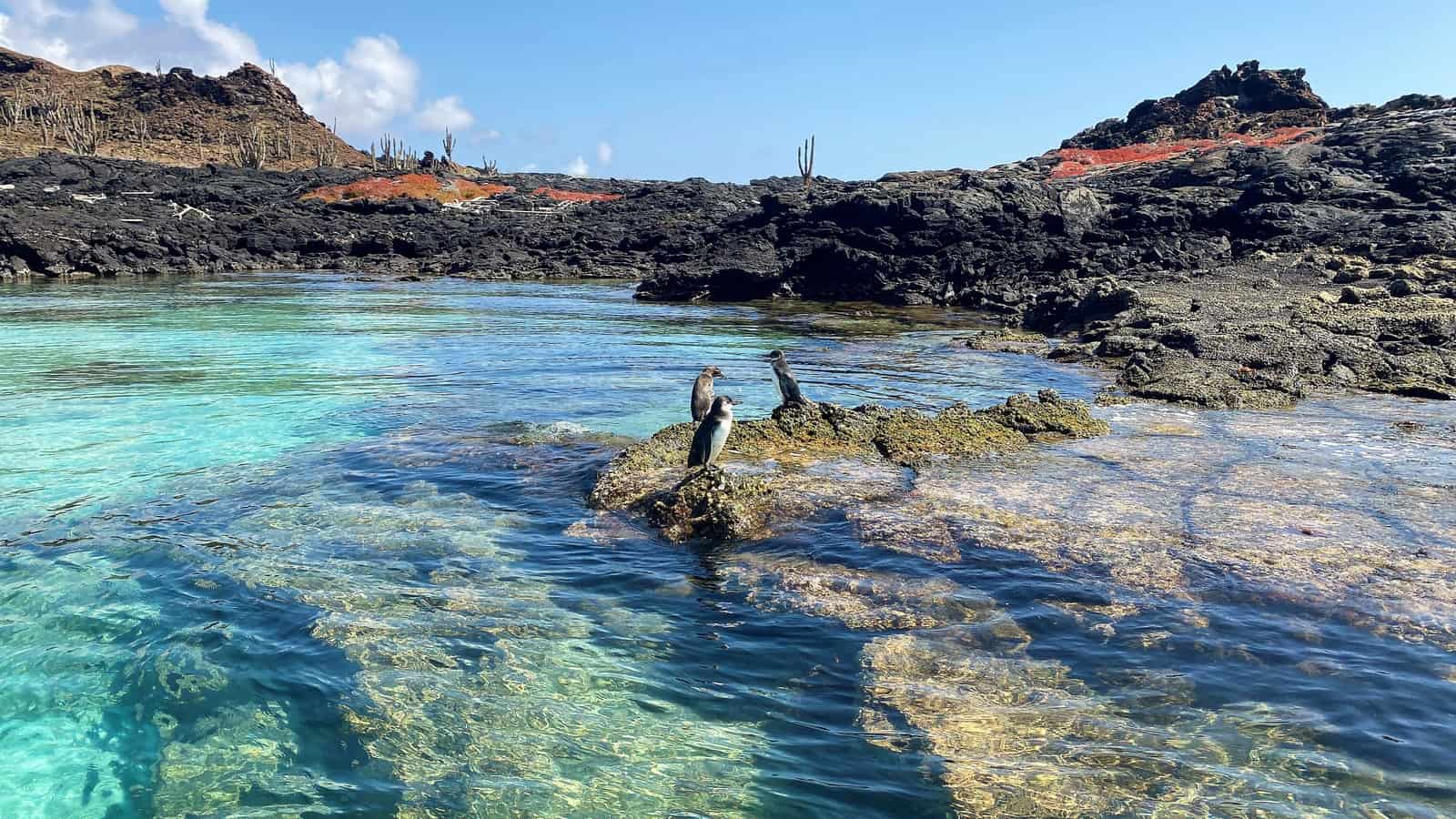
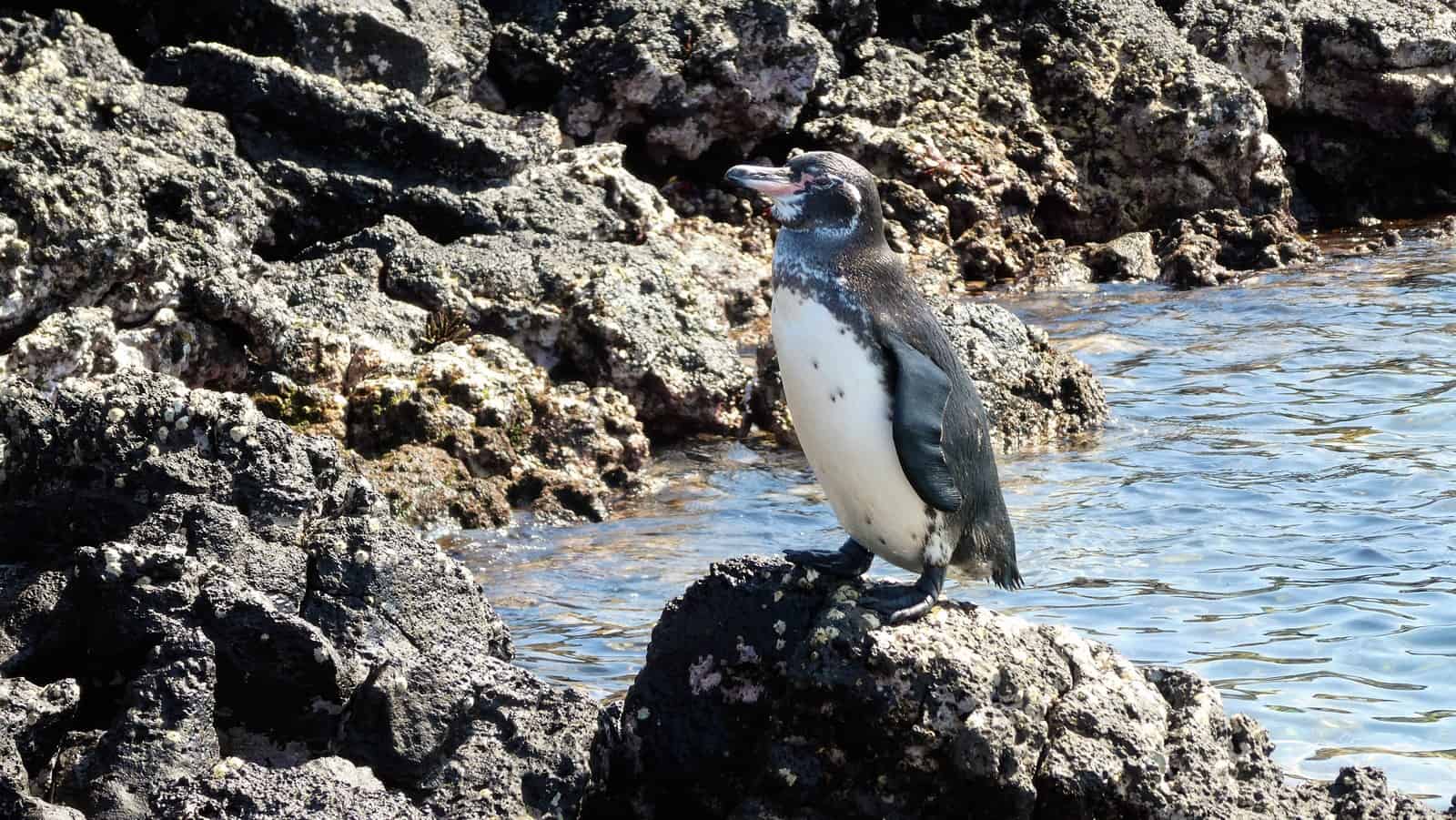
Undoubtedly, the snorkeling around the island was amazing. Along with all the beautiful fish, we were lucky enough to see penguins and sea lions swim by close to us.
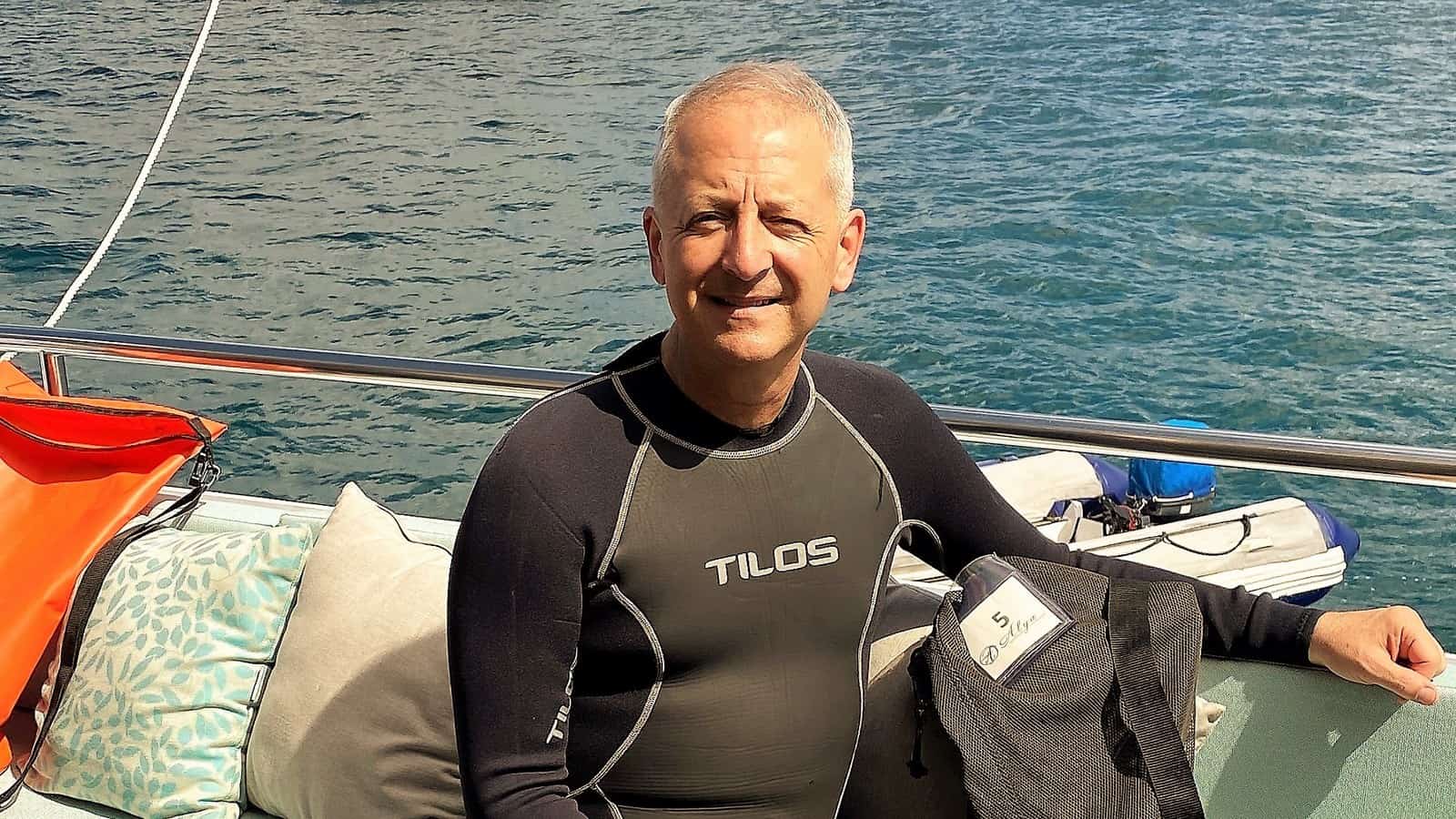
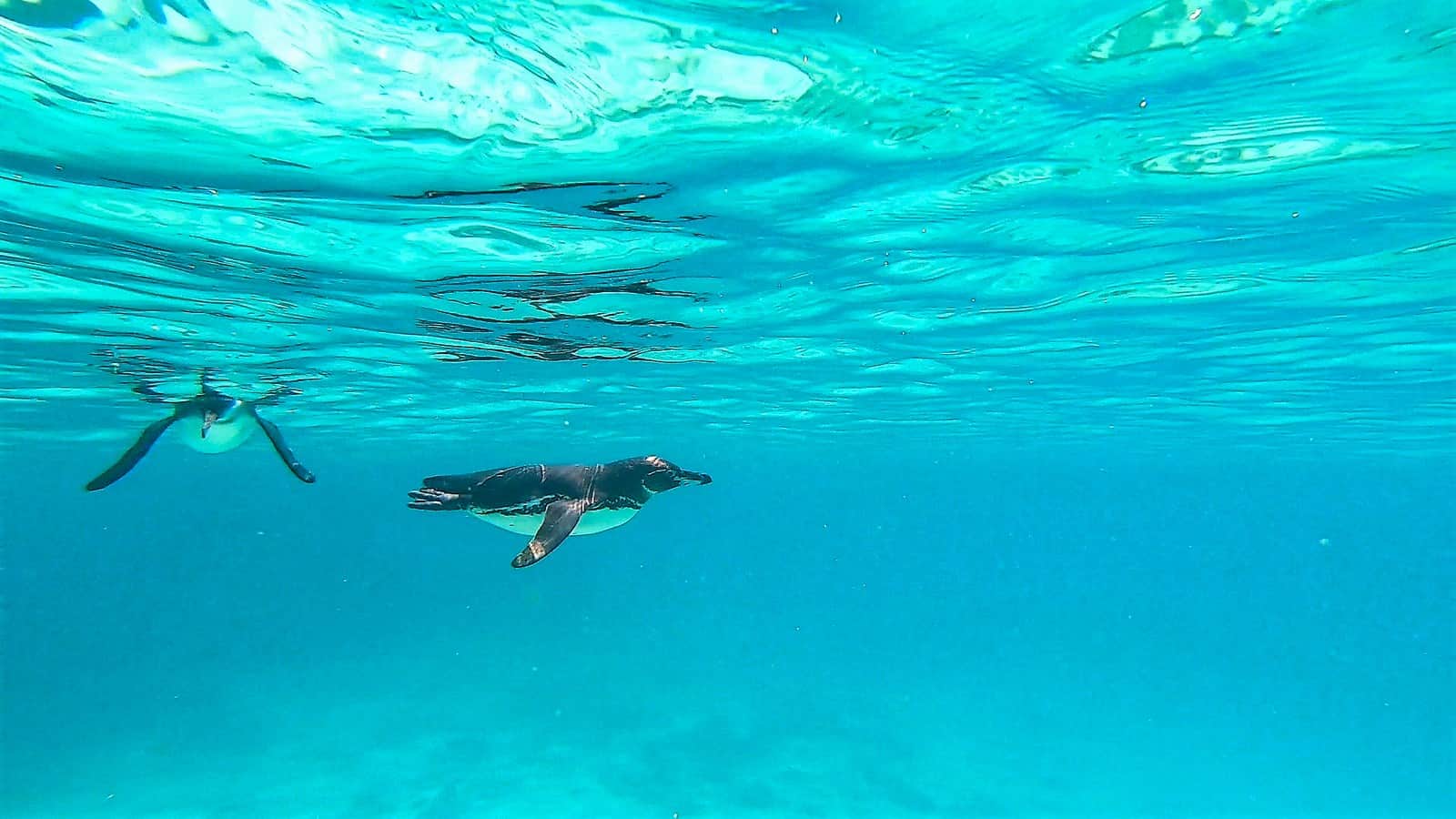
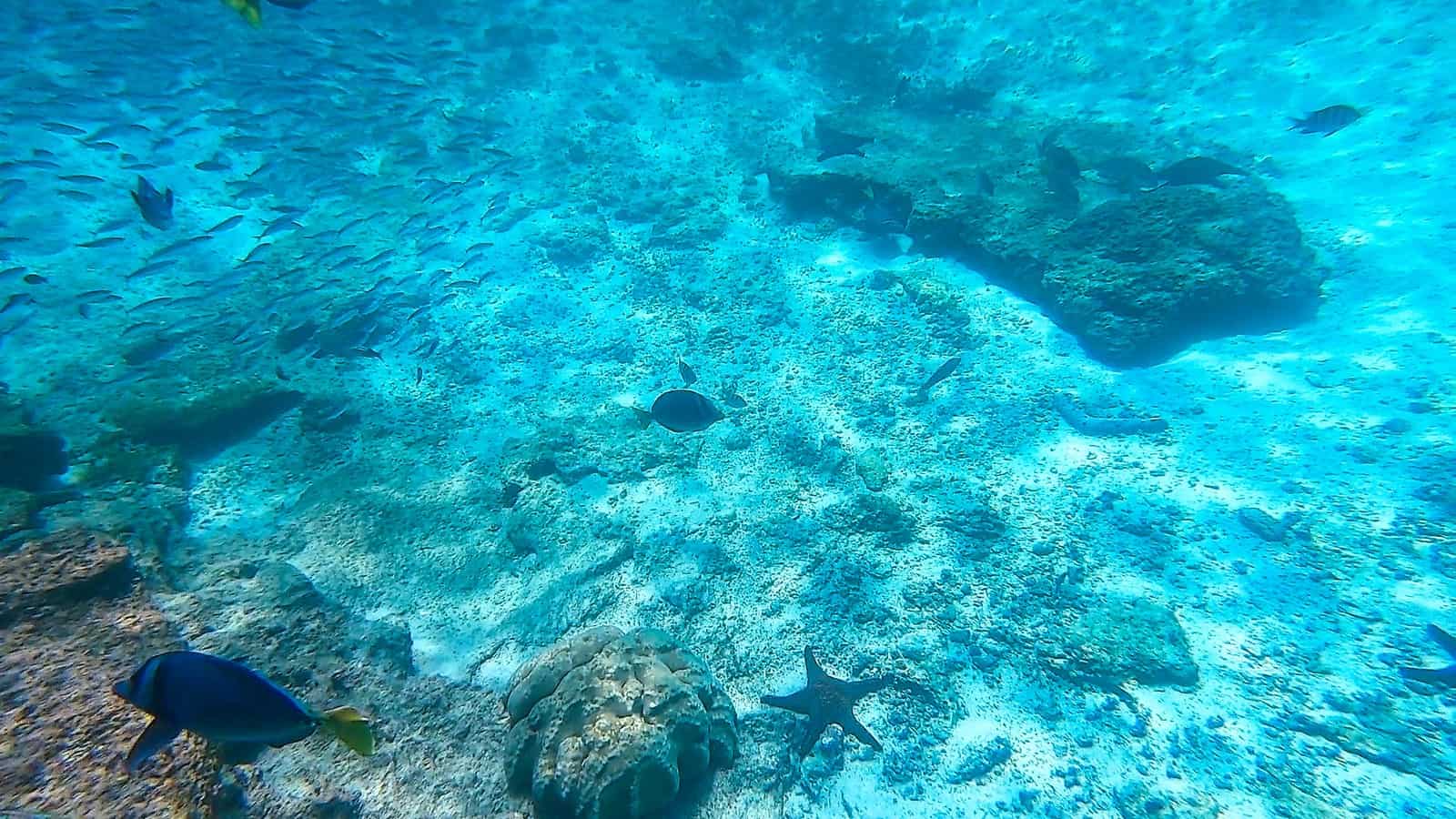
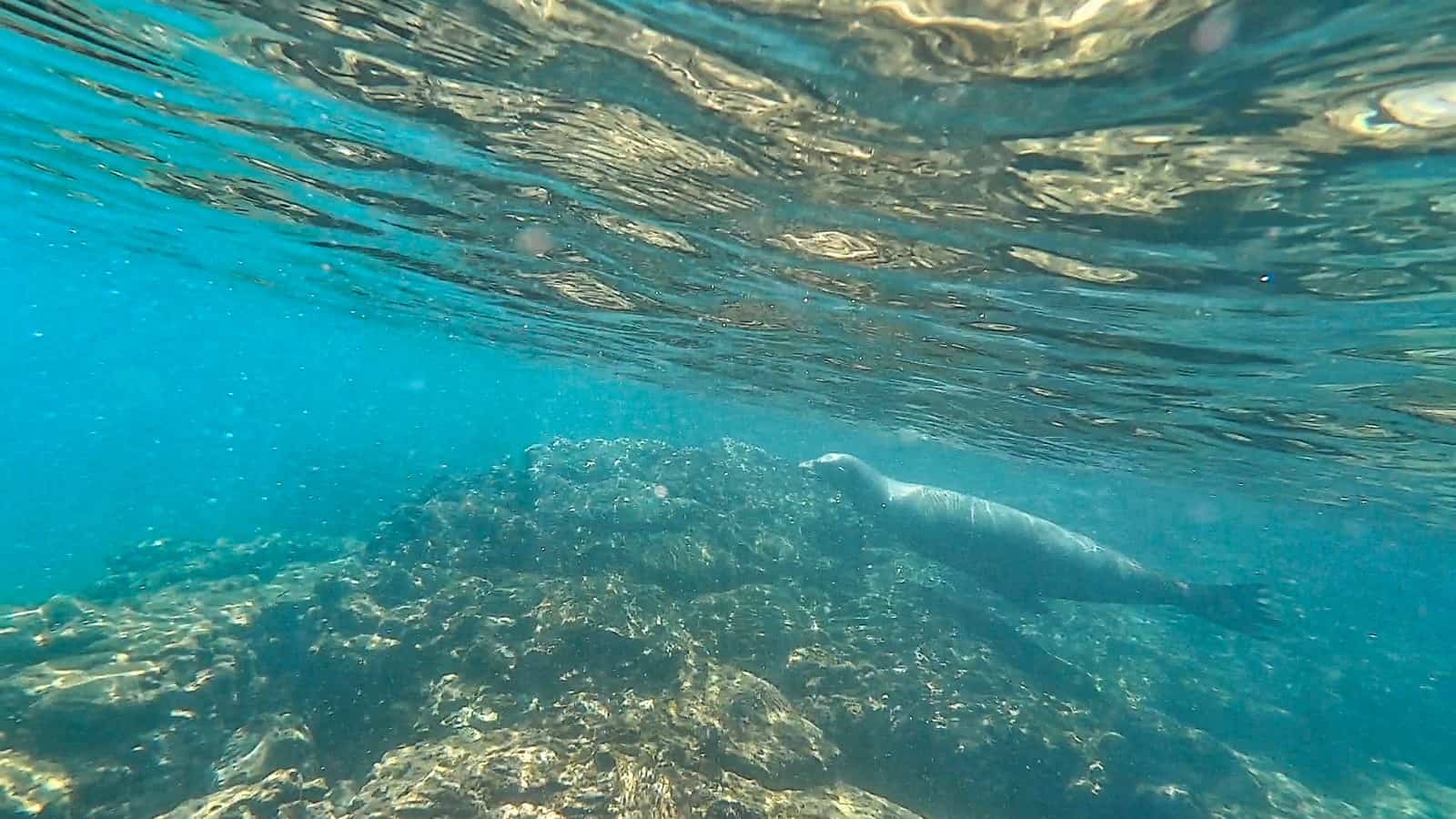
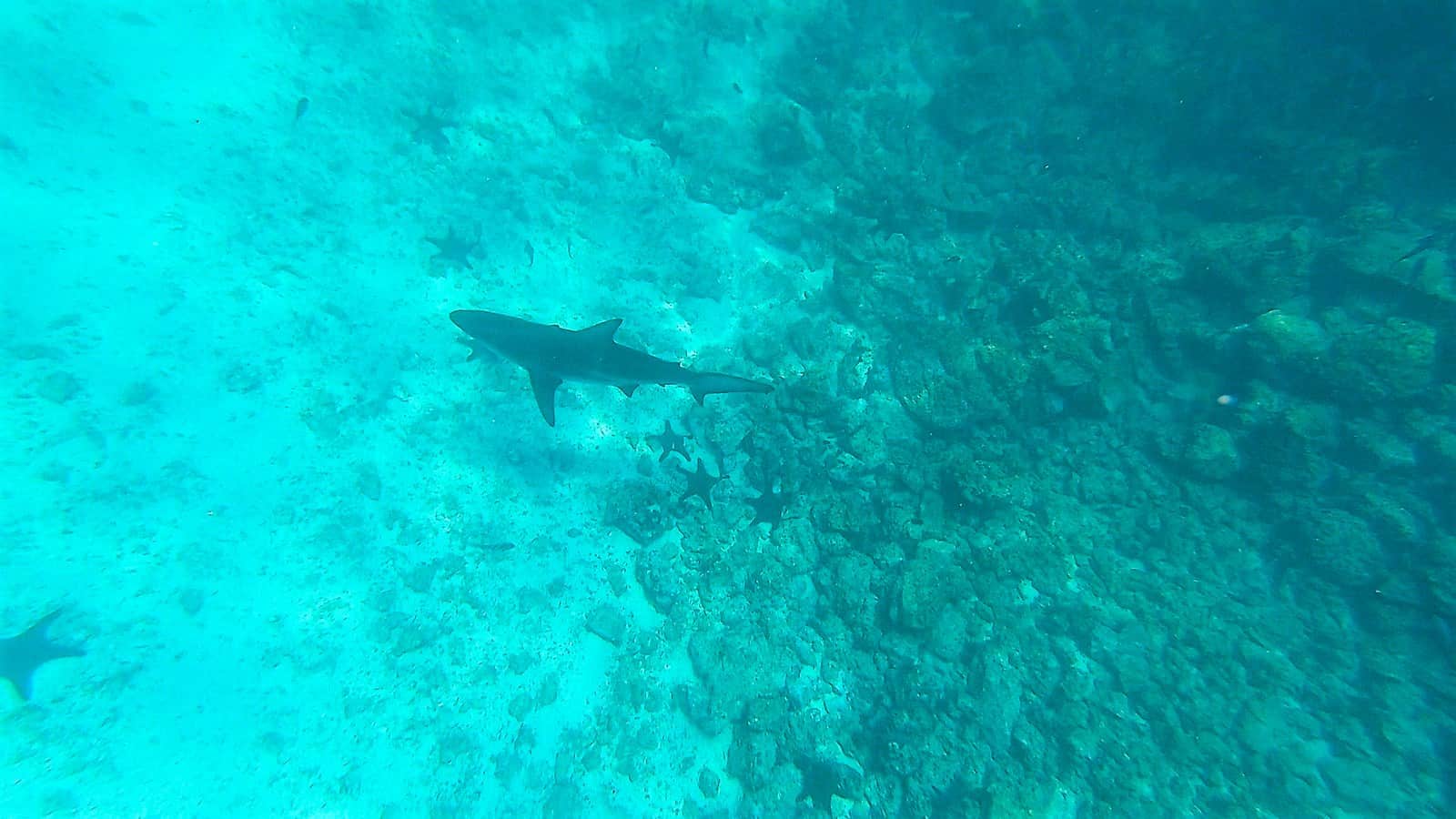
Mosquera, One of the Largest Populations of Sea Lions
After a wonderful lunch on the M/C Alya, we took the pangas and made a wet landing on the island of Mosquera. Mosquera is an islet located between the islands of Baltra and North Seymour. However, it is a reef of rocks and coral covered with a great white sand beach. Its narrowest width reaches about 525 feet and is about 1960 feet long.
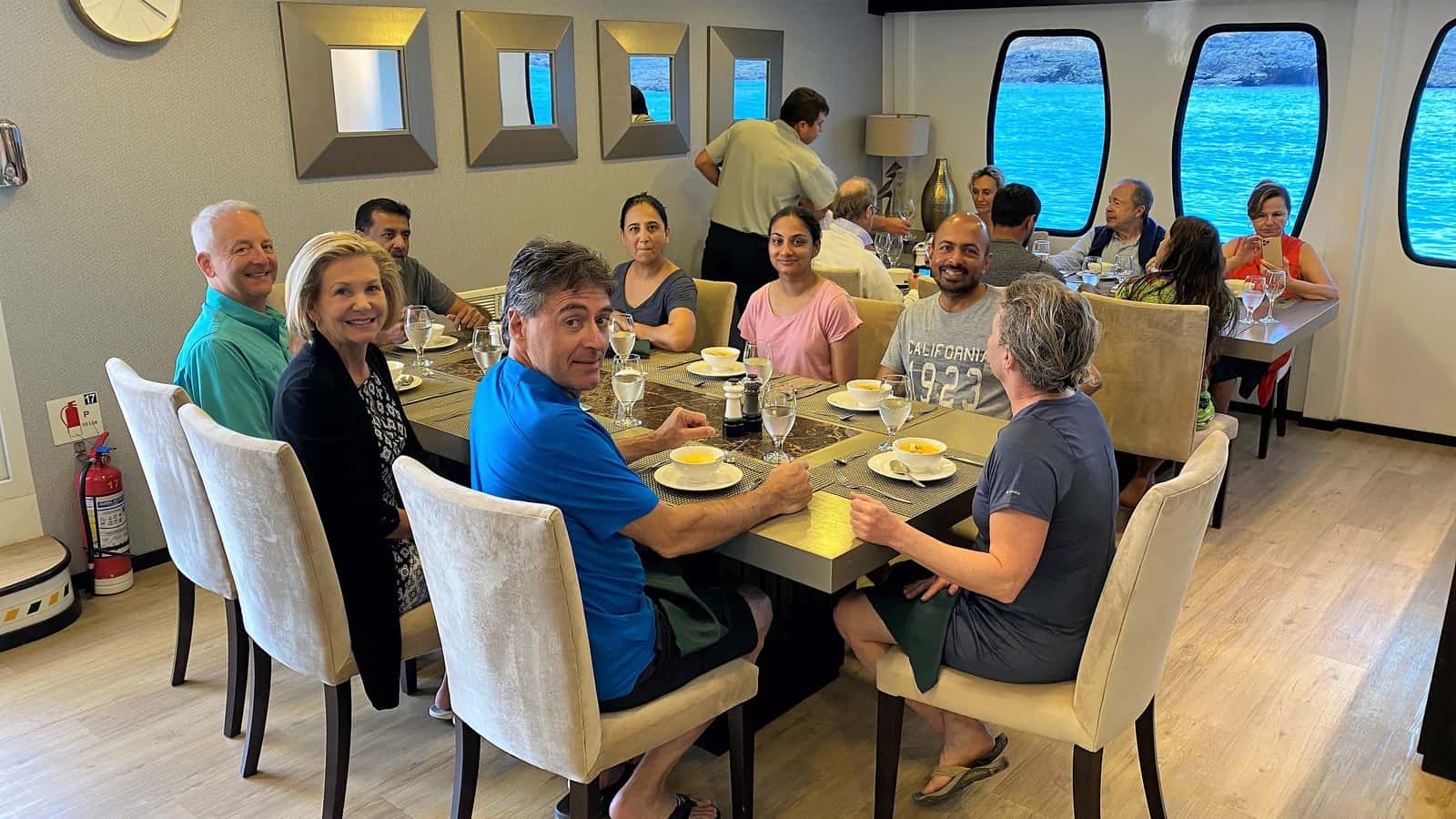
Lava rocks frame the tiny island, except on the southwest side where we landed. But, there was a beautiful beach. On the rocks were Iguanas and crabs.
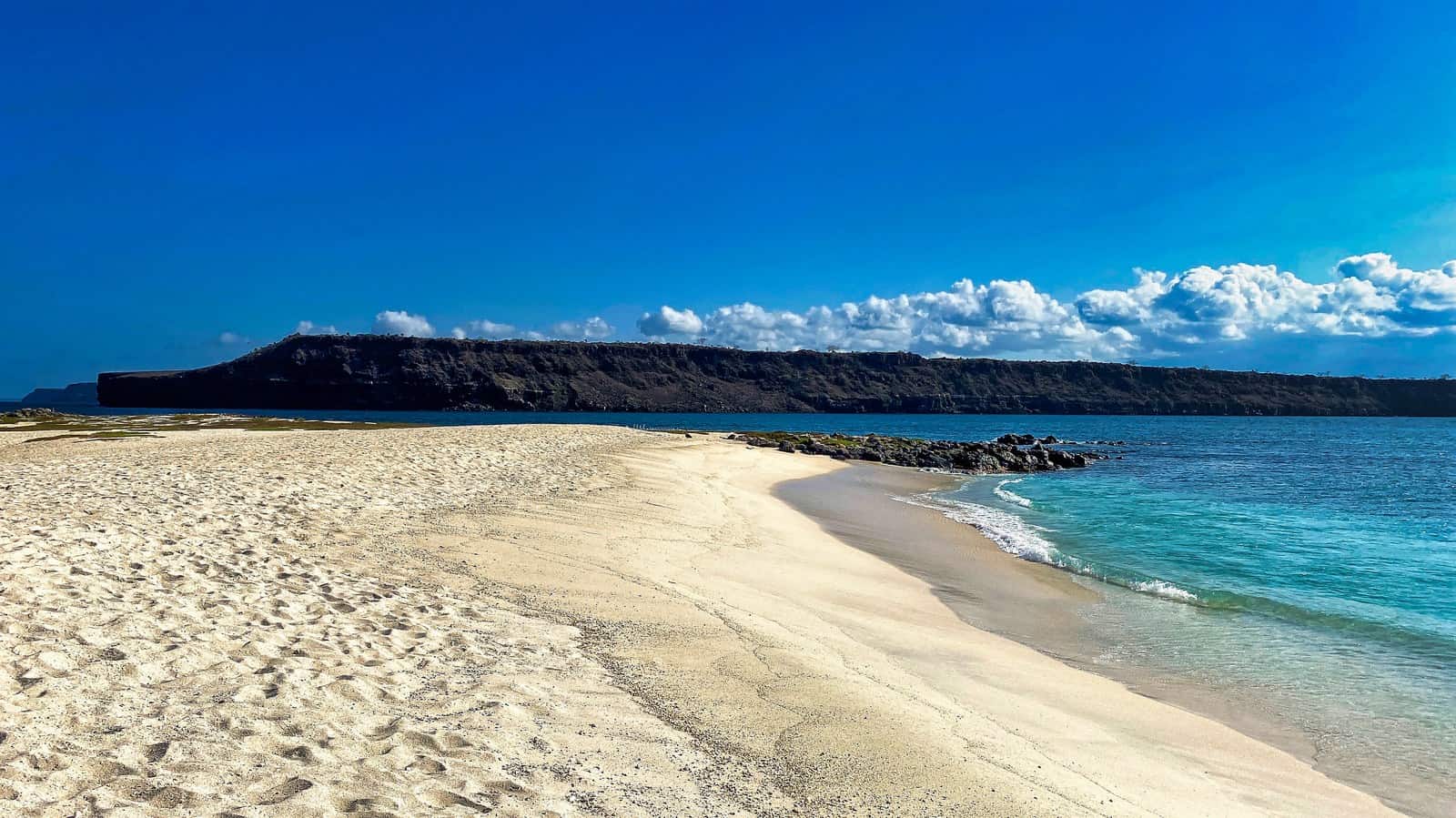
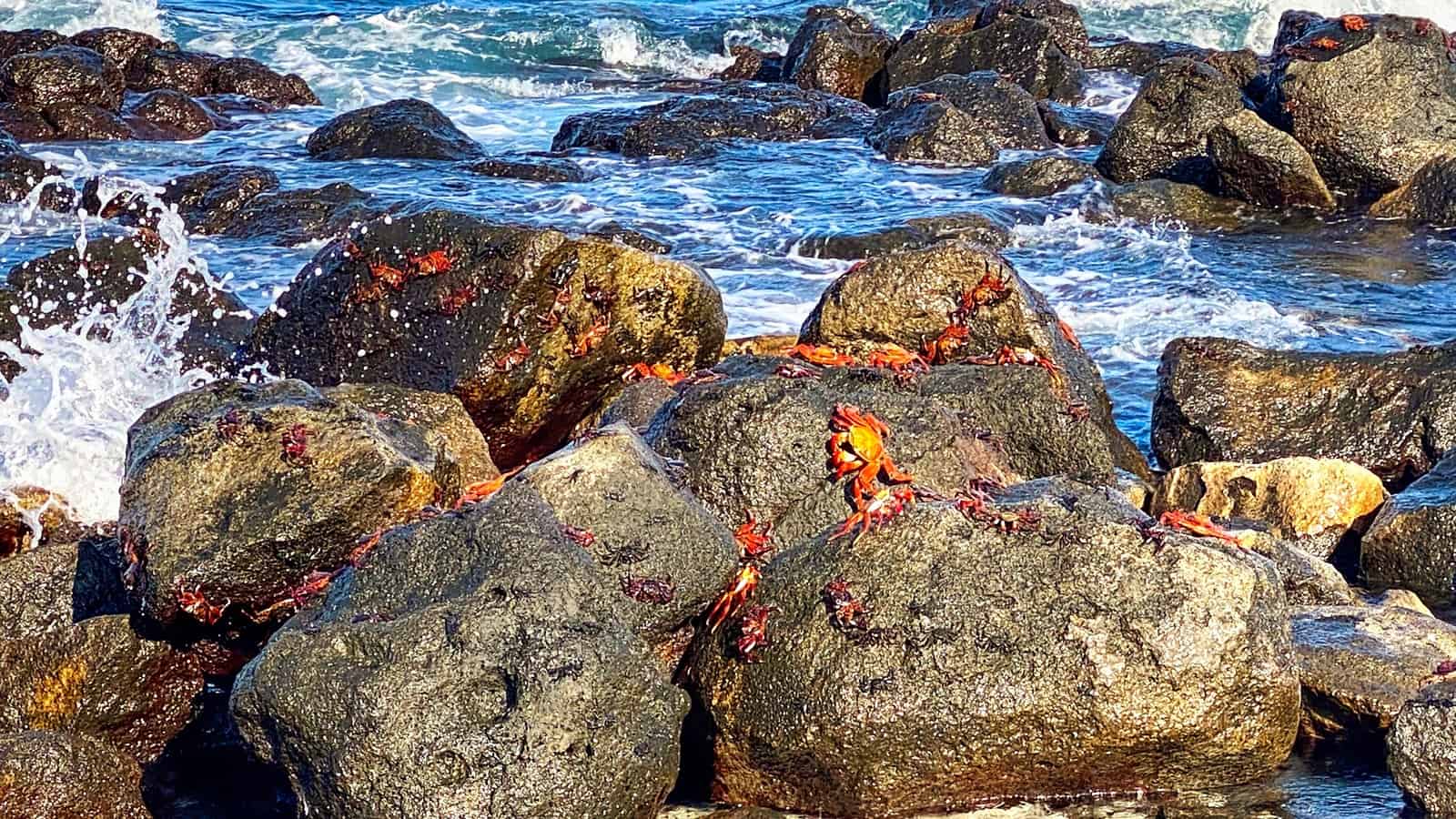
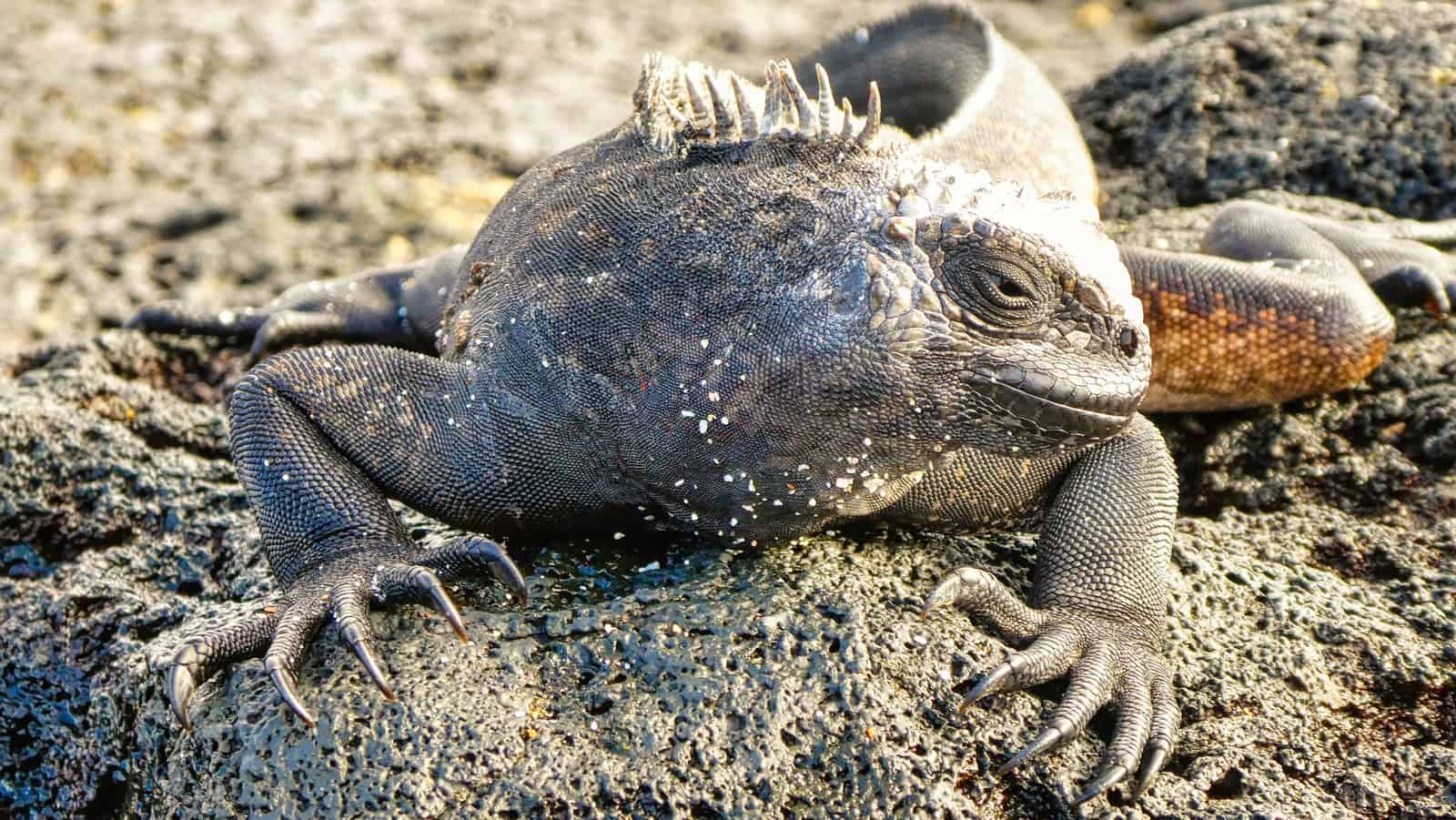
We loved this island. It had the largest populations of sea lions that we saw on this trip. Unquestionably, Galapagos sea lions are the smallest sea lions in the world. Sea lions are curious and playful. There were many juvenile sea lions on this beach. Many of these young sea lions tried feeding on other moms along the shore only to be shooed away with a snip to the nose. Sometimes their mom is gone for days to feed before she returns to feed her pup.
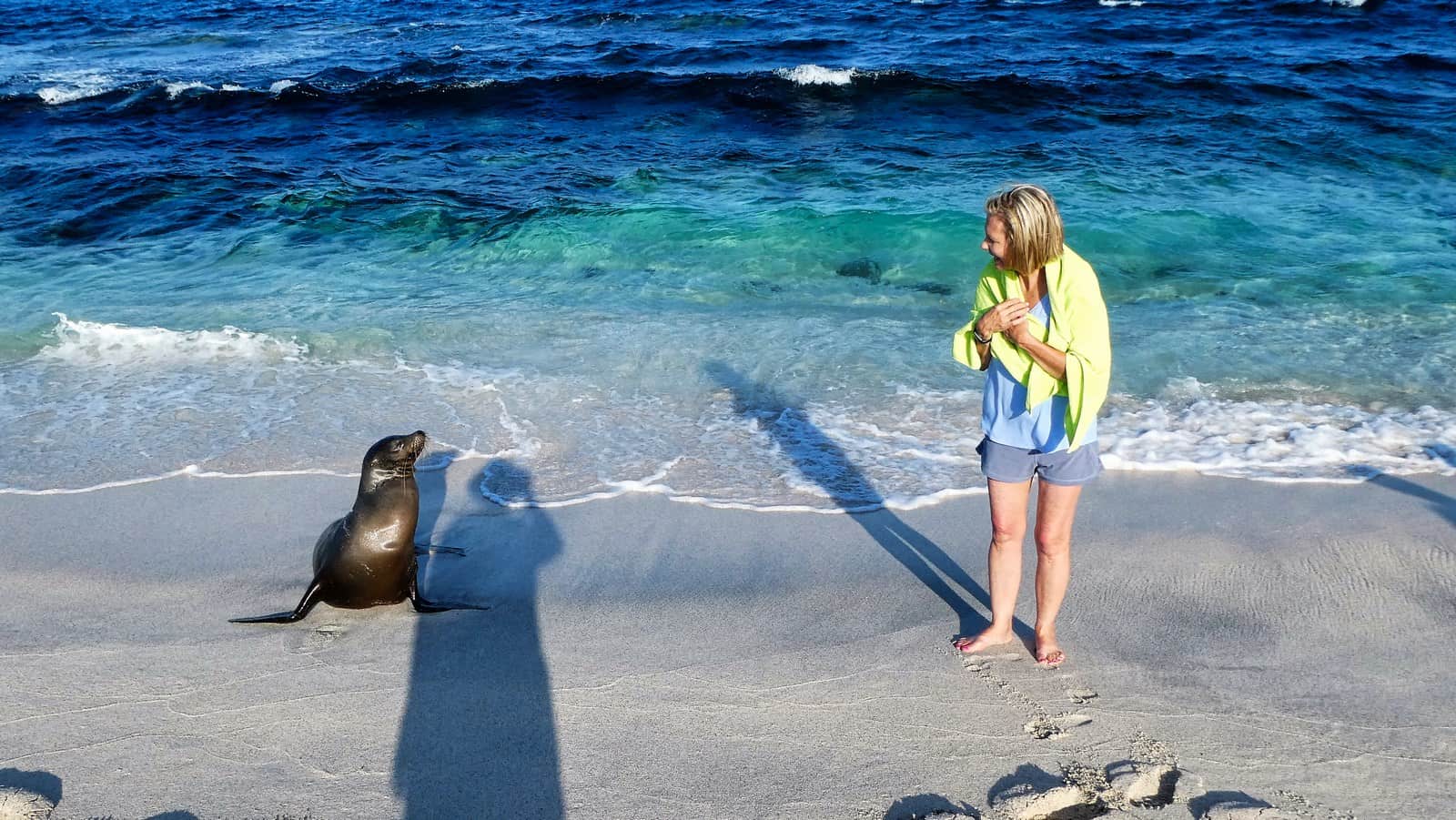
No matter what time of year you visit the Galapagos, you will see young sea lions. The Galapagos sea lions nurse for at least two years but sometimes up to five. Most sea lions reach maturity in four or five years.
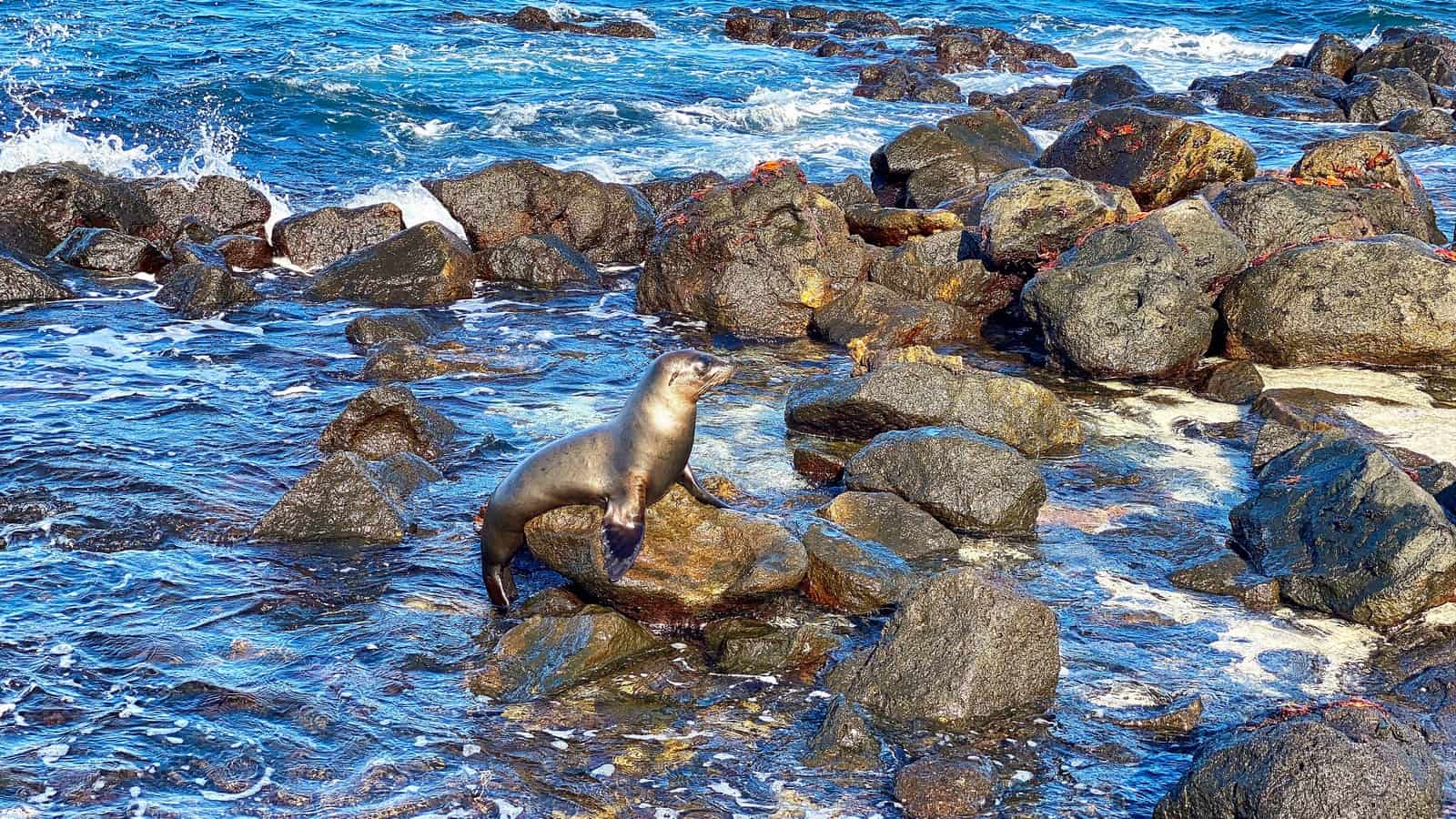
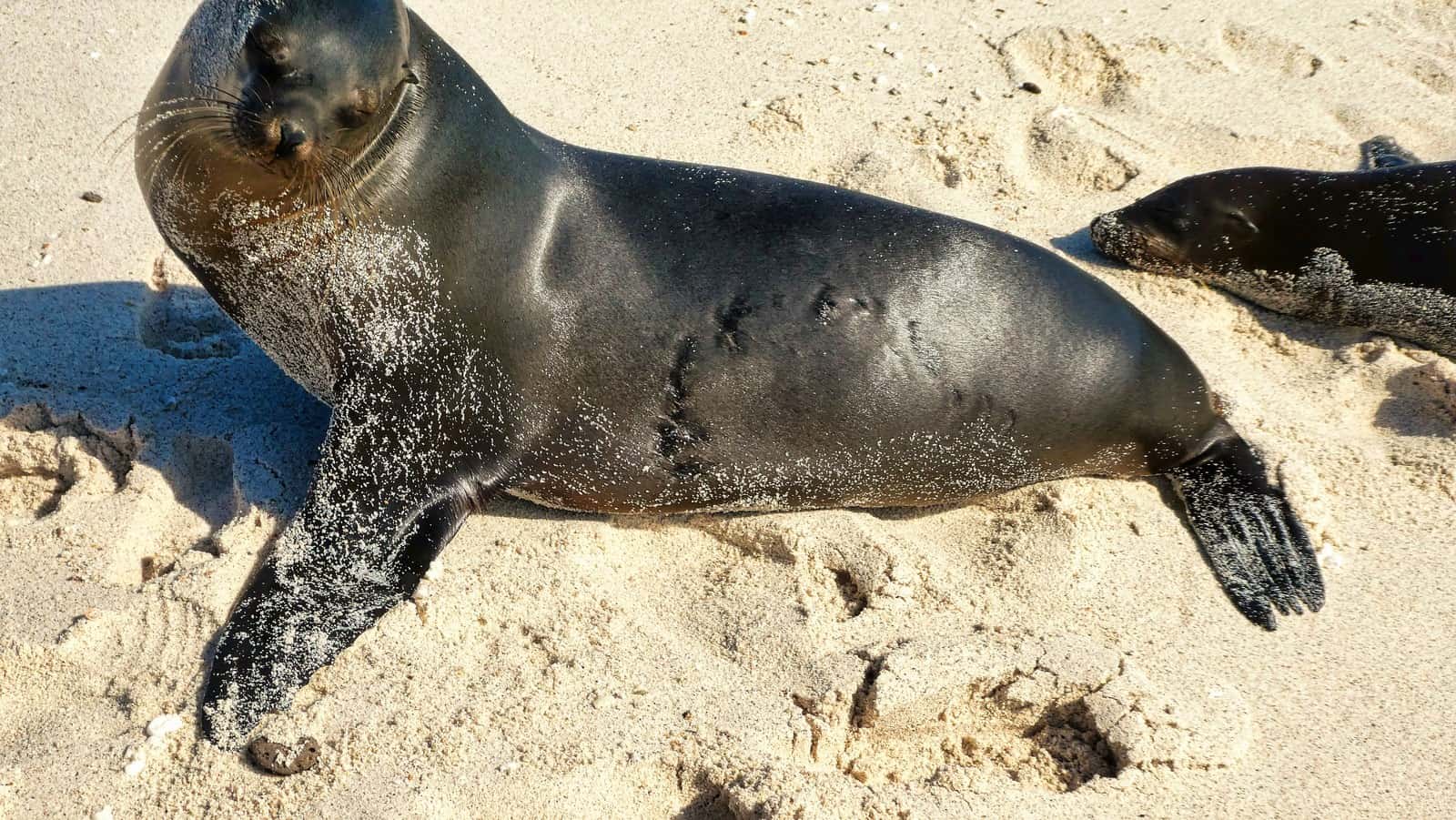
Curious Sea Lions
Sea lions, being curious like to get close to humans and grab at sunglasses, cameras, and other objects you may have. We saw this first-hand with another passenger on our cruise who was photographing the sea lions when one approached him. The man backed up quickly, wanting to keep the proper distance, but the pup moved quickly, trying to grab his camera. There may not be another place in the world where wildlife will get so close to you in the wild without fear.
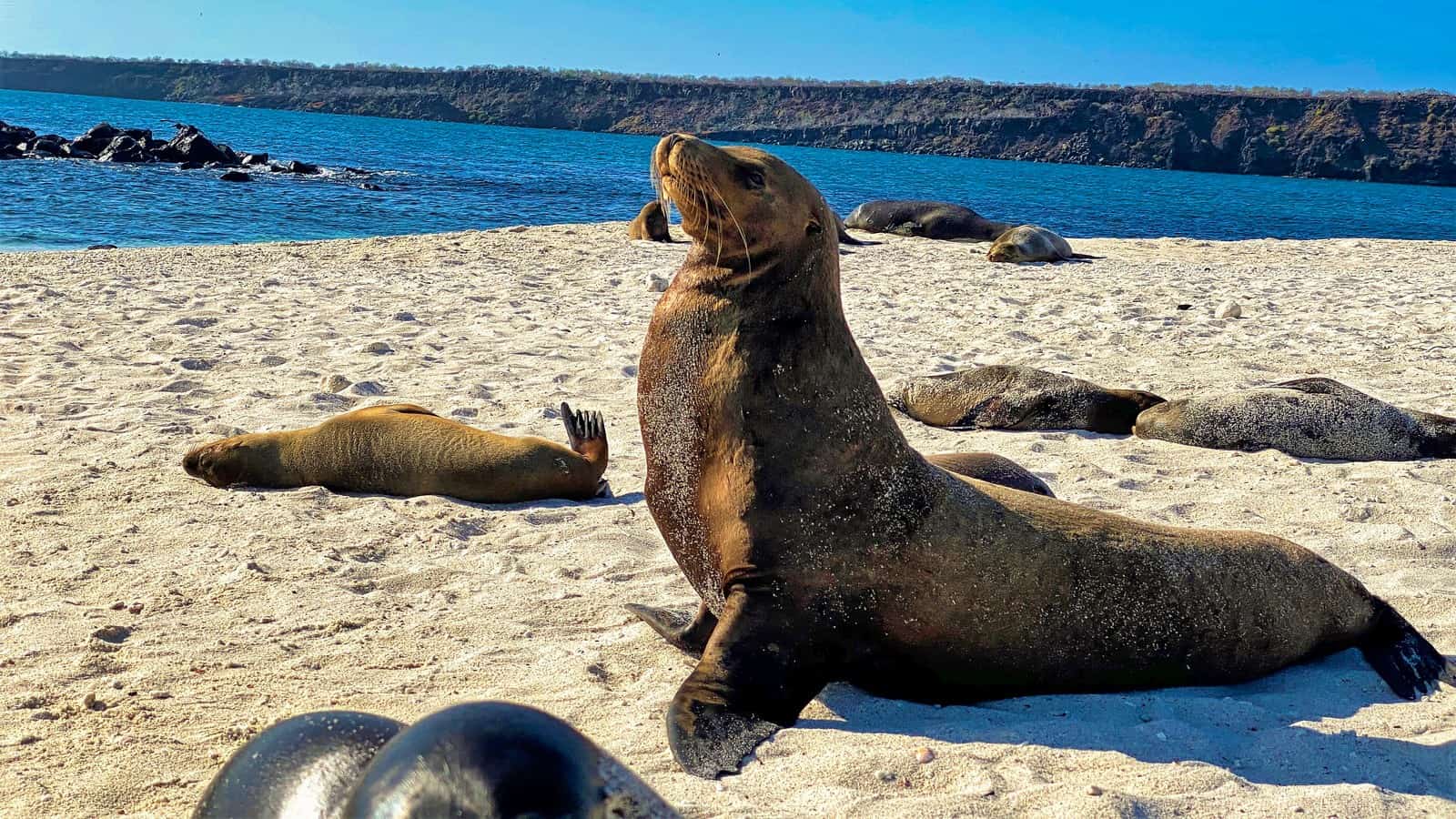
On our last night aboard the M/C Alya, we were served a special cocktail. We had dinner outside on the upper deck with a couple of bottles of wine compliments of the captain. It was a wonderful night to eat outside along with a full moon and the planet Venus shining bright on the horizon.
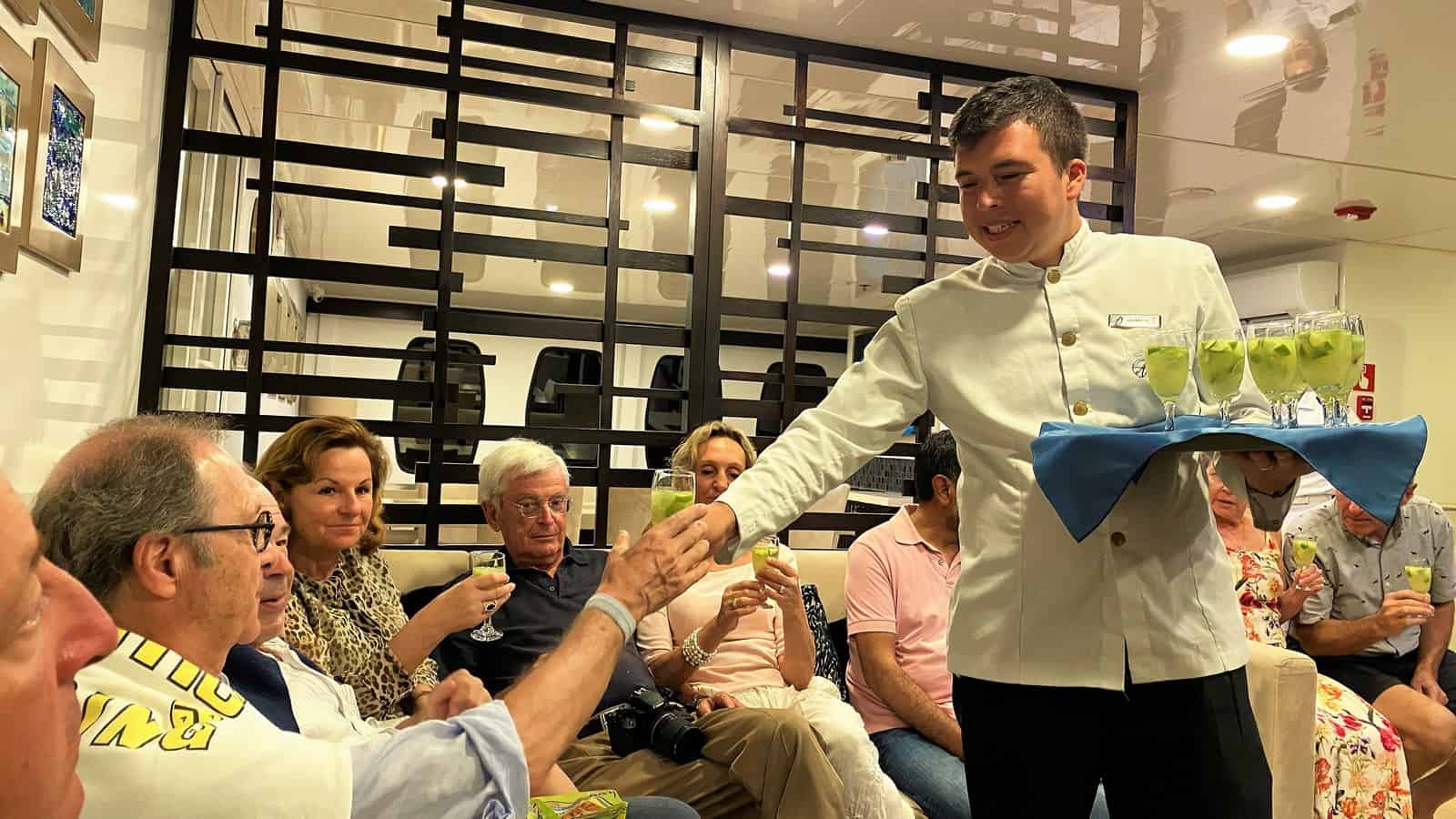
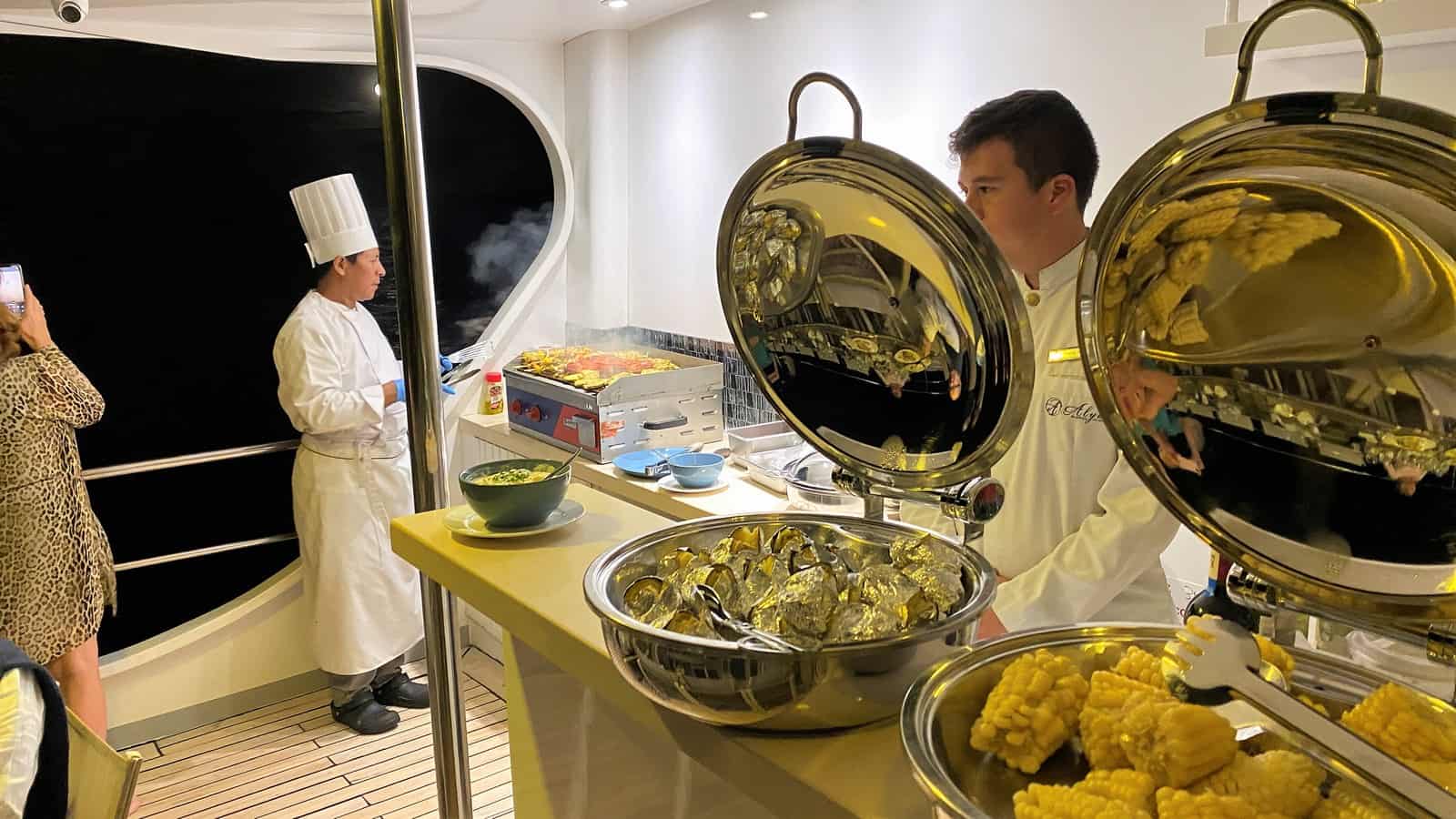
Santa Cruz Island to Visit the Charles Darwin Research Center
On our last day, we have an early breakfast and said goodbye to our crew because when we boarded the pangas, we knew we would not be returning to the ship.
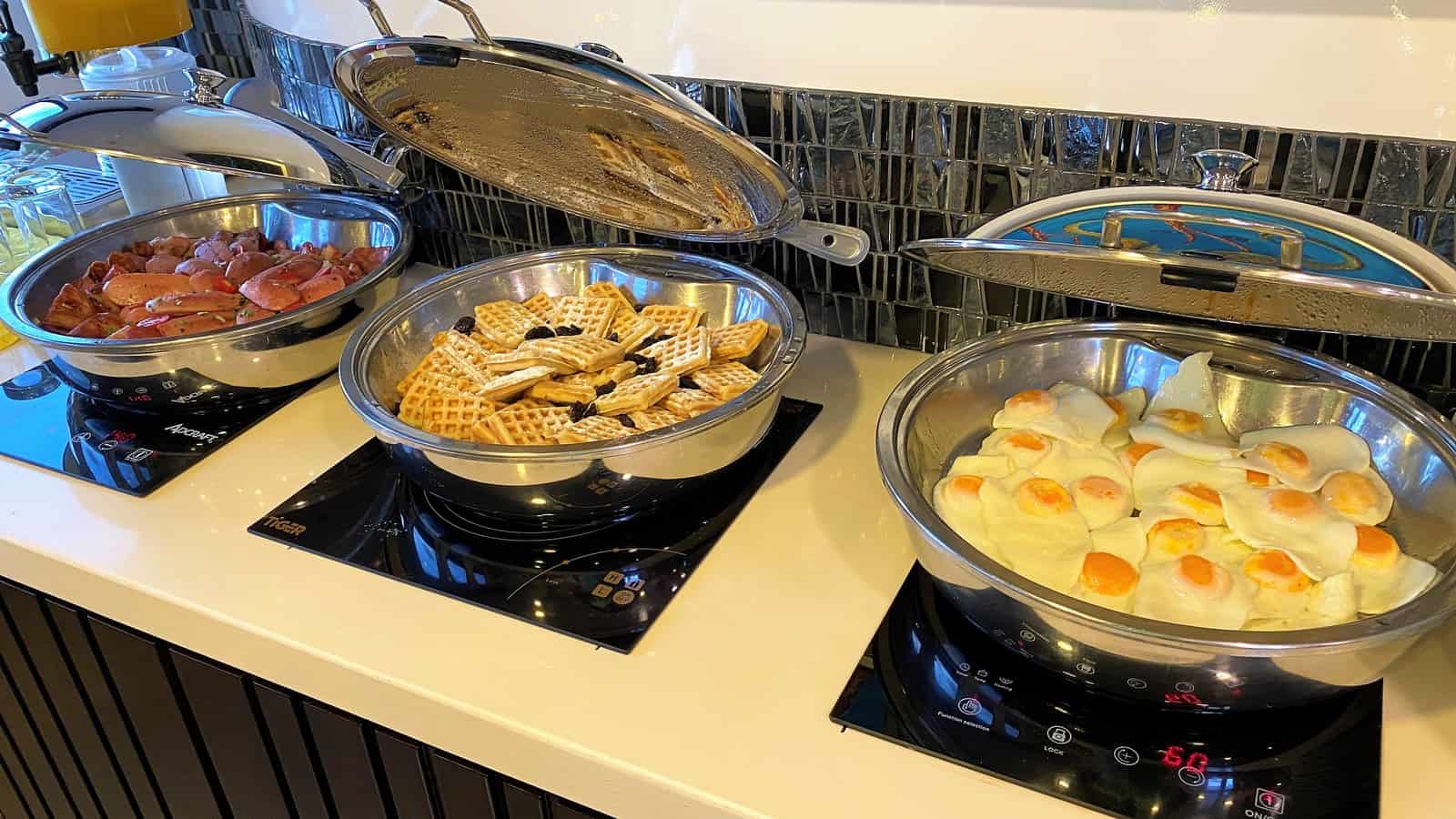
So, we disembarked the pangas onto Santa Cruz Island, where we boarded a bus that took us to the Charles Darwin Research Station.
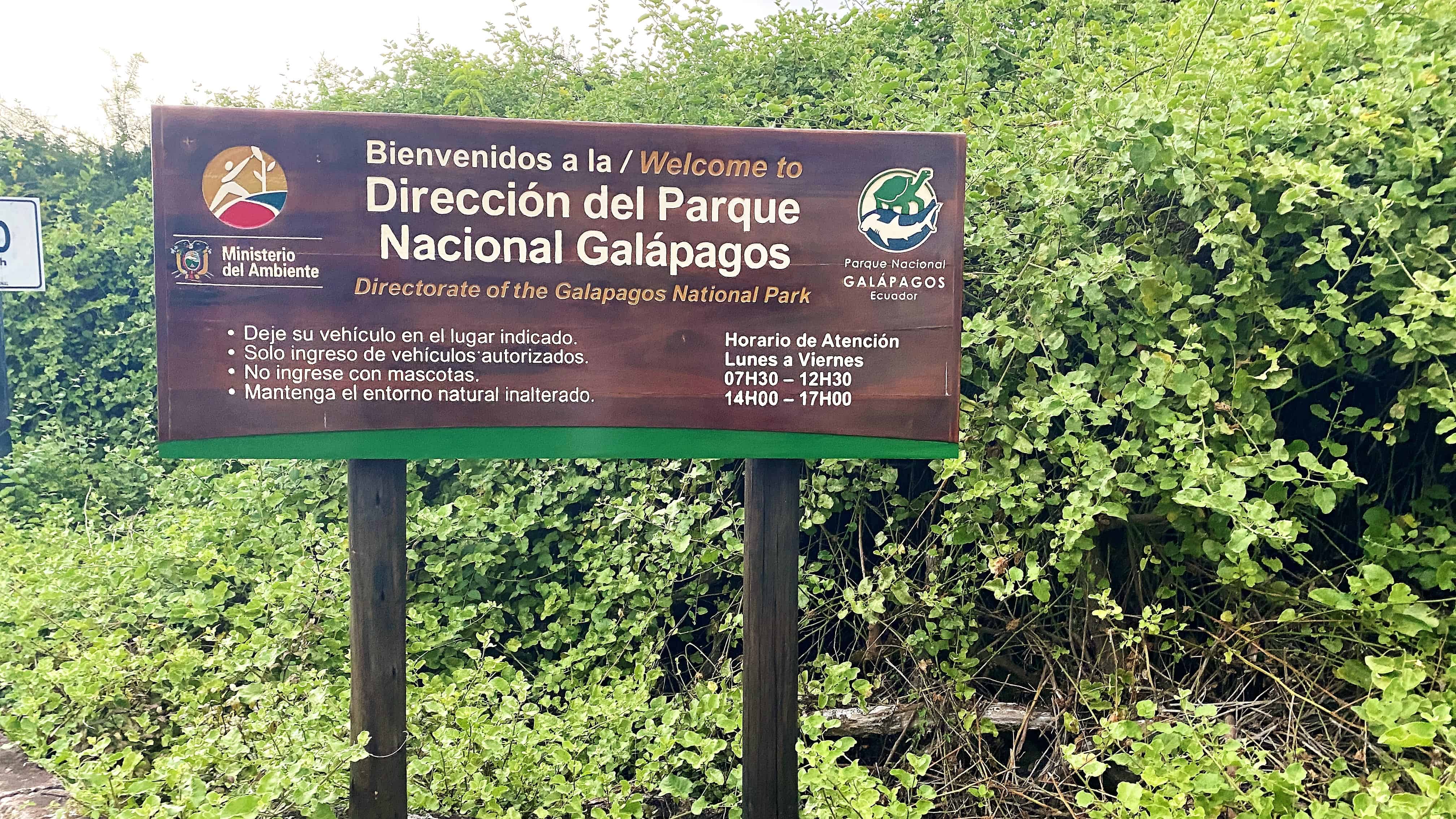
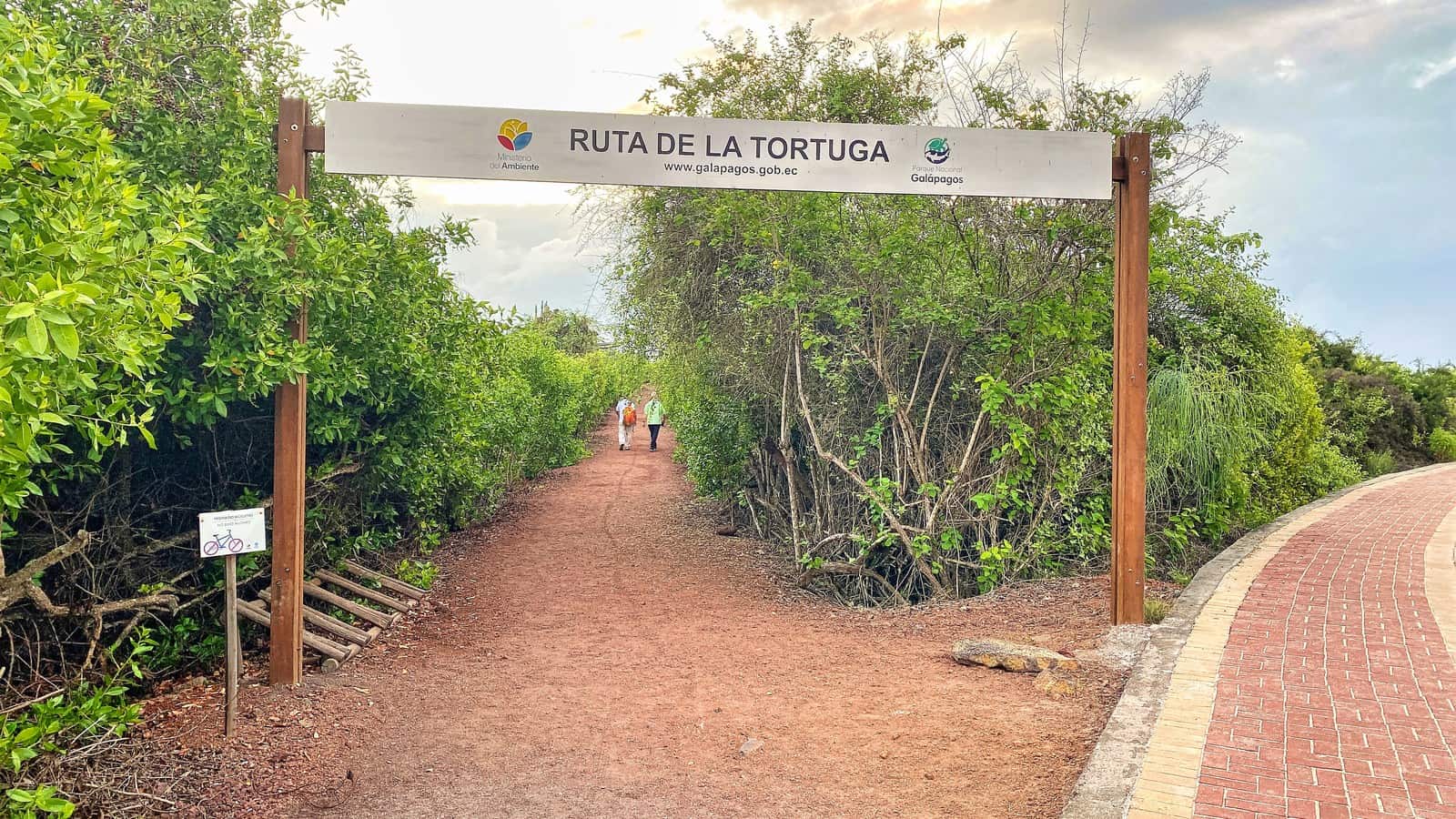
We arrived at the station pre-dawn to see the giant Galapagos Tortoises. It was about a ten-minute walk to the center. The Research Station gives hatchlings a headstart by raising them until they are big enough to survive on their own. Once they reach this age, they are transported to their respective Island. Our guide said that 85% of the hatchlings are reintroduced into the wild and live to a mature age.
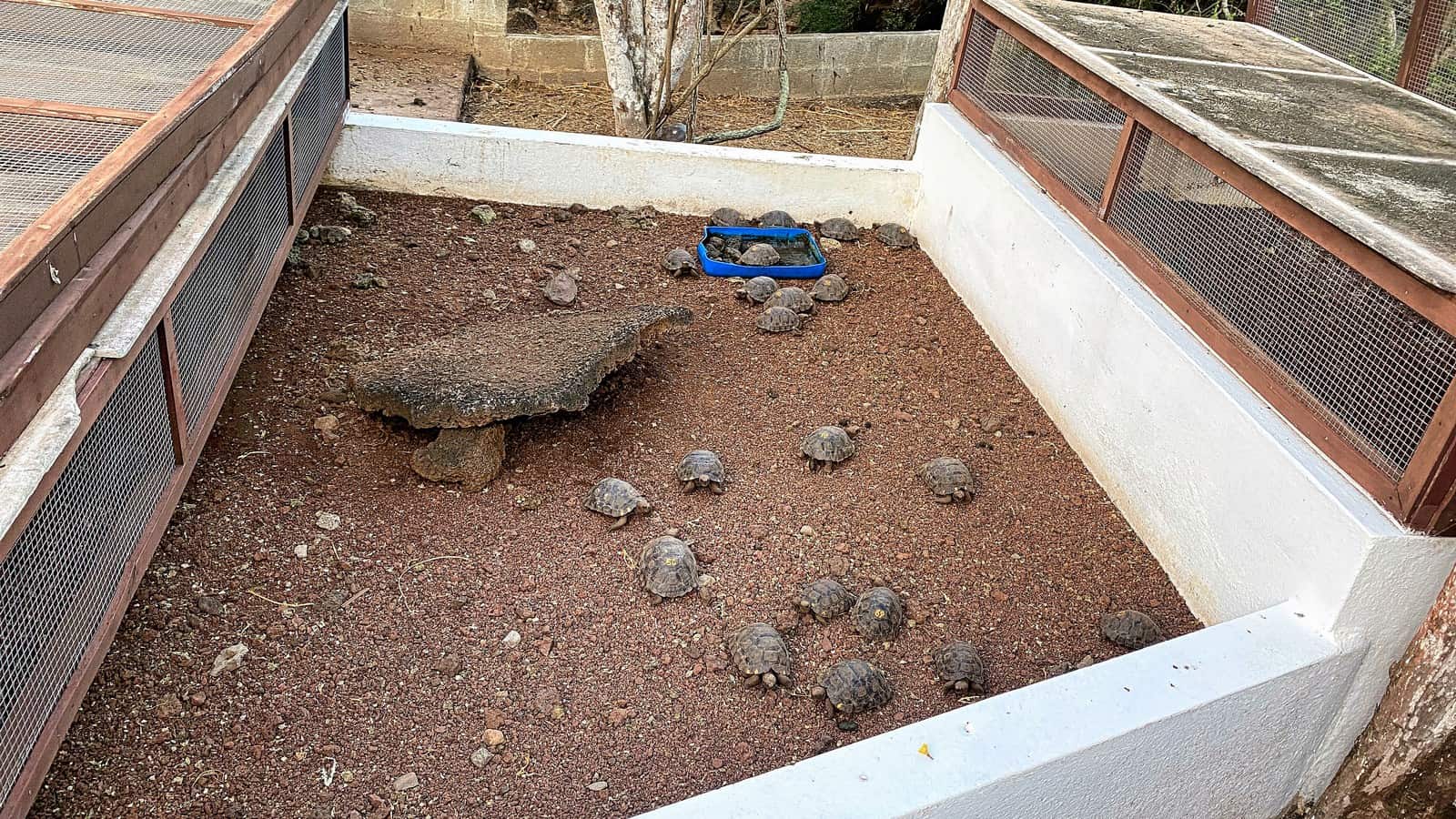
With this in mind, the tortoises live in natural, outdoor, camera protected habitats. And there is a separate habitat for each island species.
Learning About the Galapagos Tortoises
At the research center, we learned that the only predators of Galapagos Tortoises are humans and hawks. Hawks can eat their eggs and the young tortoises. Additionally, we learned that the tortoise’s weight could reach 250 pounds for females and 500 pounds for males. Galapagos Tortoises have thick, sturdy legs to hold up all their weight, but they still spend a lot of time lying down to conserve energy.
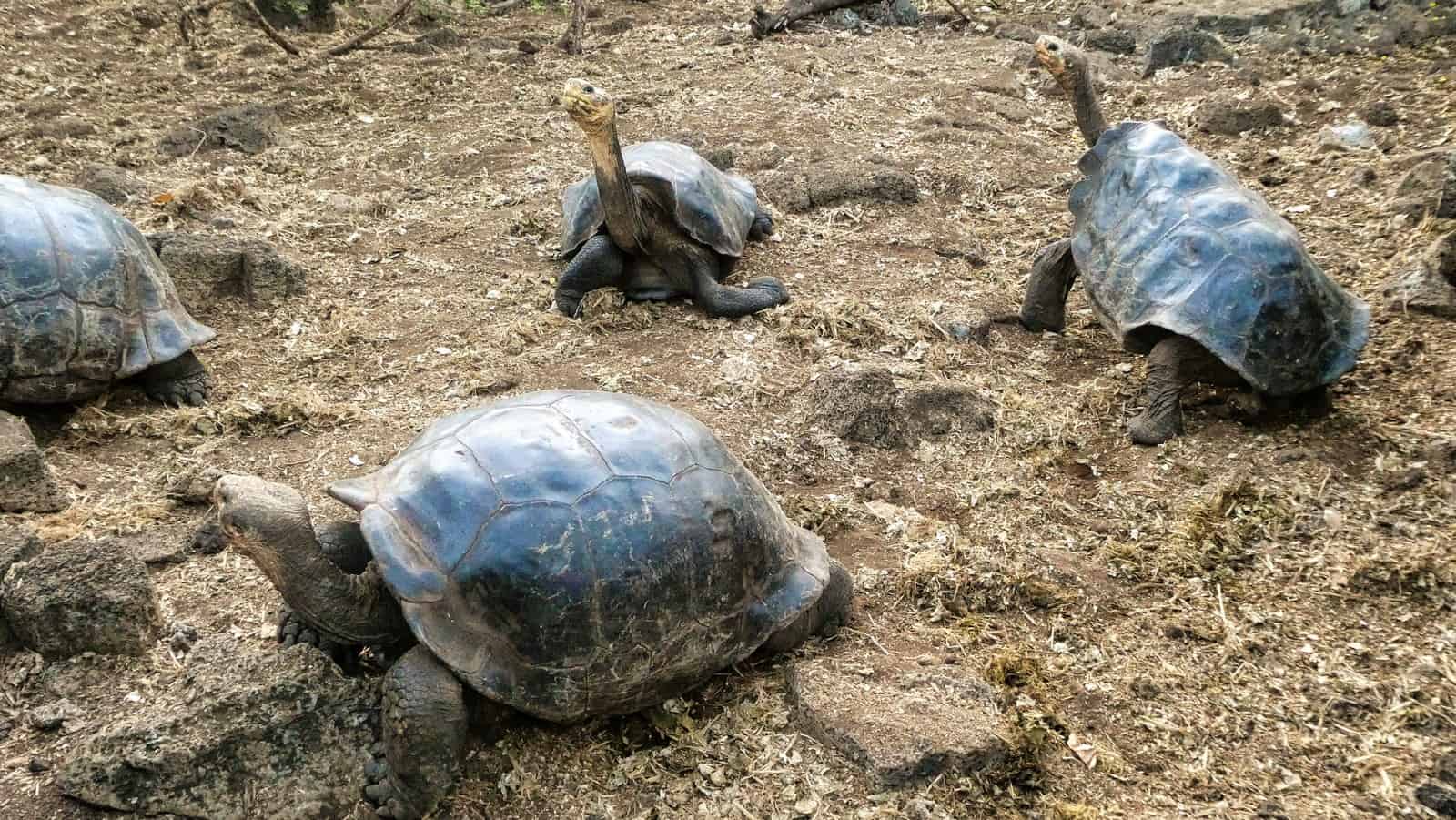
There are two types of Galapagos Tortoises. The first and the largest have big, round shells, and are called domes. Hence the smaller tortoises have shells that curl up in front like a saddle and are called saddlebacks. Galapagos Giant Tortoises keep growing until they reach 40 to 50 years old. And they can live to over 100 years old.
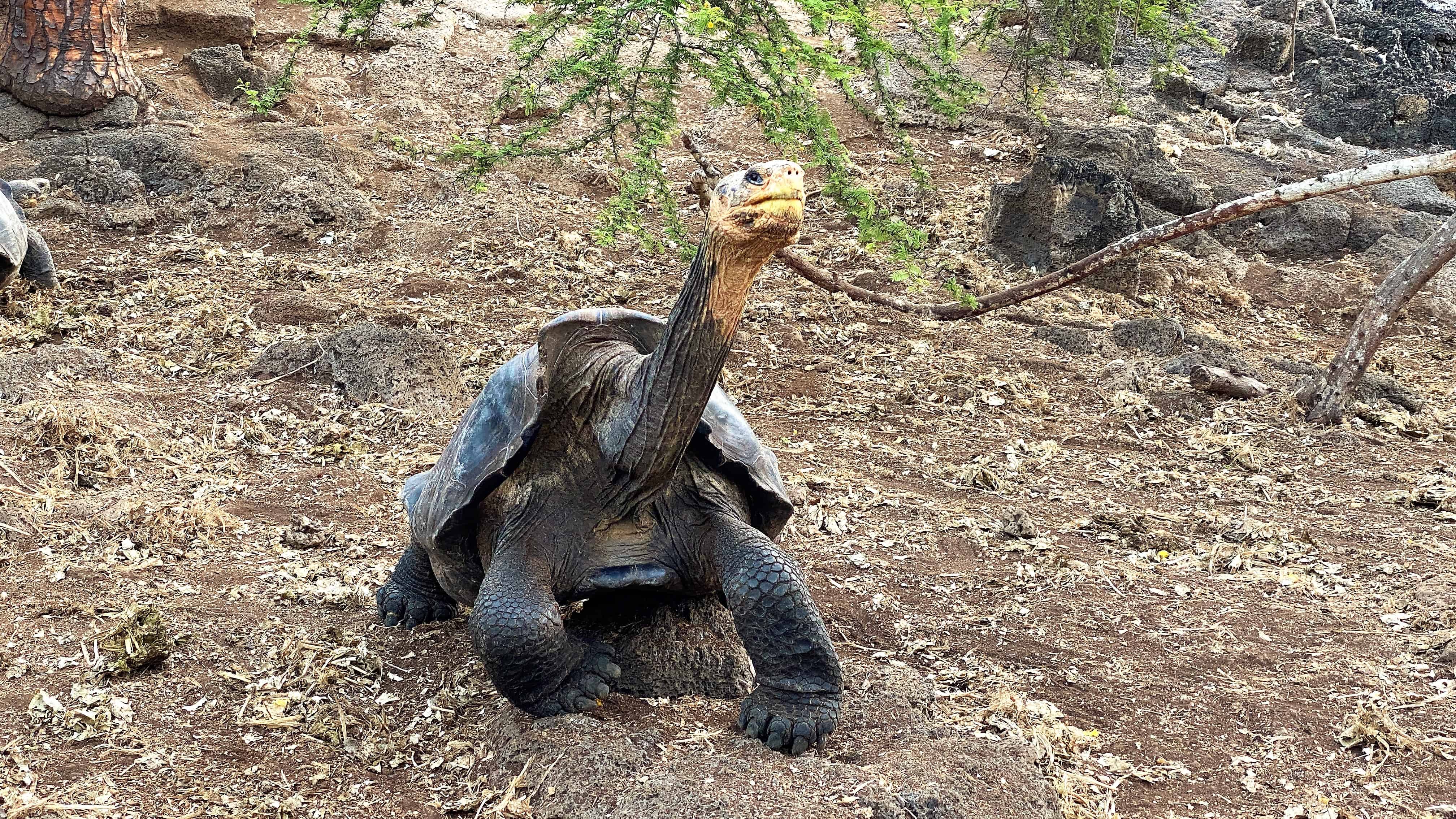
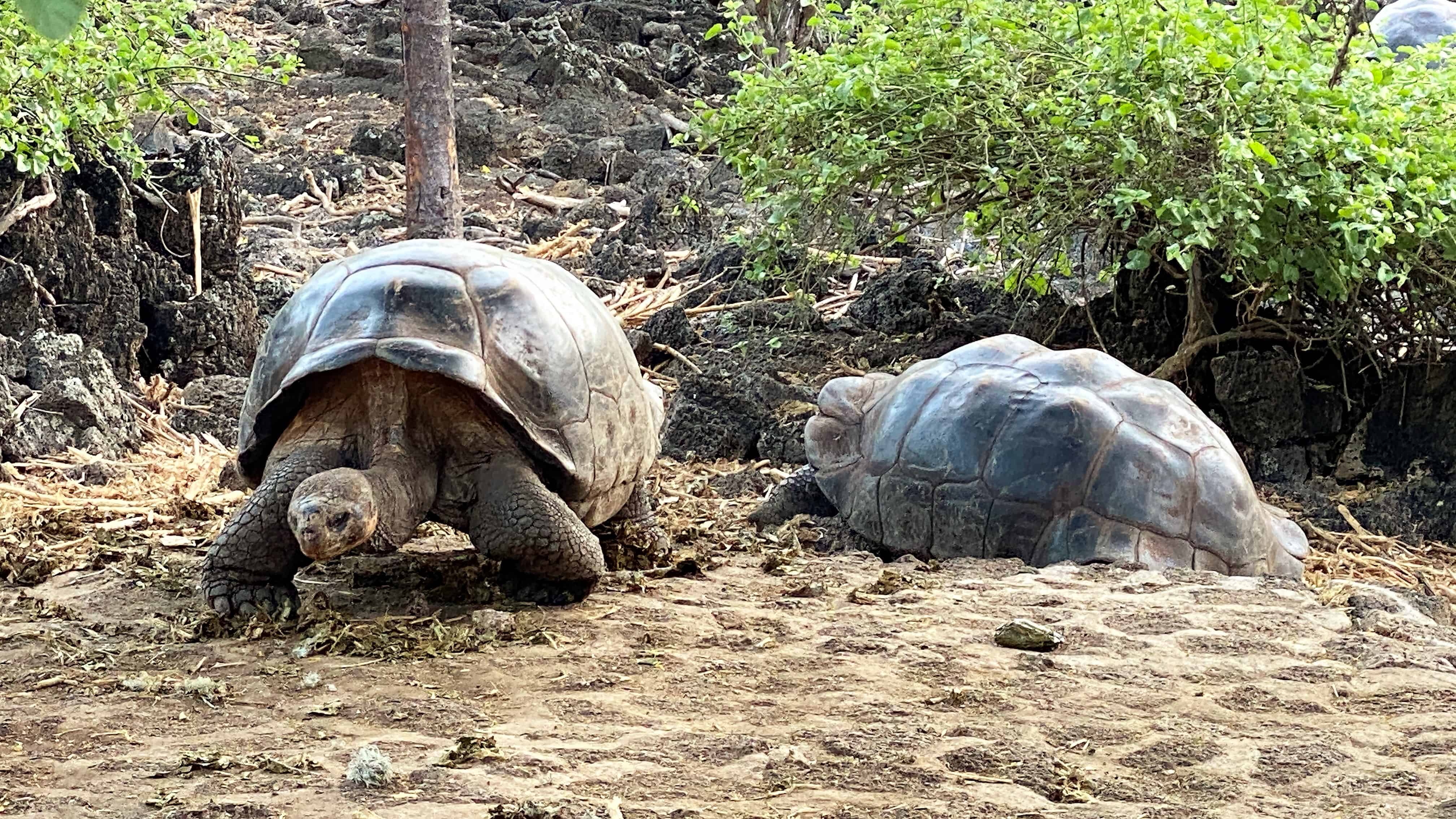
Did you know these reptiles can go without food or water for a year? Sadly, that fact led to their near-extinction, as mariners would take them as an easy source of fresh meat and oil on their long voyages.
When Should you go to the Galapagos?
There really isn’t an optimal time to go to the Galapagos. On our five day cruise, we saw about a third of the islands that can be visited. To see them all, you’d have to do a 15-day cruise. And even then, if you come back during a different season, you’d see different wildlife. That’s what makes the Galapagos so unique and worth multiple visits. While most people consider the Galapagos a once in a lifetime trip, you most certainly can go back during a different season or to different islands and experience new scenery and wildlife.
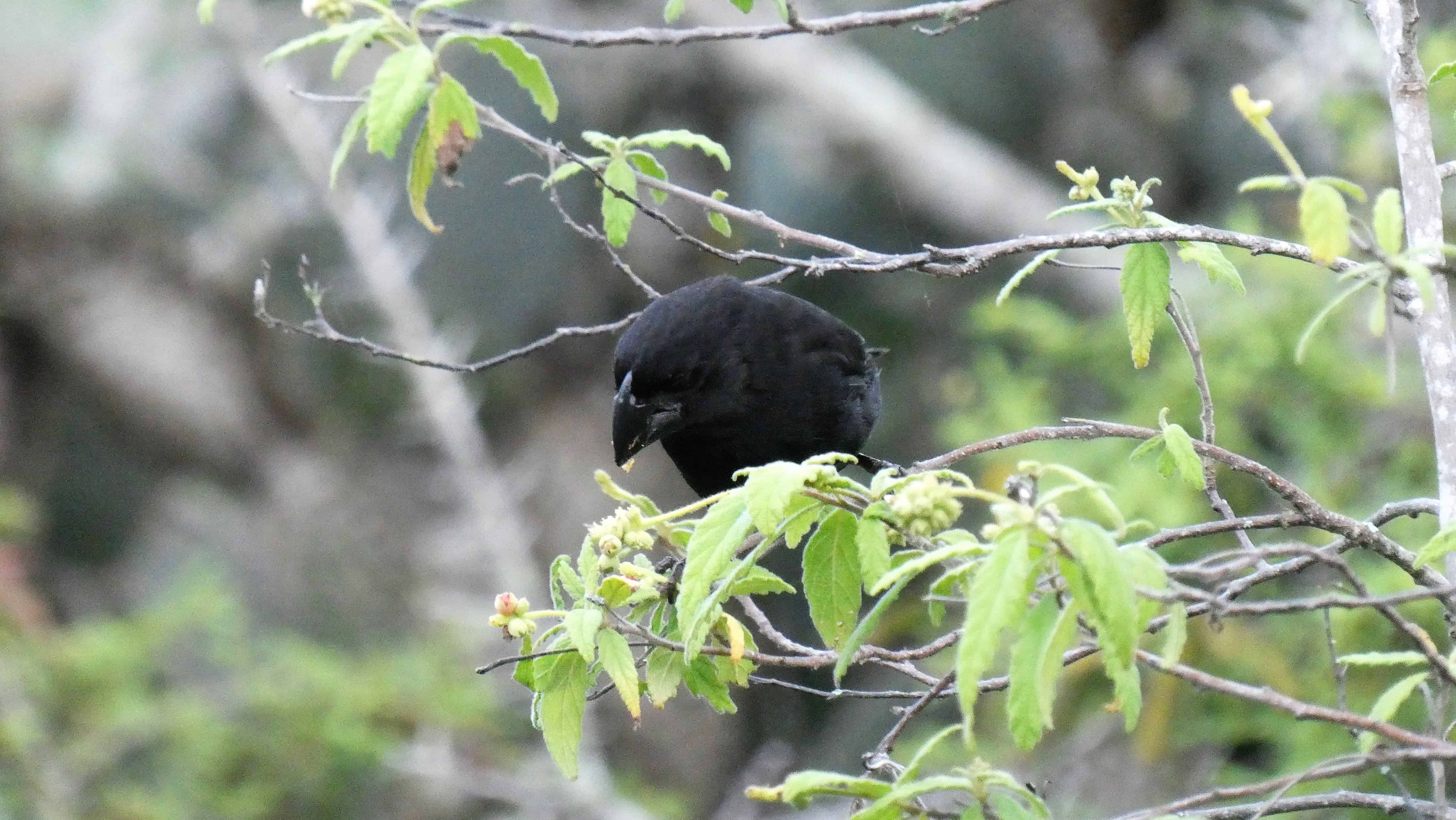
Remember that the Galapagos are below the equator, so the seasons are opposite of North America. You can divide the seasons into two. The hot season is January through May, and the Dry season is June through November. The average air temperature between the two seasons is only about 10 degrees, so it’s not extreme.
If there are specific animals you want to see, then you’ll need to do a little research. Each month has different animal viewing opportunities—for example, sea turtle egg hatching happens between April through June. Humpback whales appear June through September. The Brydes whale and Albatros fledglings leave the nest in December. So, don’t get me wrong; there are plenty of animals to see year-round. But if there’s something specific you want to see, you may want to research to make sure you go at the right time. Each animal has different mating and hatching times that may interest you as well.
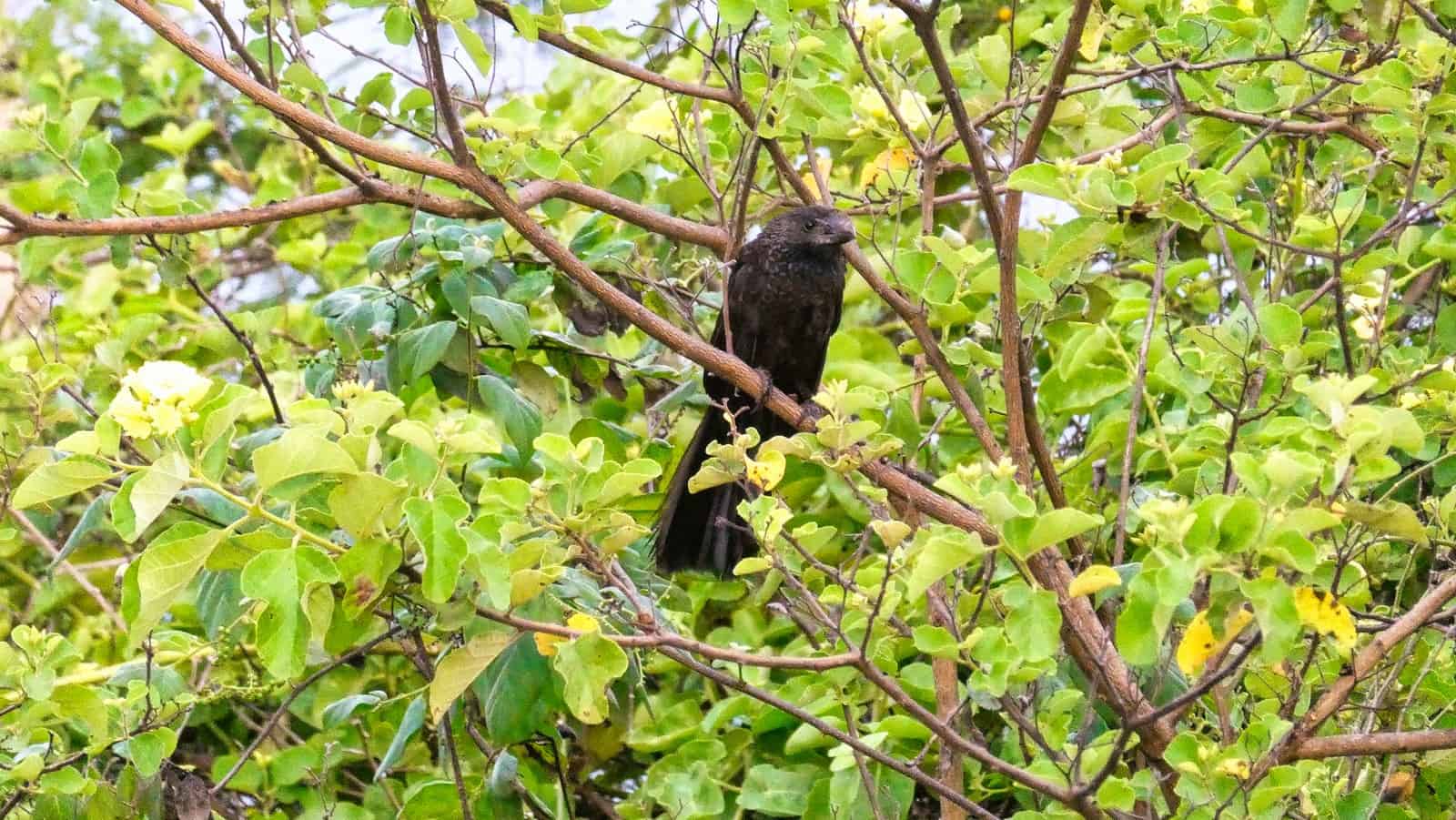
Cruise Versus Land Tours, Which is Best for You?
There are two ways to see the Galapagos, via a cruise or land-based (you book hotels and tours). Unquestionably our goal was to see as much of the Galapagos as we could, including as many of the animal species found on the Galapagos. And to do this, a cruise is the way to go. Some islands are only reachable via a cruise. You get to see so much more because you don’t waste time traveling to the islands on day trips. Most travel on a cruise occurs at night. So when you wake, you’re there and ready to go ashore.
On most cruises, you’ll do two tours a day with a water activity like snorkeling or kayaking in between. Additionally, if you just want to take a break and relax on the ship, you are welcome to stay behind and chill.
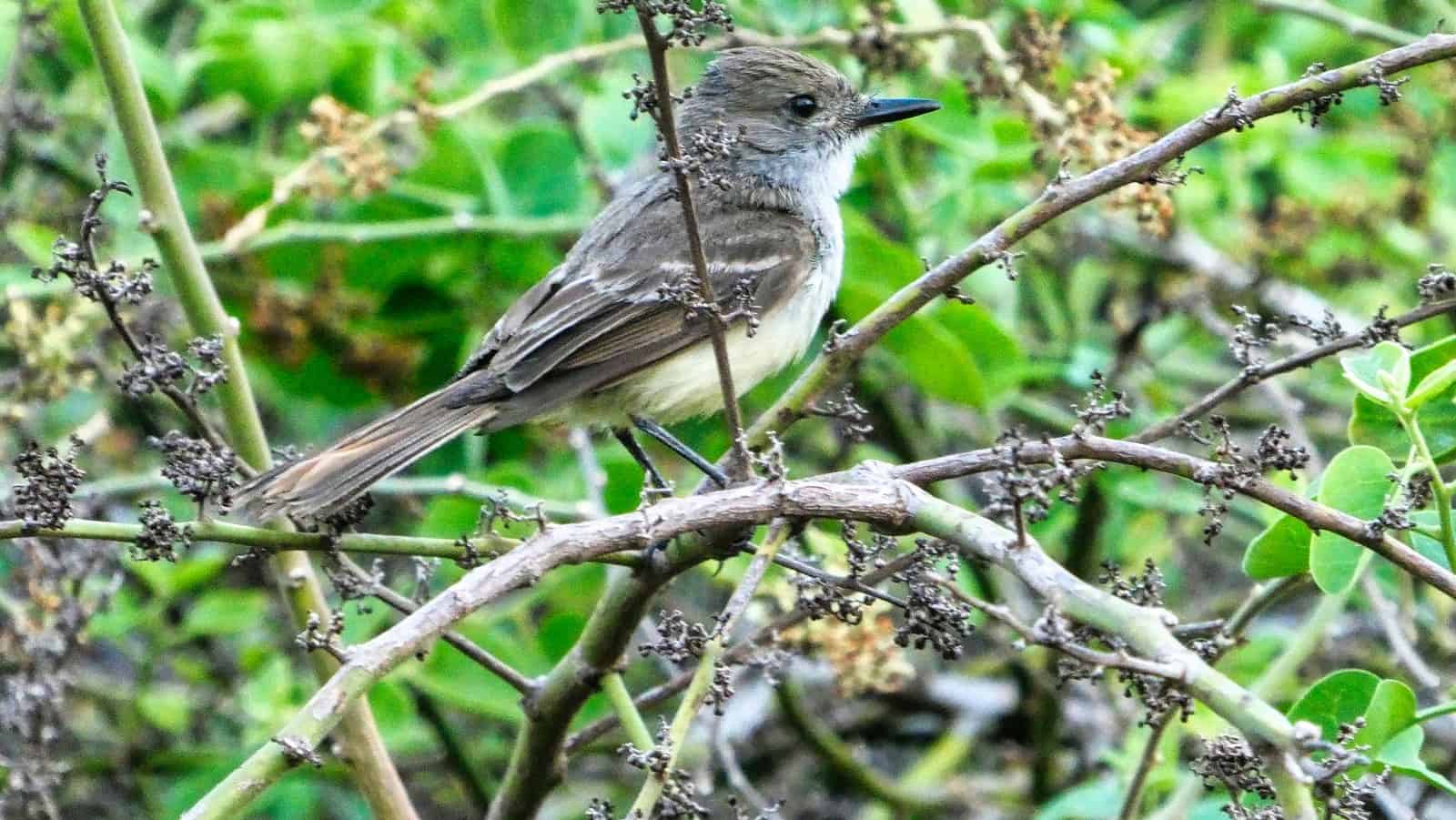
Tight Regulations for Ships
Because the Galapagos is so regulated, each ship has a specific period that they can be on an island. This prevents overcrowding. Never did we think there were too many people at a place. Only a couple times did we ever run into another ship’s passengers. And even then, we’re talking about 20 people, not hundreds.
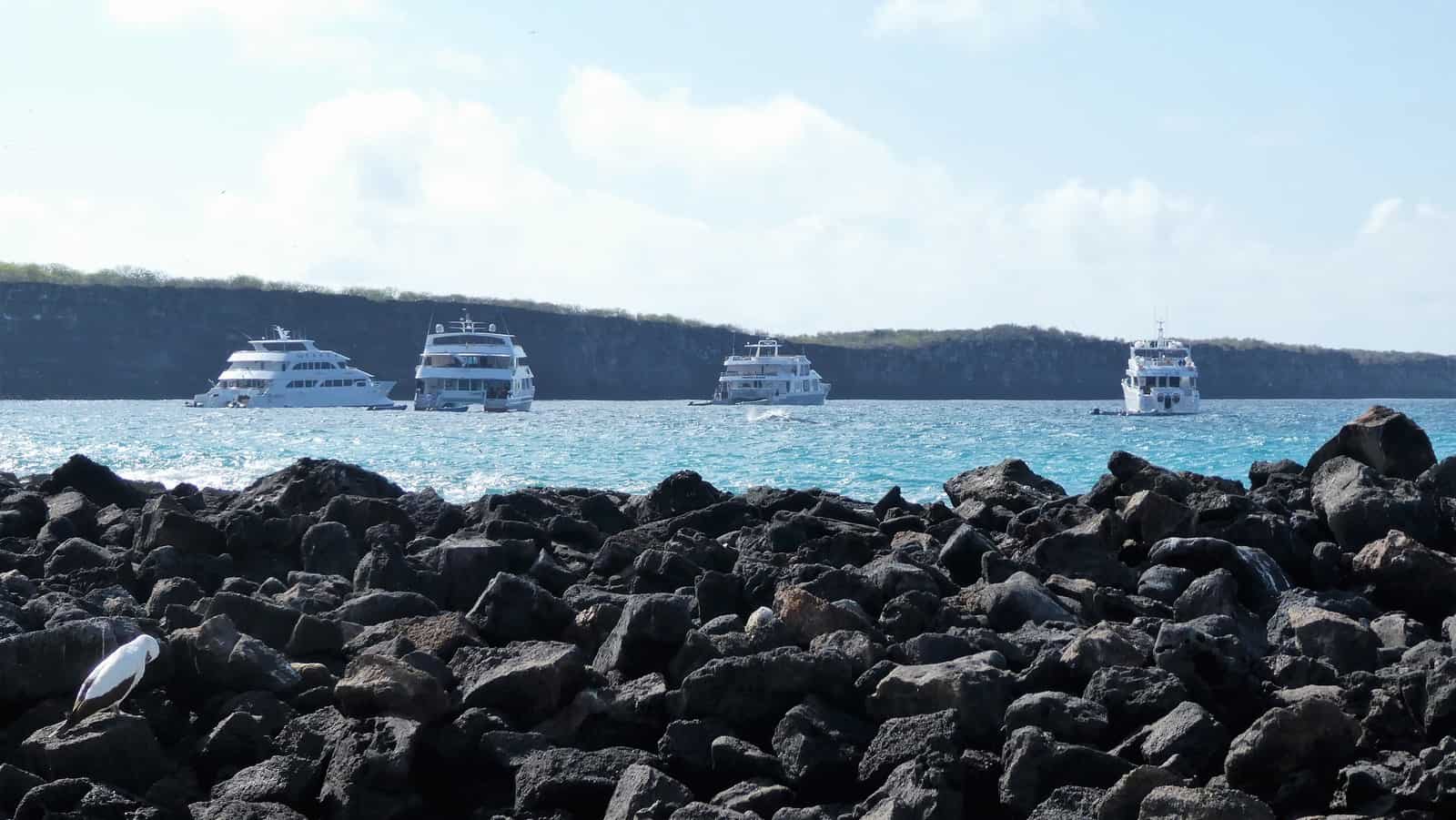
Our feeling was that there is so much to see in the Galapagos, and we wanted to make the most of it, so a cruise was the only way to go. It allowed us to see places only available via a cruise and no wasted time traveling by small boat for hours to an island.
The Galapagos are not just for the young adventurer minded. We had people on our cruise in their 70’s. There was always crew to help you on and off the pangas and on to the islands, so don’t think that might be too difficult. A Galapagos cruise is most certainly an adventure for all ages.
The M/C Alya, The Best Ship For a Galapagos Cruise
The Galapagos islands declared a national park in 1959, and a UNESCO World Heritage Site in 1978 are breathtaking. Most of the wildlife does not fear humans, so the islands are great for wildlife photographers and those of us who just love up-close encounters with animals. After visiting the Galapagos, it’s easy to see the enormous impression that the Galapagos made on the young naturalist, Charles Darwin.
We chose the ship M/C Alya of Galagents Galapagos Cruises. It’s a luxury-class catamaran. Additionally, all of the equipment we would need for swimming or snorkeling, Alyia provided, including wetsuits, masks, and fins. And most important, they provided a certified naturalist who explained everything to us along the way.
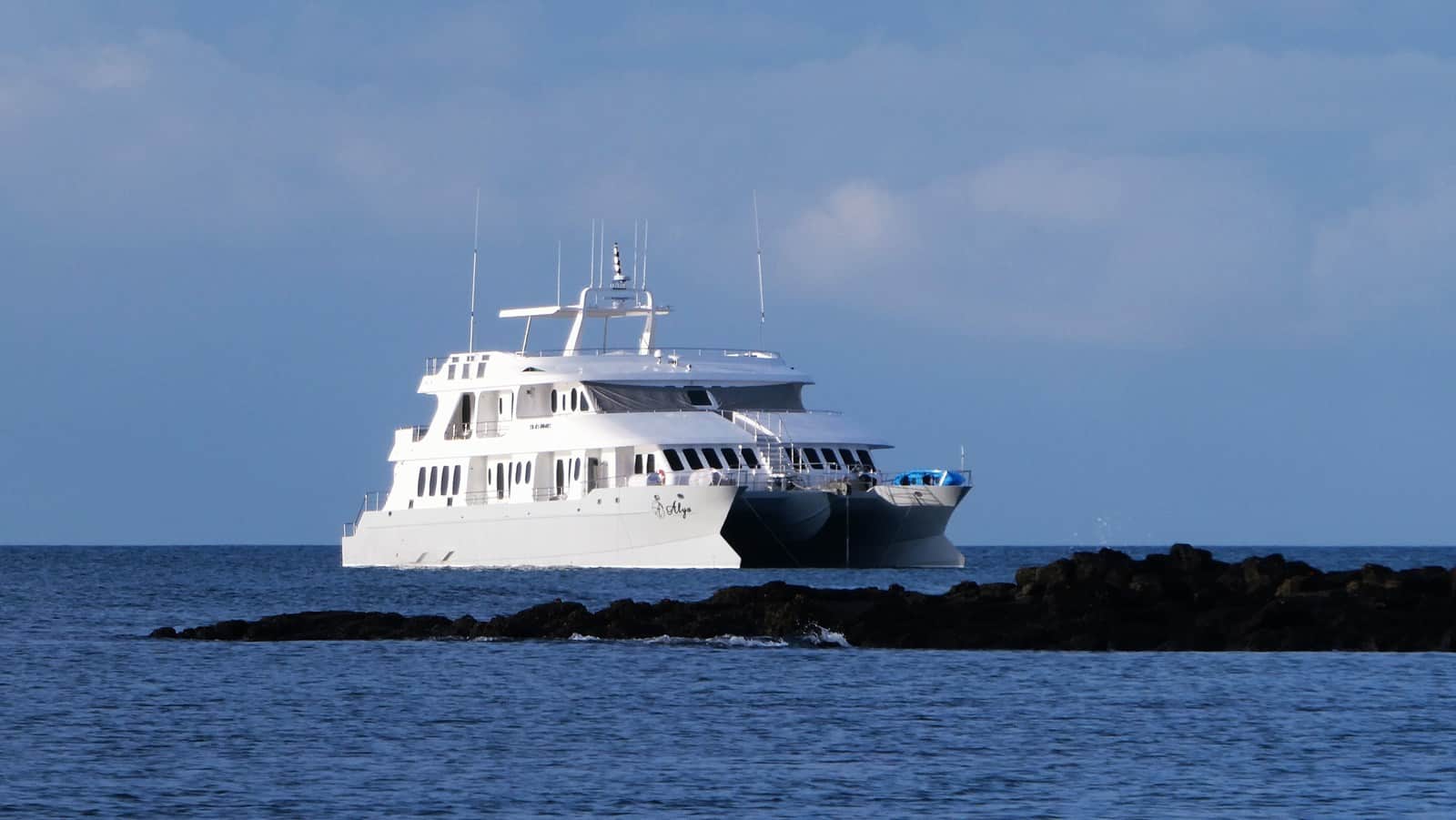
Also, on the M/C Alya, in addition to our large suite, there are two bars with a bartender and fabulous chef-prepared meals three times a day. On the M/C Alya, we had a luxury vacation!
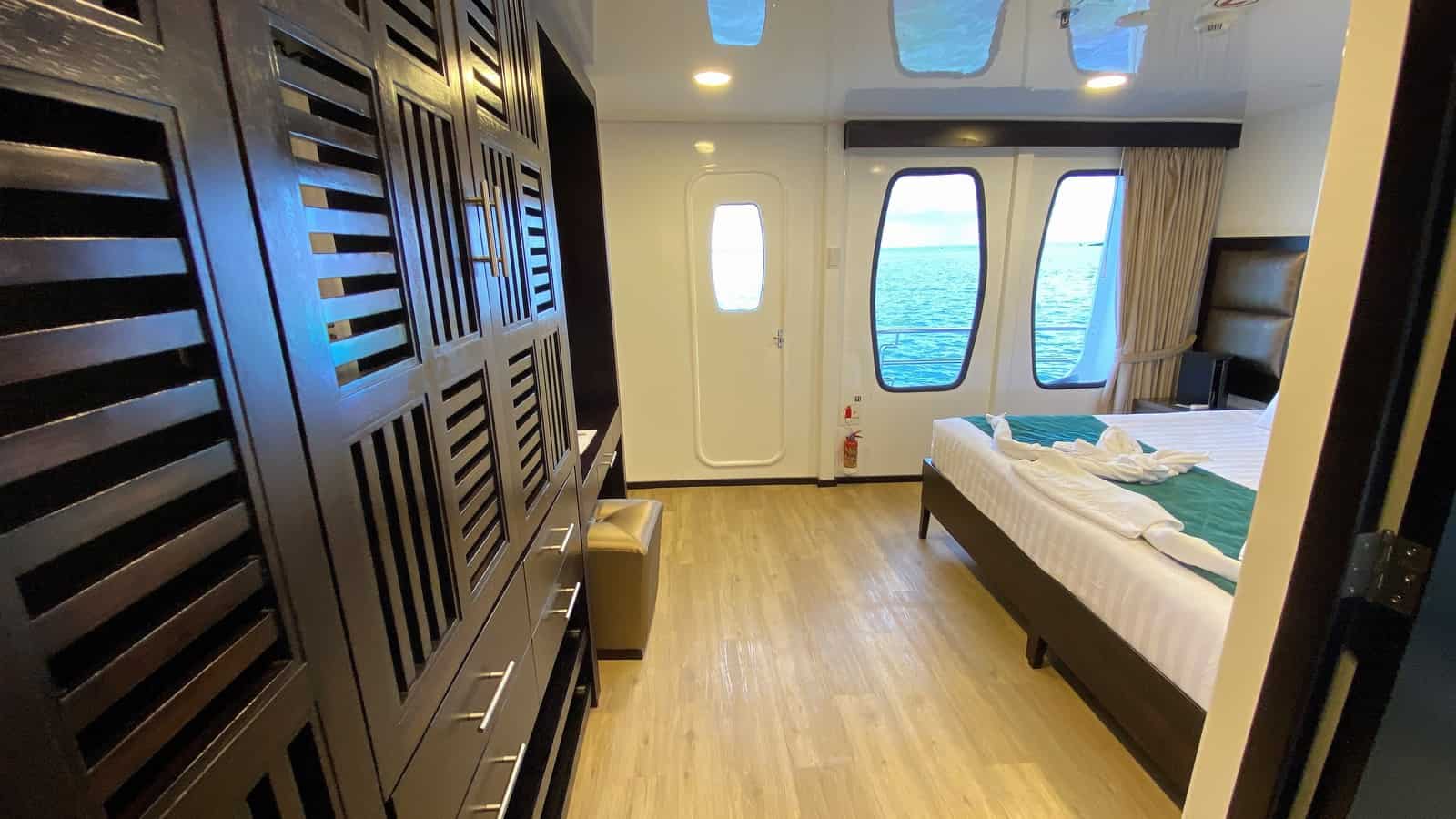
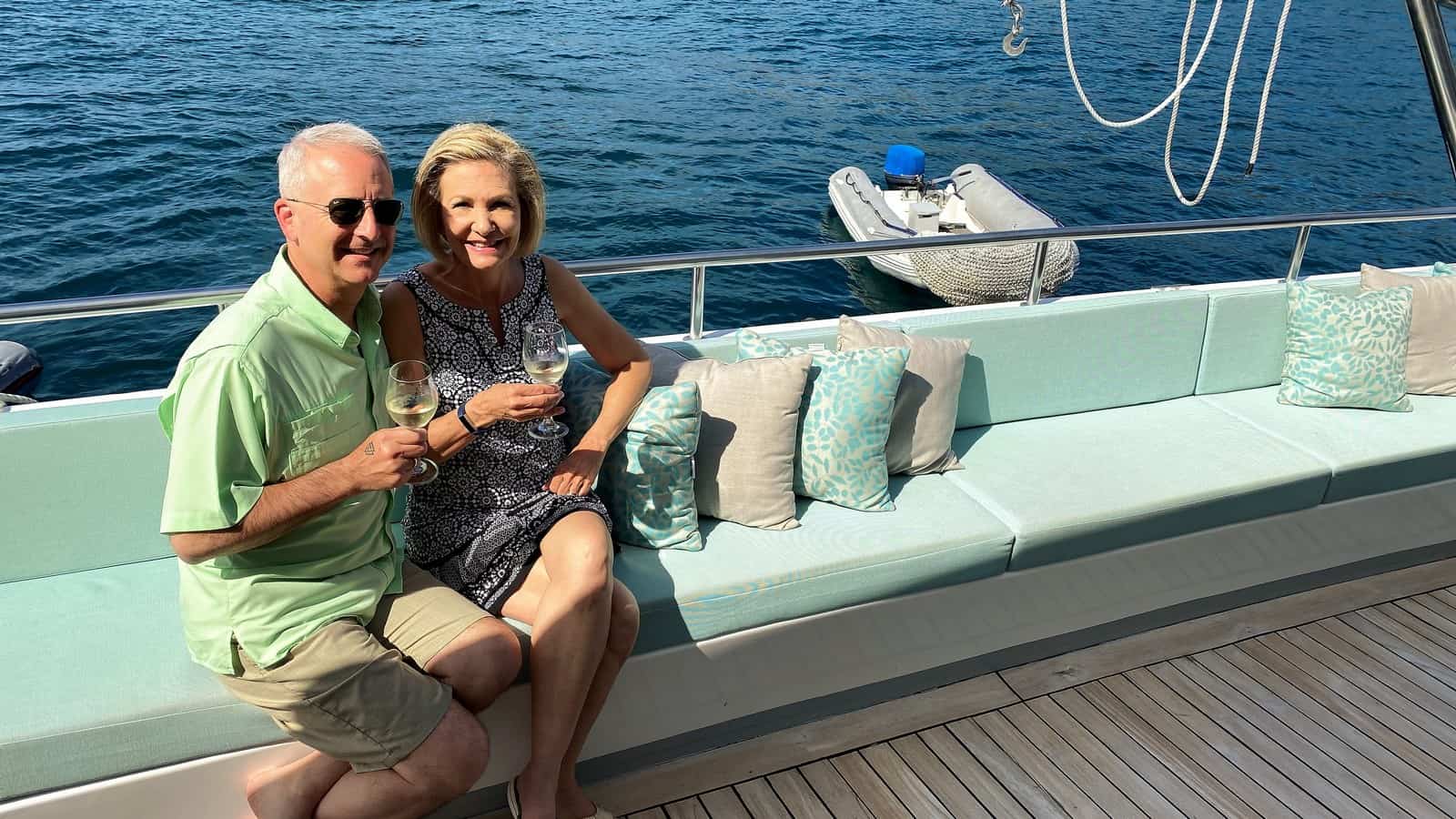
So, if you like small intimate adventure cruises, be sure and read our other cruise, the Amazon river cruise adventure.
QUICK ANSWERS
There are 3 types of Boobies on the Galapagos Islands. The Red-footed Booby, the Blue-footed Booby, and the Nazca Booby.
There are a little over 25,000 full-time residents of the Galapagos Islands.
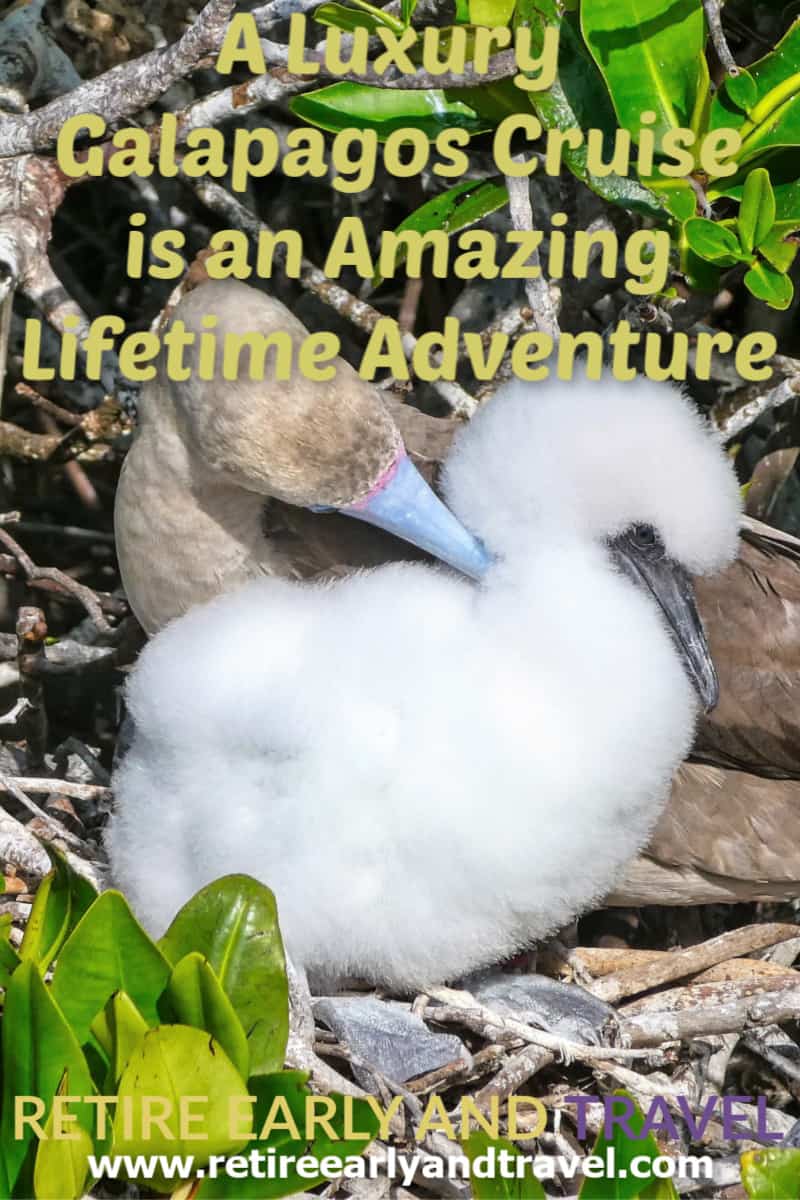
Great post with amazing photos!
AMazing
Thanks for sharing
have a nice day
Thanks for the kudos
Pingback: Influencers on board M/C Alya - Ecuador and Galapagos News
It is truly a nice & useful piece of info. I am glad that you just
shared this useful information with us.
You’re welcome Sanjay. We’re glad you liked it.
Thanks a lot for your nice post and also thanks for giving your time for the post. Great help for me!
You’re welcome Mishra. Thanks for visiting.
Your travel blog is a constant source of inspiration, reminding me of the vast wonders that await us in our travels. Your vivid descriptions and captivating storytelling transport me to a world of endless possibilities. Thank you for fueling my wanderlust and igniting a deep appreciation for the beauty of our planet.